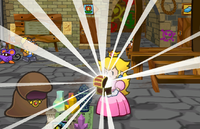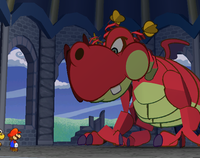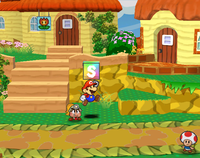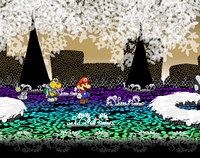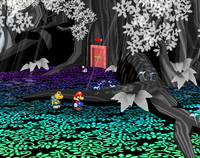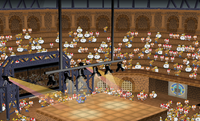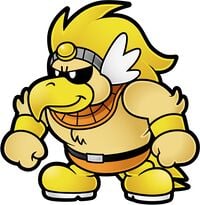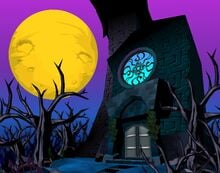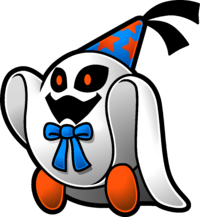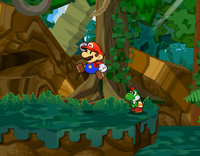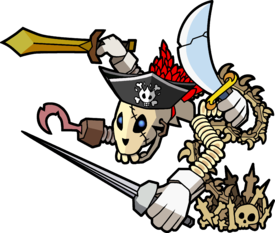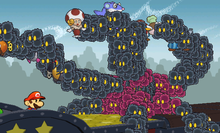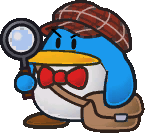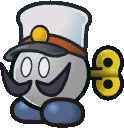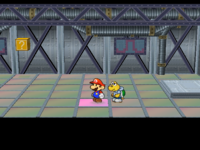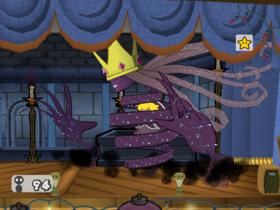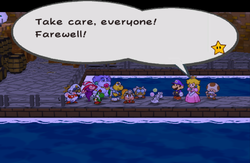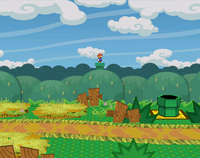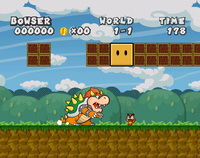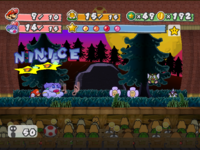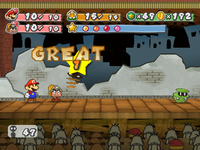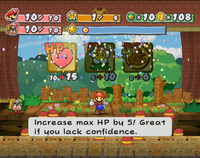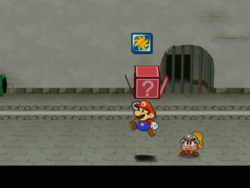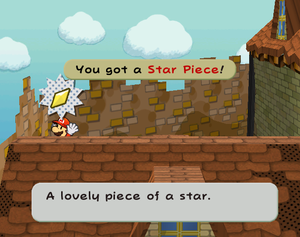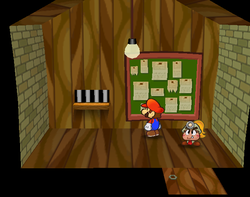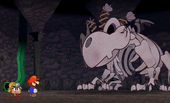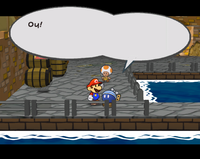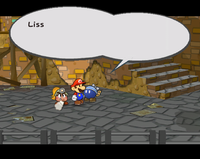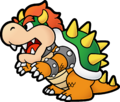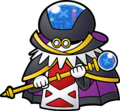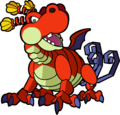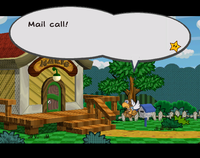User:Pulsebot/sandbox: Difference between revisions
mNo edit summary |
m (Text replacement - "Fra([AE]?M? *)=" to "Fre$1=") |
||
| (48 intermediate revisions by 2 users not shown) | |||
| Line 1: | Line 1: | ||
{{italic title}} | {{italic title}} | ||
{{game infobox | {{game infobox | ||
|image=[[File:PMTTYD.jpg|250px]] | |image=[[File:PMTTYD.jpg|250px]]<br>North American box art | ||
|developer=[[Intelligent Systems]] | |developer=[[Intelligent Systems]] | ||
|publisher=[[Nintendo]] | |publisher=[[Nintendo]] | ||
| Line 14: | Line 11: | ||
|ratings={{ratings|esrb=E|pegi=3|cero=A|acb=PG}} | |ratings={{ratings|esrb=E|pegi=3|cero=A|acb=PG}} | ||
|media={{media|gcn=1}} | |media={{media|gcn=1}} | ||
|input={{input| | |input={{input|gcn=1}} | ||
}} | }} | ||
'''''Paper Mario: The Thousand-Year Door''''' is a [[Genre#role-playing|role-playing]] game and the second installment in the [[Paper Mario (series)|''Paper Mario'' series]]. It was developed by [[Intelligent Systems]] for the [[Nintendo GameCube]] in [[List of games by date#2004|2004]]. | '''''Paper Mario: The Thousand-Year Door''''' is a [[Genre#role-playing|role-playing]] game and the second installment in the [[Paper Mario (series)|''Paper Mario'' series]]. It was developed by [[Intelligent Systems]] for the [[Nintendo GameCube]] in [[List of games by date#2004|2004]]. | ||
The game's plot revolves around [[Mario]], who embarks on a mission to rescue [[Princess Peach]] | The game's plot revolves around [[Mario]], who embarks on a mission to rescue [[Princess Peach]], who was kidnapped by the organization named [[X-Nauts (organization)|X-Nauts]] by stopping them and particularly their leader, [[Sir Grodus]]. In order to do this, Mario and his [[party member|partners]] should collect the seven magical artifacts known as the [[Crystal Stars]] in order to open [[the Thousand-Year Door]], an enormous door which holds a [[Shadow Queen|legendary treasure]] that has a lot of rumors and legends spread about. While being kidnapped, Peach sends Mario various information about the X-Nauts' intentions for the world conquest and [[Bowser]] also tries to collect the Crystal Stars along the way. | ||
Being a | Being a follow-up to ''[[Paper Mario]]'', the game borrows the similar art style and key gameplay elements as obtaining the [[party member]]s to solve puzzles or getting the [[Star Point]]s after winning a battle. However, ''Paper Mario: The Thousand Year-Door'' improves these elements further such as partners having their own health, or obtaining the [[Star Power]] during battle by interacting with the [[Audience]] rather than refilling it automatically. Additionally, the game improves the "paper" aesthetics as well by adding certain elements both in gameplay (such as [[Black Chest Demon#Paper abilities|paper abilities]]) and the game's design in general. | ||
==Plot== | ==Plot== | ||
=== Opening === | === Opening === | ||
| Line 42: | Line 39: | ||
|Ger=Prolog: Willkomen in Rohlingen | |Ger=Prolog: Willkomen in Rohlingen | ||
|GerM=Prologue: Welcome to Rohlingen | |GerM=Prologue: Welcome to Rohlingen | ||
| | |Fre=Prologue: Bienvenue à Port-Lacanaïe! | ||
| | |FreM=Prologue: Welcome to Port-Lacanaïe! | ||
}} | }} | ||
| Line 70: | Line 67: | ||
|Ger=Kapitel 1: Lohgards Drachenburg | |Ger=Kapitel 1: Lohgards Drachenburg | ||
|GerM=Chapter 1: Dragon Lohgard's Castle<br>(''Lohgard'' is [[Hooktail]]'s German name.) | |GerM=Chapter 1: Dragon Lohgard's Castle<br>(''Lohgard'' is [[Hooktail]]'s German name.) | ||
| | |Fre=Chapitre 1: Mario + château + dragon | ||
| | |FreM=Chapter 1: Mario + castle + dragon | ||
}} | }} | ||
| Line 100: | Line 97: | ||
|Ger=Kapitel 2: Der Baum der Bubus | |Ger=Kapitel 2: Der Baum der Bubus | ||
|GerM=Chapter 2: The tree of the Bubus<br>(''Bubu'' is the German name for the [[Puni|Punies]].) | |GerM=Chapter 2: The tree of the Bubus<br>(''Bubu'' is the German name for the [[Puni|Punies]].) | ||
| | |Fre=Chapitre 2: Un grand arbre | ||
| | |FreM=Chapter 2: A great tree | ||
}} | }} | ||
| Line 128: | Line 125: | ||
|Ger=Kapitel 3: Kampf der Champions | |Ger=Kapitel 3: Kampf der Champions | ||
|GerM=Chapter 3: Clash of the Champions | |GerM=Chapter 3: Clash of the Champions | ||
| | |Fre=Chapitre 3: Vas-y champion! | ||
| | |FreM=Chapter 3: Go champion! | ||
}} | }} | ||
| Line 161: | Line 158: | ||
|Ger=Kapitel 4: Die Glocke der Spukabtei | |Ger=Kapitel 4: Die Glocke der Spukabtei | ||
|GerM=Chapter 4: The bell of the Spook Abbey | |GerM=Chapter 4: The bell of the Spook Abbey | ||
| | |Fre=Chapitre 4: La cloche à cochons | ||
| | |FreM=Chapter 4: The pig bell | ||
}} | }} | ||
| Line 188: | Line 185: | ||
|Ger=Kapitel 5: Der Schatz des Piraten | |Ger=Kapitel 5: Der Schatz des Piraten | ||
|GerM=Chapter 5: The pirate's treasure | |GerM=Chapter 5: The pirate's treasure | ||
| | |Fre=Chapitre 5: Pirate de Tropatroce | ||
| | |FreM=Chapter 5: Pirate of Tropatroce | ||
}} | }} | ||
| Line 221: | Line 218: | ||
|Ger=Kapitel 6: Reise im Glimmer-Liner | |Ger=Kapitel 6: Reise im Glimmer-Liner | ||
|GerM=Chapter 6: Travel in the Excess Express | |GerM=Chapter 6: Travel in the Excess Express | ||
| | |Fre=Chapitre 6: Dans le Crésus Express! | ||
| | |FreM=Chapter 6: On the Crésus Express! | ||
}} | }} | ||
| Line 249: | Line 246: | ||
|Ger=Kapitel 7: Der Weg zum Mond | |Ger=Kapitel 7: Der Weg zum Mond | ||
|GerM=Chapter 7: The Way to the Moon | |GerM=Chapter 7: The Way to the Moon | ||
| | |Fre=Chapitre 7: Voyage sur la Lune | ||
| | |FreM=Chapter 7: Journey to the Moon | ||
}} | }} | ||
| Line 271: | Line 268: | ||
|Ger=Kapitel 8: Die Legende vom Schatz | |Ger=Kapitel 8: Die Legende vom Schatz | ||
|GerM=Chapter 8: The treasure's legend | |GerM=Chapter 8: The treasure's legend | ||
| | |Fre=Chapitre 8: Le trésor légendaire | ||
| | |FreM=Chapter 8: The legendary treasure | ||
}} | }} | ||
==Gameplay== | ==Gameplay== | ||
[[File:The Koopa fan of Peach in Petalburg PMTTYD.png|thumb| | [[File:The Koopa fan of Peach in Petalburg PMTTYD.png|thumb|right|Mario, his party member [[Goombella]] and a [[Koopa Troopa]] NPC.]] | ||
In terms of gameplay, ''Paper Mario: The Thousand-Year Door'' brings over the core mechanics of the game's [[Paper Mario|prequel]] and enhances them further. [[Mario]] now can speak when performing moves as [[jump]]ing or collecting different items, and starts his adventure with a [[Hammer]]. [[Action Command]]s can also be performed initially, while in ''Paper Mario'' a [[Lucky Star]] must be collected, however, Mario has lost the ability to [[Spin Dash]] from the original game. | In terms of gameplay, ''Paper Mario: The Thousand-Year Door'' brings over the core mechanics of the game's [[Paper Mario|prequel]] and enhances them further. [[Mario]] now can speak when performing moves as [[jump]]ing or collecting different items, and starts his adventure with a [[Hammer]]. [[Action Command]]s can also be performed initially, while in ''Paper Mario'' a [[Lucky Star]] must be collected, however, Mario has lost the ability to [[Spin Dash]] from the original game. | ||
For the most part of the game, the player takes control of Mario, who goes to various locations from the [[Rogueport]], which replaces [[Toad Town]]'s role as a hub from the prequel. The game is divided into chapters with an each one being set in an unique area, many of which contain NPCs (non-playable characters who can be interracted with) or/and enemies, some of the former can provide Mario and his partners with certain services, such as [[Merlon]]. | For the most part of the game, the player takes control of Mario, who goes to various locations from the [[Rogueport]], which replaces [[Toad Town]]'s role as a hub from the prequel. The game is divided into chapters with an each one being set in an unique area, many of which contain NPCs (non-playable characters who can be interracted with) or/and enemies, some of the former can provide Mario and his partners with certain services, such as [[Merlon]]. | ||
On Mario's way, he and his partners use various techniques that help them progress in adventure: Mario can reach blocks above his head, come across the gaps and getting himself to the higher areas by using the Jump move, while the Hammer is used for destroying various obstacles as [[Yellow Block]]s. Progressively, player expands the Boots and the Hammer by getting upgrades that allow the player to perform new abilities, as [[Super Boots|breaking the | On Mario's way, he and his partners use various techniques that help them progress in adventure: Mario can reach blocks above his head, come across the gaps and getting himself to the higher areas by using the Jump move, while the Hammer is used for destroying various obstacles as [[Yellow Block]]s. Progressively, player expands the Boots and the Hammer by getting upgrades that allow the player to perform new abilities, as [[Super Boots|breaking the panels that are below Mario]] or [[Super Hammer|destroying the gigantic Yellow Blocks]]. | ||
<!-- | <!-- | ||
The partner system is also enhanced. Unlike the original, where partners had a simple fine/injured status system, this game gives partners their own Heart Points. As such, partners can fall in battle, and items such as the Mushroom can be used on them as well. Several partners are similar to ones seen in ''Paper Mario'', like [[Koops]] being the counterpart of [[Kooper]], but generally have more abilities available. Timed moves are more abundant in this game. In addition, battles are set up on a stage, like a play; this greatly affects battles, and characters can interact with the audience and stage.--> | The partner system is also enhanced. Unlike the original, where partners had a simple fine/injured status system, this game gives partners their own Heart Points. As such, partners can fall in battle, and items such as the Mushroom can be used on them as well. Several partners are similar to ones seen in ''Paper Mario'', like [[Koops]] being the counterpart of [[Kooper]], but generally have more abilities available. Timed moves are more abundant in this game. In addition, battles are set up on a stage, like a play; this greatly affects battles, and characters can interact with the audience and stage.--> | ||
===Background=== | ===Background=== | ||
[[File:PMTTYD Background.png|thumb|Mario wandering around in the background scenery.]] | [[File:PMTTYD Background.png|thumb|left|Mario wandering around in the background scenery.]] | ||
Another element introduced in ''Paper Mario: The Thousand-Year Door'' is the background scenery, which is actually accessible for Mario through certain pipes. Several places which only appear in the background can be visited this way, some of which are larger areas when interacted with. This feature was carried over to the next game in the series, ''[[Super Paper Mario]]''. Certain abilities are disabled here, however: Mario's partners cannot be used in the background, Mario cannot move to a different screen/area, and he also cannot walk past any houses or locations. | Another element introduced in ''Paper Mario: The Thousand-Year Door'' is the background scenery, which is actually accessible for Mario through certain pipes. Several places which only appear in the background can be visited this way, some of which are larger areas when interacted with. This feature was carried over to the next game in the series, ''[[Super Paper Mario]]''. Certain abilities are disabled here, however: Mario's partners cannot be used in the background, Mario cannot move to a different screen/area, and he also cannot walk past any houses or locations. | ||
===Intermissions=== | ===Intermissions=== | ||
[[File:PMTTYD Bowser intermission.png|thumb| | [[File:PMTTYD Bowser intermission.png|thumb|right|Bowser in a platformer level.]] | ||
After each chapter, there is an intermission where the player is able to control [[Princess Peach]], who is held captive in the [[X-Naut Fortress]] until the chapter 7. The Peach intermission is followed by a [[Bowser]] intermission, a new addition in ''Paper Mario: The Thousand-Year Door''. Bowser usually visits the places Mario has been to one chapter before, and several missions include a side-scrolling platformer level in the style of ''[[Super Mario Bros.]]'' after completing the second, fourth and the sixth chapters. In these levels, Bowser has the ability to [[Fire Breath|breathe fire]], and by using the only available item, | After each chapter, there is an intermission where the player is able to control [[Princess Peach]], who is held captive in the [[X-Naut Fortress]] until the chapter 7. The Peach intermission is followed by a [[Bowser]] intermission, a new addition in ''Paper Mario: The Thousand-Year Door''. Bowser usually visits the places Mario has been to one chapter before, and several missions include a side-scrolling platformer level in the style of ''[[Super Mario Bros.]]'' after completing the second, fourth and the sixth chapters. In these levels, Bowser has the ability to [[Fire Breath|breathe fire]], and by using the only available item, [[Meat]], is able to radically increase his size, allowing him to crush everything in his way if collecting enough of it. While enemies like the [[X-Naut]]s charge at Bowser, others like [[Goomba]]s turn away when he approaches them. The levels are called 1-X, 2-X and 3-X in reference to the world numbering of ''Super Mario Bros.'', while X stands for the number of tries Bowser has used for the level. He has endless lives for the levels. They are set in the three basic terrains of ''Super Mario Bros.'': Overworld, Underwater and Underground/Castle. | ||
=== Controls === | |||
{| | |||
|style="vertical-align:top;"| | |||
'''Overworld''' | |||
*{{button|gcn|Stick}} – Move | |||
*{{button|gcn|A}} – Jump / Talk / Investigate | |||
*{{button|gcn|B}} – Hammer / Cancel | |||
*{{button|gcn|Z}} – Open Stats | |||
*{{button|gcn|X}} – Use Party Member ability | |||
*{{button|gcn|Pad}} (Left) – Open Party section | |||
*{{button|gcn|Pad}} (Up) – Open Gear section | |||
*{{button|gcn|Pad}} (Right) – Open Badge section | |||
*{{button|gcn|Pad}} (Down) – Open Journey section | |||
*{{button|gcn|Start}} – Open game menu | |||
|style="vertical-align:top;"| | |||
'''Menu''' | |||
*{{button|gcn|Stick}} / {{button|gcn|Pad}} – Move cursor | |||
*{{button|gcn|A}} – Confirm / Select | |||
*{{button|gcn|B}} – Cancel / Exit | |||
*{{button|gcn|C}} – Scroll the text | |||
*{{button|gcn|Start}} – Close menu | |||
|style="vertical-align:top;"| | |||
'''Battle''' | |||
*{{button|gcn|Stick}} – Move cursor | |||
*{{button|gcn|A}} – Confirm / Guard | |||
*{{button|gcn|B}} – Cancel / Superguard | |||
*{{button|gcn|Y}} – Change attack order | |||
*{{button|gcn|X}} – Hit an Audience member | |||
|style="vertical-align:top;"| | |||
'''As Princess Peach''' | |||
*{{button|gcn|Stick}} – Move | |||
*{{button|gcn|A}} – Talk / Investigate | |||
*{{button|gcn|B}} – Cancel | |||
|style="vertical-align:top;"| | |||
'''As Bowser''' | |||
*{{button|gcn|Stick}} – Move | |||
*{{button|gcn|A}} – Investigate / Talk / Jump (only during the intermissions) | |||
*{{button|gcn|B}} – Cancel / Breathe Fire | |||
|} | |||
=== Mario's stats === | |||
{|width=95% class="wikitable" style="text-align:center;" | |||
|- | |||
!width=15%| | |||
!width=15%|Stat | |||
!width=7%|Initial value | |||
!width=7%|Minimal value | |||
!width=7%|Max value | |||
!Purpose and function | |||
|- | |||
|rowspan=10|[[File:PMTTYD Mario Idle Sprite.png]]<br>[[File:PMTTYD Mario Menu Icon.png|link=Mario|80px]] | |||
|[[File:PMTTYD Mario Level Icon.png|26px]] Level | |||
|1 | |||
|1 | |||
|99 | |||
|style="text-align:left;"|Indicate Mario's progress. With an each upgrade, the player can choose a stat to increase among their HP, FP or BP. | |||
|- | |||
|style="text-align:center;"|[[File:Heart Point.png|26px]] [[Heart Point]]s | |||
|10 | |||
|5{{footnote|note|1}} | |||
|200 | |||
|style="text-align:left;"|The number of Mario's health points. If it reaches zero, Mario [[Game Over|will faint]]. | |||
|- | |||
|style="text-align:center;"|[[File:Flower Point.png|26px]] [[Flower Point]]s | |||
|5 | |||
|5 | |||
|200 | |||
|style="text-align:left;"|Let Mario and his partners use more effective attacks. | |||
|- | |||
|style="text-align:center;"|[[File:BadgePointPM2.png|26px]] [[Badge Point]]s | |||
|3 | |||
|3 | |||
|99 | |||
|style="text-align:left;"|Show which and how many [[Badge]]s Mario can equip. | |||
|- | |||
|style="text-align:center;"|(image_missing) [[Star Power]] | |||
|0 | |||
|0 | |||
|8 | |||
|style="text-align:left;"|Used to perform Special Moves. Available when Mario goes the first time to [[the Thousand-Year Door]] and increases each time when he obtains a [[Crystal Stars|Crystal Star]]. | |||
|- | |||
|style="text-align:center;"|[[File:TTYDStarPoint.png|26px]] [[Star Point]]s | |||
|0 | |||
|0 | |||
|99 | |||
|style="text-align:left;"|Indicate Mario's progress towards the next level. Gained by defeating enemies, collecting 100 of them will upgrade Mario's level. | |||
|- | |||
|style="text-align:center;"|[[File:PMTTYD Coin Sprite.png|26px]] [[Coin]]s | |||
|0 | |||
|0 | |||
|999 | |||
|style="text-align:left;"|The number of coins Mario currently has. Obtained after the battle ends, but also can be found in the yellow [[? Block]]s and used to purchase various items. | |||
|- | |||
|style="text-align:center;"|[[File:Star Piece TTYD.gif|26px]] [[Star Piece]]s | |||
|0 | |||
|0 | |||
|100 | |||
|style="text-align:left;"|The number of Star Pieces collected. Mario can exchange them with [[Dazzle]] for badges. | |||
|- | |||
|style="text-align:center;"|[[File:Shine Sprite TTYD.png|26px]] [[Shine Sprite]] | |||
|0 | |||
|0 | |||
|42 | |||
|style="text-align:left;"|Shows the amount of Shine Sprites Mario has found. Three of them can be given to [[Merlon]] to increase the partner's [[rank]]. | |||
|- | |||
|style="text-align:center;"|[[File:PMTTYD Play Time Sprite.png|26px]] Play Time | |||
|0:00 | |||
|0:00 | |||
|99:59 | |||
|style="text-align:left;"|Denote the amount of time the player has played the game. | |||
|} | |||
{{footnote|note|1|Can be decreased only by boosting other stat while sacrificing the amount of HP from Chet Rippo.}} | |||
===Equipment=== | |||
{|width=95% cellspacing=0 border=1 cellpadding=3 class="wikitable"style="border-collapse:collapse;" | |||
|- | |||
!width=15%|Item | |||
!Location | |||
!Ability | |||
!Ability [[Action Command]] | |||
|- | |||
|style="text-align:center;"|[[File:Boots TTYD.png|40px]]<br>[[Boots]] | |||
|Available from the start | |||
|valign=top| | |||
Allow Mario to do [[Jump]] attack in battle. It is effective against the flying enemies, but will not work on the spiked and fiery enemies (such as [[Spiky Goomba]]s and [[Ember]]s) | |||
|valign=top| | |||
* '''Battle''': Player must press the {{button|gcn|a}} button when Mario hits the enemy to deal 1 unit of damage, then press the button again (although it isn't compulsory to deal an additional unit). | |||
|- | |||
|style="text-align:center;"|[[File:Super Boots.png|40px]]<br>[[Super Boots]] | |||
|[[The Great Tree]] | |||
|valign=top| | |||
The Super Boots allow Mario to perform a [[Ground Pound|Spin Jump]], which can break certain passages under Mario. Additionally, it boosts the power of [[Jump]] by one unit, thus allowing the player to do 2+2 damage on enemy. | |||
|valign=top| | |||
* '''Overworld''': Mario should jump, then the player must press the {{button|gcn|a}} again to pound the ground. | |||
* '''Battle''': The player should press {{button|gcn|a}} on the right time to deal 2 damage, then press it again on the second time to deal 4 damage on enemy. If the latter is unsuccessful, Mario will still do 2+3 damage to enemy. This move costs 2 FP in battle, yet can be performed as a part of Mario's First Strike. | |||
|- | |||
|style="text-align:center;"|[[File:Ultra Boots TTYD.png|40px]]<br>[[Ultra Boots]] | |||
|[[Riverside Station]] | |||
|valign=top| | |||
The Ultra Boots retain the previous abilities, except that they also add a [[Spring Jump]] move, which can allow Mario to climb high fences and hit high ceilings. Additionally, it boosts the power of Jump by another unit, thus allowing the player to deal 3+3 damage on enemy (or 3+6 if they will use the Spin Jump move). | |||
|valign=top| | |||
* '''Overworld''': Mario should jump, then stop in place, then the player must spin the {{button|gcn|stick}} fast to make Mario jump high. | |||
* '''Battle''': The player should wait until Mario touches the enemy, then press {{button|gcn|a}} on the right time to deal 6 damage and press it on the second time to deal additional 6 damage on enemy. If the latter is unsuccessful, Mario will still do 6+5 damage to enemy. This move costs 4 FP, but unlike other Jump moves, it cannot be performed as a First Strike. | |||
|- | |||
|style="text-align:center;"|[[File:Hammer TTYD.png|40px]]<br>[[Hammer]] | |||
|Available from the beginning | |||
|valign=top| | |||
The Hammer allows Mario to break [[Yellow Block]]s and use the [[Hammer]] attack in battle. While this move has a better output on the spiked and fiery enemies, it won't be effective on the flying enemies (such as [[Paragoomba]]s, unless the player deals a First Strike on them). | |||
|valign=top| | |||
* '''Battle''': The player should hold the {{button|gcn|stick}} to the left and wait until the three circles and a red star will be lit; then, the stick should be released. If the player has missed the Action Command, the Hammer will deal only 1 point of damage, but if done succesfully, it leaves 2 damage on enemy. Additionally, this move can be dealt to enemy as a First Strike. | |||
|- | |||
|style="text-align:center;"|[[File:Super Hammer TTYD.png|40px]]<br>[[Super Hammer]] | |||
|[[Glitz Pit]] | |||
|valign=top| | |||
The Super Hammer allows Mario to break gigantic [[Yellow Block]]s and upgrades the strength of his hammer attack power by 1 unit, thus allowing the player to deal the 4 damage. Additionally, it brings a new move '''Super Hammer'''. | |||
|valign=top| | |||
* '''Overworld''': The player must press the {{button|gcn|b}}, then stop in place and, while holding the button, spin {{button|gcn|stick}} and wait until Mario will stretch. Then, the {{button|gcn|b}} should be released. | |||
* '''In battle''': This attack follows the same technique as the Hammer move, except that the player should wait until the six circles will be lit up; if it is performed succesfully, Mario will deal 4 damage to the victim and knocks it back, dealing the 1 unit of damage to enemies, additionally piercing their defense; if not, the player will do 2 damage to the targeted enemy. Performing this move costs 2 FP, but can be performed as a part of First Strike. | |||
|- | |||
|style="text-align:center;"|[[File:Ultra Hammer TTYD.png|40px]]<br>[[Ultra Hammer]] | |||
|[[Rogueport]]<br>(requires the Ultra Boots) | |||
|valign=top| | |||
The Ultra Hammer allows Mario to break [[Stone Block|Stone and giant Stone blocks]], upgrade the strength of his Hammer and Super Hammer attack power to 3 (6 if timed correctly) and add a move '''Ultra Hammer'''. | |||
|valign=top| | |||
* '''Overworld''': Similarily to the previous upgrade, player must press {{button|gcn|b}}, stand in place, spin {{button|gcn|Stick}} until Mario will be stretched and release the button. | |||
* '''In battle''': The mechanism hasn't changed, except that the player needs to wait until 9 circles will be lit; if the player deals the Action Command succesfully, the 6 damage will be dealt to an enemy, then it will be knocked back and will deal 3 bonus damge to enemies behind. Performing this move costs 4 FP, but can be performed as a part of First Strike, replacing the Super Hammer. | |||
|- | |||
|style="text-align:center;"|[[File:Ultra Stone TTYD.png|40px]]<br>[[Ultra Stone]] | |||
|valign=top| | |||
[[Merlon]]'s house<br>(requires the [[Up Arrow]]) | |||
|valign=top| | |||
The Ultra Stone enables Mario to upgrade the party members to Ultra Rank with the help of Merlon and three Shine Sprites. | |||
|N/A | |||
|- | |||
|style="text-align:center;"|[[File:Strange Sack TTYD.png|40px]]<br>[[Strange Sack]] | |||
|valign=top| | |||
[[Pit of 100 Trials]]<br>(floor 50) | |||
|valign=top| | |||
The Strange Sack allows Mario to equip 20 items instead of 10. | |||
|N/A | |||
|} | |||
===Paper abilities=== | ===Paper abilities=== | ||
| Line 303: | Line 482: | ||
|- | |- | ||
|style="text-align:center;"|[[File:PMTTYD Mario airplane.png|150px]]<br>[[Plane Mode]] | |style="text-align:center;"|[[File:PMTTYD Mario airplane.png|150px]]<br>[[Plane Mode]] | ||
|[[Rogueport Sewers]] | |[[Rogueport Sewers]] | ||
|Allows Mario to fold himself into a paper | |Allows Mario to fold himself into a paper plane, while he stands on a panel with the plane drawing on it and pressing the {{button|gcn|y}} button; while flying, the player can tilt the {{button|gcn|stick}} left and right and return to normal by pressing {{button|gcn|b}}. | ||
|- | |- | ||
|style="text-align:center;"|[[File:PMTTYD Paper Mode First Obstacle.png|150px]]<br>[[Paper Mode]] | |style="text-align:center;"|[[File:PMTTYD Paper Mode First Obstacle.png|150px]]<br>[[Paper Mode]] | ||
|[[Hooktail Castle]] | |[[Hooktail Castle]] | ||
|Allows Mario to turn sideways | |Allows Mario to turn sideways, which allows him to go through certain narrow passages; this can be done by pressing and holding {{button|gcn|r}} and Mario can release to his normal state by releasing the button. | ||
|- | |- | ||
|style="text-align:center;"|[[File:Tube Mode PMTTYD.png|150px]]<br>[[Tube Mode]] | |style="text-align:center;"|[[File:Tube Mode PMTTYD.png|150px]]<br>[[Tube Mode]] | ||
|[[Twilight Town]] | |[[Twilight Town]] | ||
|Allows Mario to roll up into a short tube, allowing him to quickly roll around | |Allows Mario to roll up into a short tube, allowing him to quickly roll around and pass under low passageways; the player should press and hold {{button|gcn|r}}, then quickly rotate {{button|gcn|stick}}. The Tube Mode can be cancelled by pressing {{button|gcn|b}}. | ||
|- | |- | ||
|style="text-align:center;"|[[File:Boat Mario.png|150px]]<br>[[Boat Mode]] | |style="text-align:center;"|[[File:Boat Mario.png|150px]]<br>[[Boat Mode]] | ||
|[[Pirate's Grotto]] | |[[Pirate's Grotto]] | ||
| | |Allows Mario to fold himself into a paper boat and launch him into water, if he stands on a panel with the boat drawing and the player presses {{button|gcn|y}} at this moment. This allows to traverse the water areas and Mario can return to his normal state if he will swim near a panel and the player presses {{button|gcn|y}} again. | ||
|} | |} | ||
=== Objects === | === Objects === | ||
A table of various objects that can be encountered by Mario: some of these items are helpful to the player by providing Mario and the partners various items, abilities or make the obstacles easier to evercome, the others, on the other hard, serve as obstacles and require special abilities, partners or items to be traversed through. | |||
<!-- spring model is my wife --> | |||
==[[Party member]]s== | ==[[Party member]]s== | ||
The party member system makes a comeback from the ''[[Paper Mario]]'' and has exactly the same purpose on gameplay and battle. Throughout the game, [[Mario]] encounters various characters | [[File:PMTTYD Shine Sprite RogueEastRoof.png|left|thumb|[[Mario]] collects a [[Shine Sprite]].]] | ||
The party member system makes a comeback from the ''[[Paper Mario]]'' and has exactly the same purpose on gameplay and battle. Throughout the game, [[Mario]] encounters various characters who join him on the journey. Every partner has an unique ability in the overworld that can be activated by pressing {{button|gcn|X}} and serves to be helpful to traverse the area in a different way. While the partners have the equivalents from the original ''Paper Mario'' in terms of abilities (such as [[Admiral Bobbery]] being inspired by [[Bombette]]), their overworld abilities are expanded in unique ways such as [[Koops]] being able to hold his shell in place, and previously mentioned Admiral Bobbery can be hold and thrown from above. | |||
=== Upgrading party members === | === Upgrading party members === | ||
Every party member joins Mario at the basic rank, being able to do only two moves in battle. However, if the player finds three [[Shine Sprite]]s and goes to [[Merlon]], the latter may upgrade the partner, which can increase the damage output and teaches the party member a new move. | {{main|List of Shine Sprites in Paper Mario: The Thousand-Year Door}} | ||
[[File:Shine Sprite TTYD.png|frame|right|Shine Sprite]] | |||
Every party member joins Mario at the basic rank, being able to do only two moves in battle. However, if the player finds three [[Shine Sprite]]s and goes to [[Merlon]], the latter may upgrade the partner, which can increase the damage output, the maximum [[Heart Point]] amount and teaches the party member a new move. | |||
First time the party member is upgraded, they reach the Super Rank; if the player needs to upgrade a partner further, they will need to obtain the [[Up Arrow]] item and bring it to Merlon, thus Merlon can upgrade a partner to the Ultra Rank, which serves as the last level on which the partner can perform four moves. There are 42 Shine Sprites in total, enough to upgrade every partner to the | First time the party member is upgraded, they reach the Super Rank; if the player needs to upgrade a partner further, they will need to obtain the [[Up Arrow]] item and bring it to Merlon, thus Merlon can upgrade a partner to the Ultra Rank, which serves as the last level on which the partner can perform four moves. There are 42 Shine Sprites in total, enough to upgrade every partner fully. | ||
<center> | |||
{| | {|float=center width="80%"class="wikitable"style="border-collapse:collapse;" | ||
|- | |||
!width="100px"|Name | |||
!width="400px"|Info | |||
!width="400px"|Overworld ability | |||
|- | |||
!width="100px"rowspan=2 style="vertical-align:top;"|[[File:PMTTYD Goombella Sprite.png|60px]]<br>[[Goombella]] | |||
|valign=top| | |||
*Goombella is a female [[Goomba]] who wants to become an archeologist. | |||
*After being saved from Mario, she learns from him about the mythical trasure and decides to join Mario on his adventure. | |||
*'''Joins in:''' [[Rogueport]] | |||
|valign=top| | |||
*Goombella can be asked about a location which Mario and her are currently in. | |||
*If coming close to a character and pressing {{button|gcn|x}}, she will tells information about the respective character. | |||
|- | |||
|colspan=2| | |||
{|width=100% class="wikitable mw-collapsible mw-collapsed"style="border-collapse:collapse; margin:0;" | |||
|- | |||
!colspan=5|Goombella's battle info | |||
|- | |||
!width=90px|[[Headbonk]]<br>(0 FP) | |||
|valign=top| | |||
*Attacks an enemy with a headbonk. | |||
*If Goombella will jump on the burning or spiked enemy, she will get 1 damage. | |||
*'''Action command:''' The player must press {{button|gcn|a}} just before making contact with the enemy. | |||
|- | |||
![[Tattle]]<br>(0 FP) | |||
|valign=top| | |||
*Provides information about the targeted enemy type and displays HP of all subsequently encountered enemies of that type. | |||
*The followed enemy tattle gets permanently added in her Tattle Log as an entry. | |||
*'''Action Command:''' The player must press {{button|gcn|a}} when a cursor is within the circle around the tattled enemy. | |||
|- | |||
![[Multibonk]]<br>(3 FP) | |||
|valign=top| | |||
*Attacks one enemy consecutively while the damage decreases by one point until the action command is failed. | |||
*'''Action command:''' The player presses {{button|gcn|A}} every hit just before making contact with the enemy. | |||
**Missing a button press cancels the attack. | |||
|- | |||
![[Rally Wink]]<br>(4 FP) | |||
|valign=top| | |||
*Gives Mario a second turn by sacrificing her own if the action command is done correctly. | |||
*'''Action command:''' Player mashes {{button|gcn|a}} and {{button|gcn|b}} as shown; the trail should go past the "OK" line. | |||
|} | |||
|- | |||
!rowspan=2 style="vertical-align:top;"|[[File:KoopsPMTTYD.png|60px]]<br>[[Koops]] | |||
|valign=top| | |||
*Koops is a shy [[Koopa Troopa]] that lives in Petalburg. | |||
*Koops has not seen his father (who was supposed to be dead) for ten years. | |||
*After Mario returns to the Hooktail Castle enterance, he joins the former both to avenge his "dead" father and to become stonger. | |||
*'''Joins in:''' [[Petal Meadows]] | |||
|valign=top| | |||
*Koops withdraws into his shell and allows Mario to launch him forward in a straight line, which can be used in different ways as attacking enemies or acttivating switches. | |||
*Player can hold his shell in place by holding {{button|gcn|x}} and release. | |||
|- | |||
|colspan=2| | |||
{|width=100% class="wikitable mw-collapsible mw-collapsed"style="border-collapse:collapse; margin:0;" | |||
!colspan=5|Koops' battle info | |||
|- | |||
!width=90px|[[Shell Toss]]<br>(0 FP) | |||
|valign=top| | |||
*Attacks one enemy. | |||
*Can only target the first ground-bound enemy. | |||
*'''Action command:''' The player should hold {{button|gcn|Stick}} to the left until the red star mark appears, then release it. | |||
|- | |||
![[Power Shell]]<br>(3 FP) | |||
|valign=top| | |||
*Attacks all enemies on the ground. | |||
*'''Action command:''' The player should hold {{button|gcn|Stick}} to the left and release on a perfect moment. | |||
|- | |||
![[Shell Shield]]<br>(4 FP) | |||
|valign=top| | |||
*Creates a [[Green Shell|shell]] to protect Mario from damage; the shell will take the damage instead. | |||
*'''Action command:''' The player must press {{button|gcn|A}} while the line moves. | |||
|- | |||
![[Shell Slam]]<br>(6 FP) | |||
|valign=top| | |||
*Attacks all enemies on the ground, ignoring their defense. | |||
*'''Action command:''' The player must press {{button|gcn|A}} repeatedly to fill up a gauge. | |||
|} | |||
|- | |||
!rowspan=2 style="vertical-align:top;"|[[File:PMTTYD Flurrie Sprite.png|70px]]<br>[[Flurrie]] | |||
|valign=top| | |||
*Flurrie is a wind spirit who is a retired actress that lives in [[Boggly Woods]]. | |||
*Ashamed to go outside without her [[Necklace]], she cannot complete Mario and [[Punio]]'s request. | |||
*After the team returns the necklace to Flurrie, she decides to join Mario on his adventure. | |||
*'''Joins in:''' [[Flurrie's House]] | |||
|valign=top| | |||
*Blows a stream that removes various paper-based obstacles as long as the player holds {{button|gcn|x}} | |||
|- | |||
|colspan=2| | |||
{|width=100% class="wikitable mw-collapsible mw-collapsed"style="border-collapse:collapse; margin:0;" | |||
|- | |||
!colspan=5|Flurrie's battle info | |||
|- | |- | ||
!width= | !width=90px|[[Body Slam]]<br>(0 FP) | ||
|valign=top| | |||
*Attacks one enemy on the ground or in the air. | |||
*Recieves 1 damage point after jumping on a spiked/burning enemy. | |||
*'''Action command:''' Player should connect the cursor with a circle that surrounds and enemy by using {{button|gcn|stick}}. | |||
**If the cursor isn't aligned, the attack fails. | |||
|- | |- | ||
! | ![[Gale Force]]<br>(4 FP) | ||
| | |valign=top| | ||
| | *Targets all enemies and may remove them from the battle. | ||
*Bosses are unaffected by this attack. | |||
*'''Action command:''' Player must hold and release {{button|gcn|a}} with a perfect timing. | |||
|- | |- | ||
![[Lip Lock]]<br>(3 FP) | |||
|valign=top| | |||
*Steals a certain amount of health from an enemy and adds it to her own. | |||
*Pierces enemy's defense. | |||
*'''Action command:''' Player must hold and release {{button|gcn|a}} when a red star is lit. | |||
|- | |- | ||
![[Dodgy Fog]]<br>(4 FP) | |||
|valign=top| | |||
*Gives Mario the [[Dodgy]] status, thus making enemy attacks miss randomly. | |||
*'''Action command:''' Player must tilt the {{button|gcn|stick}} every time a stick position picture lights up. | |||
|} | |||
|- | |- | ||
|[[ | !rowspan=2 style="vertical-align:top;"|[[File:BabyYoshiPMTTYD.png|60px]]<br>[[Mini-Yoshi|Yoshi]] | ||
|valign=top| | |||
*A [[Yoshi Egg]] appears on top of [[Hot Dog Stand]] roof in the [[Glitzville]] after Mario wins several badges. | |||
*After Mario goes outside the [[Glitz Pit]], he notices that the egg is being chased by [[Hoggle]] and catches it thus brings into the pit. | |||
*When Mario loses to the [[Armored Harriers]] team, the egg hatches into a Yoshi baby, whom player can give a name whatever they want. | |||
**Yoshi has seven color variations, each one is determined by the time between the time when the player obtains the egg to the point when party flees from the Armored Harriers. | |||
*'''Joins in:''' [[Glitz Pit]] | |||
|valign=top| | |||
*Mario hops to Yoshi's back, which allows to cross over the areas that are too narrow for him. | |||
*Additionally, Yoshi has a higher walking speed than Mario. | |||
|- | |- | ||
|colspan=2| | |||
| | {|width=100% class="wikitable mw-collapsible mw-collapsed"style="border-collapse:collapse; margin:0;" | ||
|- | |- | ||
| | !colspan=5|Yoshi's battle info | ||
|- | |- | ||
| [[ | !width=90px|[[Ground Pound]]<br>(0 FP) | ||
|valign=top| | |||
*Repeatedly attacks one enemy with a descending damage (3 -> 2 -> 1, etc.) except for the ceiling-hanged, spiked and burning enemies. | |||
*'''Action command:''' The player should tap {{button|gcn|r}} repeatedly to fill up gauge. | |||
|- | |- | ||
![[Gulp]]<br>(4 FP) | |||
|valign=top| | |||
*Swallows an enemy and throws into the enemy behind. | |||
*Pierces both enemies' defense. | |||
*Doesn't work on the non-ground enemies, most bosses and [[Bristle]]s. | |||
*'''Action command:''' Player holds {{button|gcn|r}} until a red star lights up. | |||
**Failing the action command causes this attack to miss. | |||
|- | |- | ||
! | ![[Mini-Egg]]<br>(3 FP) | ||
| | |valign=top| | ||
*Throws several eggs at the random enemies and potentially [[Tiny (status effect)|shrink them]], thus dropping their attack power. | |||
*'''Action command:''' The player presses {{button|gcn|A}} when a red star lights up three to four times. | |||
|- | |- | ||
![[Stampede]]<br>(6 FP) | |||
|valign=top| | |||
*Attacks all enemies regardless of their position repeatedly. | |||
*'''Action command:''' Player should tap {{button|gcn|l}} and {{button|gcn|r}} repeatedly to fill up gauge. | |||
|} | |||
|- | |- | ||
| [[ | !rowspan=2 style="vertical-align:top;"|[[File:PMTTYD Vivian Sprite.png|70px]]<br>[[Vivian]] | ||
|valign=top| | |||
*Vivian is a purple ghost-like creature who was a part of [[Shadow Sirens]]. | |||
*While working for the [[Sir Grodus]] with her sisters, she fought Mario in the [[Boggly Woods]], however, Vivian had a misconduct with her family. | |||
*After [[Doopliss]] steals Mario's identity and Vivian is separated from her sisters, they both meet, and after Mario completes a task for Vivian, she decides to help him to restore his body. | |||
*'''Joins in:''' [[Creepy Steeple]] | |||
|valign=top| | |||
*Vivian can hide herself and Mario in shadows. | |||
*This can be used to sneak past enemies or move through solid objects. | |||
|- | |- | ||
| | |colspan=2| | ||
{|width=100% class="wikitable mw-collapsible mw-collapsed"style="border-collapse:collapse; margin:0;" | |||
|- | |- | ||
! | !colspan=5|Vivian's battle info | ||
|- | |- | ||
| [[ | !width=90px|[[Shade Fist]]<br>(0 FP) | ||
|valign=top| | |||
*Attacks an enemy with giving them a [[burn]]ing status. | |||
*If the enemy is covered in spikes, then Vivian will be hurt. | |||
*'''Action command:''' Player must press {{button|gcn|a}}, {{button|gcn|b}}, {{button|gcn|x}} or {{button|gcn|y}}. | |||
|- | |- | ||
![[Veil]]<br>(1 FP) | |||
|valign=top| | |||
*Makes Mario and herself immune to all enemy attacks. | |||
*Using this move will make her unable to act during the following turn. | |||
*'''Action command:''' Player should press a combo of five {{button|gcn|a}} and {{button|gcn|b}} shown on screen. | |||
|- | |- | ||
![[Fiery Jinx]]<br>(6 FP) | |||
|valign=top| | |||
*Attacks all enemies indirectly regardless of their position. | |||
*It causes the [[burn]] status to the enemies that are not immune to this effect additionally. | |||
*'''Action command:''' The player should press a combo of five {{button|gcn|A}}, {{button|gcn|B}}, {{button|gcn|x}} and {{button|gcn|y}} as shown. | |||
|- | |- | ||
![[Infatuate]]<br>(4 FP) | |||
|valign=top| | |||
*Infatuates the enemies by giving them the [[Confused]] status. | |||
*This allows them to do an unexpected action, such as fighting each other instead of Mario. | |||
*'''Action command:''' The player must press {{button|gcn|a}} when a heart appears on top of the enemy. | |||
|} | |||
|- | |- | ||
! rowspan= | !rowspan=2 style="vertical-align:top;"|[[File:PMTTYD Admiral Bobbery Sprite.png|70px]]<br>[[Admiral Bobbery]] | ||
| | |valign=top| | ||
*Admiral Bobbery is a [[Bob-omb]] who lived in Rogueport due to the tragedy in the past. | |||
*After Mario gives the admiral an [[Old Letter]] that was written by his [[Scarlette|deceased wife]], Bobbery decides to travel to [[Keelhaul Key]]. | |||
*When Mario saves him from the island's [[Ember]]s, Bobbery joins the former's party. | |||
*'''Joins in:''' [[Keelhaul Key]] | |||
|valign=top| | |||
*Mario can raise Bobbery by holding {{button|gcn|x}}, and throw him by releasing the button. | |||
*If the player presses the same button again, Bobbery will explode and potentially destroy cracked walls and attack enemies. | |||
|- | |- | ||
| | |colspan=2| | ||
{|width=100% class="wikitable mw-collapsible mw-collapsed"style="border-collapse:collapse; margin:0;" | |||
|- | |- | ||
| | !colspan=5|Admiral Bobbery's battle info | ||
|- | |- | ||
| [[ | !width=90px|[[Bomb (Paper Mario series)|Bomb]]<br>(0 FP) | ||
|valign=top| | |||
*Attacks 1 enemy on the ground. | |||
*Can only target the first ground-bound enemy. | |||
*'''Action command:''' Player should hold {{button|gcn|a}} until the red star appears. | |||
|- | |- | ||
! | ![[Bomb Squad]]<br>(3 FP) | ||
| | |valign=top| | ||
| | *Shoots three bombs that explode in one turn. | ||
*'''Action command:''' Player must press {{button|gcn|a}} with a perfect timing. | |||
|- | |- | ||
![[Hold Fast]]<br>(4 FP) | |||
|valign=top| | |||
*Gives Admiral Bobbery the [[Payback]] status, which damage the enemies with direct attacks. | |||
*'''Action command:''' Player should press {{button|gcn|a}} when the red stars show up. | |||
|- | |- | ||
| [[ | ![[Bob-ombast]]<br>(9 FP) | ||
|valign=top| | |||
*Attacks all enemies on the screen. | |||
*'''Action command:''' Player must press {{button|gcn|a}} repeatedly to fill up gauge. | |||
|} | |||
|- | |||
!rowspan=2 style="vertical-align:top;"|[[File:MowzPMTTYD.png|70px]]<br>[[Ms. Mowz]]<br>(optional) | |||
|valign=top| | |||
*Ms. Mowz is a [[Little Mouser]], who runs a [[badge]] shop named [[Lovely Howz of Badges]]. | |||
*She is seen several times, when she was looting the chests for badges and flirting with Mario whenever she sees him, much to the annoyance of the other party members. | |||
*After the fourth chapter, Mr. Mowz fills her [[Elusive Badge!|problem]] annonymously and asks Mario to obtain an item for her. | |||
*When the player gives her the [[Attack FX B|mentioned item]], Ms. Mowz explains that she has hidden the badge to test the former's abilities and joins the party. | |||
*'''Joins in:''' [[Rogueport]] (after chapter 4) | |||
|valign=top| | |||
*Ms. Mowz sniffs an item and gives the player a cue if there is an item located. | |||
|- | |||
|colspan=2| | |||
{|width=100% class="wikitable mw-collapsible mw-collapsed"style="border-collapse:collapse; margin:0;" | |||
|- | |- | ||
| | !colspan=5|Ms. Mowz's battle info | ||
|- | |- | ||
! | !width=90px|[[Love Slap]]<br>(0 FP) | ||
| | |valign=top| | ||
*Attacks one enemy on the ground. | |||
*Pierces enemy's defense, except for the [[Iron Cleft]] enemy. | |||
*'''Action command:''' Player must tilt the {{button|gcn|stick}} to the left and right until the gauge will be filled. | |||
|- | |- | ||
![[Kiss Thief]]<br>(2 FP) | |||
|valign=top| | |||
*Takes an item/badge from an enemy and adds to Mario's inventory. | |||
*Works only on the enemies that are on the ground/low-hovering, | |||
*'''Action command:''' Player must press the {{button|gcn|a}} after the line goes right after the "OK" sign, but without letting it overflow. | |||
|- | |- | ||
![[Tease]]<br>(3 FP) | |||
|valign=top| | |||
*Gives the eneies the [[dizzy]] status, thus making them lose attacks more. | |||
*'''Action command:''' Pressing {{button|gcn|A}} every time a red star mark lights up. | |||
|- | |- | ||
![[Smooch]]<br>(10 FP) | |||
|valign=top| | |||
*Replenishes Mario 10 Health Points. | |||
*'''Action command:''' The player presses both {{button|gcn|A}} and {{button|gcn|B}} together repeatedly to fill up gauge. | |||
|} | |} | ||
|- | |||
|} | |||
</center> | |||
==Battle system features== | |||
[[File:PMTTYD Battle.png|thumb|left|200px|File:PMTTYD Battle.png|A battle interface with [[Gus]] as an enemy.]] | |||
Battles in ''Paper Mario: The Thousand-Year Door'' take place on a stage and use the side-view system. Much like in the predecessor, [[Mario]] can interact with enemies on the overworld by performing moves called '''first strikes''': if the enemy was hit first, then the player can perform an [[Action Command]] in the battle (it is worth mentioning that unlike ''Paper Mario'', the player has a chance to deal more damage whereas in the former the same cannot be done), however, if Mario got a hit by an enemy on the map, then the same character will get a free turn. | |||
To win a battle, Mario should defeat all of the enemies on the other side by dropping their health to zero, whereas if Mario's HP amount is dropped to 0 and the player doesn't have a [[Life Shroom]], then the battle is lost and the player receives a [[Game Over]] screen, exiting to the main menu afterwards. During a battle, player can restore Mario and partner's statistics, which are shown on top. | |||
Since the game is a turn-based [[Genre#Role-playing|RPg]], both enemies and Mario with his active party member <!--partner--> take turns during the battle. The damage done to enemy is determined by Mario and/or his ally's attack power minus the enemy's defense: for example, if Mario will attack [[Dull Bones]] by jumping on them while having the Jump attack power of 1, zero damage will be done since Dull Bones have the Defense of 1 point. Additionally, the player can change the attack order by pressing {{button|gcn|y}}, thus allowing the partner to attack the enemies earlier than Mario and vice versa; in addition, the partner can take the damage instead of Mario if done correctly. | |||
== | === Mario's action === | ||
Mario's battle opportunities are the same from the predecessor with several changes: firstly, if the player will choose to do noting, Mario will boost his defense by 1 point (the same works with the allies), as opposed by simply doing nothing with no effect from ''Paper Mario'', and secondly, the [[Focus]] technique was replaced with the [[Appeal]], which works in the exact way, but was revamped in order to match the [[Audience]] feature. | |||
<!-- | |||
While Mario and his partners are battling enemies, they can attack enemies with extra power using various [[Action Command]]s. [[Stylish move]]s are extra commands to please the crowd more and gain more Star Power. | While Mario and his partners are battling enemies, they can attack enemies with extra power using various [[Action Command]]s. [[Stylish move]]s are extra commands to please the crowd more and gain more Star Power. | ||
In addition to the traditional turn-based combat, the characters on-stage interact with the scenery: sometimes the background falls, damaging all characters on stage and possibly making them [[Dizzy]], the audience helps Mario gain Star Power and also may throw items on stage or attack Mario and his partners, and lastly, some bosses even use the audience to their advantage. For example, [[Hooktail]] eats some of the audience to regain 10 HP, also causing all other audience members to flee, making it impossible to gain any Star Power. In addition, the battle shifts off-stage. | |||
--> | |||
=== Party member's action=== | |||
Much like ''Paper Mario'', Mario's party members have less abilities: they can do an attack, change an ally or do noting in battle, thus skipping their action. Depending on the character's rank, they can use 2-4 moves, with the first (and [[Tattle|second]] for [[Goombella]] move costing zero [[Flower Point|PF]], whereas the other attacks will always cost one or more; additionally, at least one move replicates the partner's ability in the overworld, such as [[Vivian]]'s [[Veil]], or [[Koops]]' [[Shell Toss]]. | |||
Unlike the previous game in ''[[Paper Mario (series)|Paper Mario]]'' series, however, the partners have their own separate health and take damage in the same way Mario does, however, if an active partner's HP drops to zero, they will pass out and remain in this state till the end of a battle unless a player has a [[Life Shroom]] in the inventory, which revives a respective character. Additionally, Mario's party members have more in common with Mario with the abilities of using items and quitting a battle. | |||
(screenshot with a partner being passed out: in progress) | |||
Both Mario and his active ally can swap the latter in battle, which will cost one turn unless the player equips the [[Quick Change]] badge. | |||
===Enemy's action=== | |||
<!--{{main|List of enemy formations in Paper Mario: The Thousand-Year Door}} | |||
In [[Mario]]'s adventure in ''Paper Mario: The Thousand-Year Door'', he encounters enemies on the field. When he engages battle with them, there are often other enemies that accompany the one that Mario encountered on the field.--> | |||
===Guarding=== | ===Guarding=== | ||
[[File:PMTTYD Guard.png|thumb| | [[File:PMTTYD Guard.png|thumb|left|200px|Mario [[guard]]s against [[Crazee Dayzee]]'s attack.]] | ||
[[ | While being attacked by an enemy, Mario and his partners still can cut their damage by one point by performing a [[guard]] move: the player wants to press the {{button|gcn|a}} in the same moment when an enemy attacks Mario; additionally, this Action Command can nullify any status brought by an enemy (such as [[Putrid Piranha]]'s [[Poison (status effect)|poison]]). However, the player should press the mentioned button in 8/60 per a second (8 frames), but if the action is done correctly, Mario will crouch and the word "Nice" will be shown. | ||
[[Superguard]] | Additionally, the player can do a [[Superguard]] Action Command, which not only nullifies enemy's attack, but also deals 1 additional point of damage to the direct attacks (except for the [[Iron Cleft]]s); if the player does this move to a non-direct attack, Mario will simply take no damage and effect from enemy (except for [[Pokey]]s, whose projectiles will be launched back). While being more useful compared to the Guard move, the Superguard is harder to execute, requiring the player to react in 3/60 in a second (3 frame window) by pressing {{button|gcn|b}}; if the action is done, Mario and his active partner will spin in place and the word "Great" will be shown. | ||
[[File:PMTTYD Superguard.png|thumb|right|200px|Goombella counterattacks [[Spinia]] via [[superguard]].]] | |||
=== | ===End of battle=== | ||
{{main|List of Star Point amounts in Paper Mario: The Thousand-Year Door}} | {{main|List of Star Point amounts in Paper Mario: The Thousand-Year Door}} | ||
[[File: | [[File:Levelup PM2.png|thumb|left|200px|After obtaining 100 Star Points, Mario reaches a new level.]] | ||
Every time Mario wins a battle | Every time [[Mario]] makes all the enemies disappear, he wins a battle and earns [[Star Point]]s. The amount he earns from each enemy depends on his current level compared to the enemies he earns them: as his level goes up, he earns less Star Points from them, and if Mario's level is one lower/the same/higher than enemy's, he will not earn any Star Points, except that Mario will still be rewarded with 1 Star Point after winning a battle. However, if Mario reaches the level 99, which serves as a maximum level, no Star Points will be given to Mario. When Mario's Star Point Level gets up to 100, the number resets, then the player can choose whether to upgrade Mario's [[Heart Point]]s, [[Flower Point]]s or [[Badge Point]]s. | ||
After a battle, Mario shifts back to the overworld, the enemy that has affected the battle will disappear, and leave [[coin]]s, hearts or/and flowers, that can restore Mario and his party member's HP and BP amount and items. | |||
=== | ===Audience=== | ||
{{main|Audience}} | {{main|Audience}} | ||
[[File:PMTTYD2.png|thumb|Every audience member.]] | [[File:PMTTYD2.png|thumb|Every possible audience member.]] | ||
The [[Audience]] determines how much [[Star Power]] Mario recovers. It consists of various enemies and allies, and sits and cheers as the group attacks. If Mario or his allies use the [[Appeal]] action or a [[Stylish move]], they recover more Star Energy. The audience is even used by various bosses. [[Hooktail]], [[Cortez]], and the [[Shadow Queen]] all use the audience to restore their HP. [[Magnus von Grapple 2.0]] can also use members of the audience to attack by launching them at Mario and his partners. | The [[Audience]] determines how much [[Star Power]] Mario recovers. It consists of various enemies and allies, and sits and cheers as the group attacks. If Mario or his allies use the [[Appeal]] action or a [[Stylish move]], they recover more Star Energy. The audience is even used by various bosses. [[Hooktail]], [[Cortez]], and the [[Shadow Queen]] all use the audience to restore their HP. [[Magnus von Grapple 2.0]] can also use members of the audience to attack by launching them at Mario and his partners. | ||
| Line 520: | Line 917: | ||
==Gear== | ==Gear== | ||
The '''Gear''' section in ''Paper Mario: The Thousand Year-Door'' is divided into two categories: the '''Items''' and '''Important Items'''. | The '''Gear''' section in ''Paper Mario: The Thousand Year-Door'' is divided into two categories: the '''Items''' and '''Important Items'''. | ||
Normal items are generally helpful object that help Mario and his friends as restoring their health and FPs, giving the player a positive status, dealing damage to enemies and/or give them negative statuses. These items are mostly sold in shops, dropped from the defeated enemies, found in the [[? | Normal items are generally helpful object that help Mario and his friends as restoring their health and FPs, giving the player a positive status, dealing damage to enemies and/or give them negative statuses. These items are mostly sold in shops, dropped from the defeated enemies, found in the [[? Block]]s or by giving [[Zess T.]] ingredient(s) and asking her to cook. Mario can hold 10 of these items and use them by accessing the menu and selecting them. If Mario picks an eleventh item, a prompt will be shown to throw away one of the other 10 before it will be added to Mario's inventory. Additionally, if the player obtains the [[Strange Sack]], the amount of items Mario can hold will increase from 10 to 20, and up to 32 items can be stored at any [[Item Shop|shop]]. | ||
Important items, on the other hand, are elements that are forced to be obtained by the player to proceed further or complete several side-quests. Since they belong to their own category, the important items don't affect the storage capacity. If the item is required to progress and Mario has it in his storage, a prompt will be shown up and the item will be given. Most of them stay with Mario until they are needed to be used, so they can't be sold, stored or dropped. | Important items, on the other hand, are elements that are forced to be obtained by the player to proceed further or complete several side-quests. Since they belong to their own category, the important items don't affect the storage capacity. If the item is required to progress and Mario has it in his storage, a prompt will be shown up and the item will be given. Most of them stay with Mario until they are needed to be used, so they can't be sold, stored or dropped. | ||
=== Important items === | |||
{|width=95% cellspacing=0 border=1 cellpadding=3 class="wikitable"style="border-collapse:collapse;" | |||
|- | |||
!width=20%|Item | |||
!width=12%|Location | |||
!Effect | |||
|- | |||
|style="text-align:center;"|[[File:Attack FX B TTYD.png]]<br>[[Attack FX B (Paper Mario: The Thousand-Year Door)|Attack FX B]] | |||
|style="text-align:center;"|[[Hooktail Castle]] | |||
|Can be brought to [[Ms. Mowz]] to complete her [[Elusive Badge!|request]]. | |||
|- | |||
|style="text-align:center;"|[[File:Autograph TTYD.png]]<br>[[Autograph]] | |||
|style="text-align:center;"|[[Excess Express]] | |||
|Can be brought to [[Bub]] in exchange for a [[Shine Sprite]]. | |||
|- | |||
|style="text-align:center;"|[[File:Battle Trunks TTYD.png]]<br>[[Battle Trunks]] | |||
|style="text-align:center;"|[[Glitz Pit]] | |||
|Twenty of them can be found during [[Jolene]]'s [[Help Wanted!|trouble]], and these items should be brought to [[Goomfrey]]. | |||
|- | |||
|style="text-align:center;"|[[File:Black Key TTYD.png]]<br>[[Black Key]] | |||
|style="text-align:center;"|[[Rogueport Sewers]]<br>[[Hooktail Castle]]<br>[[Twilight Trail]]<br>[[Pirate's Grotto]] | |||
|Used to open the chests that contain [[Black Chest Demon]]s. | |||
|- | |||
|style="text-align:center;"|[[File:Blanket.png]]<br>[[Blanket]] | |||
|style="text-align:center;"|[[Excess Express]] | |||
|Given in exchange by [[Ghost T.]] after returning him [[Ragged Diary]] and necessary to be returned to the [[Excess Express conductor]]. | |||
|- | |||
|style="text-align:center;"|[[File:Blimp Ticket.png]]<br>[[Blimp Ticket]] | |||
|style="text-align:center;"|[[Rogueport]] | |||
|Given by [[Don Pianta]] after completing his first favor in order to access [[Glitzville]]. | |||
|- | |||
|style="text-align:center;"|[[File:Blue Key TTYD.png]]<br>[[Blue Key (Paper Mario: The Thousand-Year Door)|Blue Key]] | |||
|style="text-align:center;"|[[The Great Tree]] | |||
|Found in the room with a small army of [[Jabbi]]es and opens a cage with 90 [[Puni]]es. | |||
|- | |||
|style="text-align:center;"|[[File:Blue Potion.png]]<br>[[Blue Potion]] | |||
|rowspan=4 style="text-align:center;"|[[X-Naut Fortress]] | |||
|rowspan=4|Mixed together to make Princess Peach invisible and steal the [[Data Disk]] from [[Sir Grodus]]' room. | |||
|- | |||
|style="text-align:center;"|[[File:Green Potion.png]]<br>[[Green Potion]] | |||
|- | |||
|style="text-align:center;"|[[File:Orange Potion TTYD.png]]<br>[[Orange Potion]] | |||
|- | |||
|style="text-align:center;"|[[File:Red Potion.png]]<br>[[Red Potion]] | |||
|- | |||
|style="text-align:center;"|[[File:Box TTYD.png]]<br>[[Box]] | |||
|style="text-align:center;"|[[Rogueport]] | |||
|Given by [[McGoomba]] during his [[Safe Delivery...|trouble]] and should be delivered to [[Goomfrey]]. | |||
|- | |||
|style="text-align:center;"|[[File:Briefcase.png]]<br>[[Briefcase]] | |||
|style="text-align:center;"|[[Excess Express]] | |||
|Retrieved from the [[Doopliss|Zip Toad]] and must be returned to the [[Businessman]]. | |||
|- | |||
|style="text-align:center;"|[[File:Cake TTYD.png]]<br>[[Cake]] | |||
|style="text-align:center;"|[[Glitz Pit]] | |||
|Given to [[Mario]] by one of his fans. Can be eaten to replenish both Mario and his [[Party member|ally]]'s FPs and HPs. | |||
|- | |||
|style="text-align:center;"|[[File:Card Key purple.png]][[File:Card Key yellow.png]][[File:Card Key green.png]][[File:Card Key blue.png]]<br>[[Card Key]] | |||
|style="text-align:center;"|[[X-Naut Fortress]] | |||
|Used to explore the fortress further. | |||
|- | |||
|style="text-align:center;"|[[File:Castle Key.png]]<br>[[Castle Key]] | |||
|style="text-align:center;"|[[Castle Key]] | |||
|Used to explore the the castle, four of which can be found in total. | |||
|- | |||
|style="text-align:center;"|[[File:PMTTYD Champ's Belt Sprite.png]]<br>[[Champ's Belt]] | |||
|style="text-align:center;"|[[Glitz Pit]] | |||
|Obtained after defeating [[Rawk Hawk]] to access the champion's room. | |||
|- | |||
|style="text-align:center;"|[[File:Chuckola Cola TTYD.png]]<br>[[Chuckola Cola (Paper Mario: The Thousand-Year Door)|Chuckola Cola]] | |||
|style="text-align:center;"|[[Keelhaul Key]] | |||
|A beverage that must be obtained from [[Flavio]] to [[Admiral Bobbery]] as his last request. | |||
|- | |||
|style="text-align:center;"|[[File:Cog TTYD.png]]<br>[[Cog (Paper Mario: The Thousand-Year Door)|Cog]] | |||
|style="text-align:center;"|[[X-Naut Fortress]] | |||
|An item that activates a crane on the first sub-level on the fortress. | |||
|- | |||
|style="text-align:center;"|[[File:Contact Lens.png]]<br>[[Contact Lens]] | |||
|style="text-align:center;"|[[Rogueport]] | |||
|A pair of lens that is bought from [[Toad Bros. Bazaar]] for 10 [[coin]]s and must be given to [[Zess T.]] to explore the west side of Rogueport. | |||
|- | |||
|style="text-align:center;"|[[File:Cookbook TTYD.png]]<br>[[Cookbook]] | |||
|style="text-align:center;"|[[Creepy Steeple]] | |||
|A book that can be given to [[Zess T.]] as a part of her [[Seeking Legendary Book!|trouble]], after completing which, she is able to cook an item from two ingredients. | |||
|- | |||
|style="text-align:center;"|[[File:Data Disk.png]]<br>[[Data Disk]] | |||
|style="text-align:center;"|[[X-Naut Fortress]] | |||
|An item that [[Peach]] should obtain for [[TEC-XX]] by becoming invisible and entering [[Sir Grodus]]' room. | |||
|- | |||
|style="text-align:center;"|[[File:Dubious Paper TTYD.png]]<br>[[Dubious Paper]] | |||
|style="text-align:center;"|[[Glitz Pit]] | |||
|A document that is hidden in the minor-league locking room that is later confiscated by [[Jolene]]. | |||
|- | |||
|style="text-align:center;"|[[File:Elevator Key RS TTYD.png]]<br>[[Elevator Key (Riverside Station)|Elevator Key]] | |||
|style="text-align:center;"|[[Riverside Station]] | |||
|Opens an elevator to the area with a switch in Riverside Station. | |||
|- | |||
|style="text-align:center;"|[[File:Elevator Key XNaut TTYD blue.png]][[File:Elevator Key XNaut TTYD red.png]]<br>[[Elevator Key (X-Naut Fortress)|Elevator Key]] | |||
|style="text-align:center;"|[[X-Naut Fortress]] | |||
|Open the elevators to access lower areas of the fortress. | |||
|- | |||
|style="text-align:center;"|[[File:Galley Pot TTYD.png]]<br>[[Galley Pot]] | |||
|style="text-align:center;"|[[Excess Express]] | |||
|A pot that is retrieved from [[Heff T.]] and can be given to [[Chef Shimi]] for a [[Star Piece]] in exchange. | |||
|- | |||
|style="text-align:center;"|[[File:Gate Handle.png]]<br>[[Gate Handle]] | |||
|style="text-align:center;"|[[Pirate's Grotto]] | |||
|Used to open the closed gate in the grotto and access a lower area. | |||
|- | |||
|style="text-align:center;"|[[File:Gold Card TTYD.png]]<br>[[Gold Card]] | |||
|style="text-align:center;"|[[Rogueport]] | |||
|Obtained after completing [[Frankie]]'s [[Important Thing!|trouble]] and allows the player to play [[Pianta Parlor#Tube Game|Tube Mode]] mini-game in [[Pianta Parlor]], as well as being able to trade various items. | |||
|- | |||
|style="text-align:center;"|[[File:Gold Ring.png]]<br>[[Gold Ring (item)|Gold Ring]] | |||
|style="text-align:center;"|[[Excess Express]] | |||
|Retrieved from the [[Doopliss|Zip Toad]] and can be returned to [[Toodles]] for 30 coins in exchange. | |||
|- | |||
|style="text-align:center;"|[[File:Goldbob Guide.png]]<br>[[Goldbob Guide]] | |||
|style="text-align:center;"|[[Poshley Heights]] | |||
|Given by [[Goldbob]] as a sign of approval to use the [[big bomb cannon]] in [[Fahr Outpost]]. | |||
|- | |||
|style="text-align:center;"|[[File:Grotto Key TTYD.png]]<br>[[Grotto Key]] | |||
|style="text-align:center;"|[[Pirate's Grotto]] | |||
|Opens a section to the right of a stairway room in Pirate's Grotto. | |||
|- | |||
|style="text-align:center;"|[[File:House Key TTYD.png]]<br>[[House Key (Paper Mario: The Thousand-Year Door)|House Key]] | |||
|style="text-align:center;"|[[Rogueport]] | |||
|Found after accepting [[Garf]]'s [[Need a Key!|problem]] in the Rogueport plaza. | |||
|- | |||
|style="text-align:center;"|[[File:Lottery Pick.png]]<br>[[Lottery Pick]] | |||
|style="text-align:center;"|[[Rogueport]] | |||
|A lottery ticket that is bought in [[Happy Lucky Lottery]] from [[Lucky]]. | |||
|- | |||
|style="text-align:center;"|[[File:Mailbox SP TTYD.png]]<br>[[Mailbox SP]] | |||
|style="text-align:center;"|From the beginning | |||
|An email-receiving device that is used to see e-mails from various characters throughout the game. | |||
|- | |||
|style="text-align:center;"|[[File:Moon Stone TTYD.png]]<br>[[Moon Stone]] | |||
|rowspan=2 style="text-align:center;"|[[Shhwonk Fortress]] | |||
|rowspan=2|Artifacts that are required to go to [[Hooktail Castle]]. | |||
|- | |||
|style="text-align:center;"|[[File:Sun Stone TTYD.png]]<br>[[Sun Stone]] | |||
|- | |||
|style="text-align:center;"|[[File:Necklace TTYD.png]]<br>[[Necklace (Paper Mario: The Thousand-Year Door)|Necklace]] | |||
|style="text-align:center;"|[[Boggly Woods]] | |||
|Obtained after defeating [[Beldam]], [[Marilyn]] and [[Vivian]] and must be given to [[Flurrie]] to access [[The Great Tree]]. | |||
|- | |||
|style="text-align:center;"|[[File:Old Letter.png]]<br>[[Old Letter]] | |||
|style="text-align:center;"|[[Rogueport]] | |||
|Obtained from [[Podley]] and should be delivered to [[Admiral Bobbery]] to console him. | |||
|- | |||
|style="text-align:center;"|[[File:Box TTYD.png]]<br>[[Package]] | |||
|style="text-align:center;"|[[Glitz Pit]] | |||
|Given by [[Goldbob]] during his [[Delivery, please!|trouble]] and can be delivered to [[General White]]. | |||
|- | |||
|style="text-align:center;"|[[File:Palace Key gray.png]][[File:Palace Key blue.png]]<br>[[Palace Key (Paper Mario: The Thousand-Year Door)|Palace Key]] | |||
|style="text-align:center;"|[[Palace of Shadow]] | |||
|Used to open areas in Palace of Shadow: the gray variant opens the areas in the east and west to the [[Riddle Tower]], while the blue keys open the pedestals in the third floor in tower. | |||
|- | |||
|style="text-align:center;"|[[File:Platinum Card.png]]<br>[[Platinum Card]] | |||
|style="text-align:center;"|[[Poshley Heights]] | |||
|Obtained after completing [[Toodles]]' [[I must have that book.|trouble]] and allows the player to play [[Pianta Parlor#Boat Game|Boat Mode]] mini-game in [[Pianta Parlor]], as well as being able to trade various items. | |||
|- | |||
|style="text-align:center;"|[[File:Cake TTYD poisoned.png]]<br>[[Poisoned Cake]] | |||
|style="text-align:center;"|[[Glitz Pit]] | |||
|Given to [[Mario]] by one of his "[[Rawk Hawk|fans]]". Unlike the cake given earlier, if the player chooses to eat it, then Mario's partner will be poisoned. | |||
|- | |||
|style="text-align:center;"|[[File:Present TTYD.png]]<br>[[Present (Paper Mario: The Thousand-Year Door)|Present]] | |||
|style="text-align:center;"|[[Poshley Heights]] | |||
|A present that was made by [[Bub]] for his mother [[Sylvia]] to solve his [[Help me make up.|trouble]]. | |||
|- | |||
|style="text-align:center;"|[[File:Puni Orb TTYD.png]]<br>[[Puni Orb]] | |||
|style="text-align:center;"|[[The Great Tree]] | |||
|Obtained from the [[Puni elder]] and can be used to gather all the [[Puni]]es who were rescued. | |||
|- | |||
|style="text-align:center;"|[[File:Ragged Diary TTYD.png]]<br>[[Ragged Diary]] | |||
|style="text-align:center;"|[[Excess Express]] | |||
|A book that must be returned to [[Ghost T.]] for a [[Blanket]] in exchange. | |||
|- | |||
|style="text-align:center;"|[[File:Red Key TTYD.png]]<br>[[Red Key]] | |||
|style="text-align:center;"|[[The Great Tree]] | |||
|Found in the room with an [[X-Naut]] and opens a cage with ten [[Puni]]es. | |||
|- | |||
|style="text-align:center;"|[[File:Routing Slip.png]]<br>[[Routing Slip]] | |||
|style="text-align:center;"|[[Twilight Town]] | |||
|Given by [[Mayor Dour]], this item is necessary to be delivered to several character in other to finish his [[Newsletter...|trouble]]. | |||
|- | |||
|style="text-align:center;"|[[File:Shell Earrings.png]]<br>[[Shell Earrings]] | |||
|style="text-align:center;"|[[Excess Express]] | |||
|Retrieved from the [[Doopliss|Zip Toad]] and can be returned to the [[Excess Express waitress|waitress]] of the [[Excess Express]] for a [[Star Piece]] in exchange. | |||
|- | |||
|style="text-align:center;"|[[File:Shop Key.png]]<br>[[Shop Key]] | |||
|style="text-align:center;"|[[Twilight Trail]] | |||
|Used to open a storeroom in the [[Twilight Shop]]. | |||
|- | |||
|style="text-align:center;"|[[File:Silver Card TTYD.png]]<br>[[Silver Card]] | |||
|style="text-align:center;"|[[Pit of 100 Trials]] | |||
|Obtained from [[Pine T. Jr.]] by completing his [[Help my Daddy!|trouble]] and allows the player to play [[Pianta Parlor#Paper Game|Paper Mode]] mini-game in [[Pianta Parlor]], as well as being able to trade various items. | |||
|- | |||
|style="text-align:center;"|[[File:Skull Gem TTYD.png]]<br>[[Skull Gem]] | |||
|style="text-align:center;"|[[Keelhaul Key]] | |||
|Used to open an entrance to the [[Pirate's Grotto]]. | |||
|- | |||
|style="text-align:center;"|[[File:Special Card TTYD.png]]<br>[[Special Card]] | |||
|style="text-align:center;"|[[Hooktail's Castle]] | |||
|Obtained after completing his [[Try to find me!|Koopook's trouble]] and allows the player to play [[Pianta Parlor#Plane Game|Plane Mode]] mini-game in [[Pianta Parlor]], as well as being able to trade various items. | |||
|- | |||
|style="text-align:center;"|[[File:Star Key.png]]<br>[[Star Key]] | |||
|style="text-align:center;"|[[Palace of Shadow]] | |||
|Obtained after defeating [[Gloomtail]] and used to activate the [[Riddle Tower]]. | |||
|- | |||
|style="text-align:center;"|[[File:Station Key alt.png]][[File:Station Key.png]]<br>[[Station Key]] | |||
|style="text-align:center;"|[[Riverside Station]] | |||
|Used to open several locks in [[Riverside Station]] (the first is for the entrance and the second is used for a door inside the building). | |||
|- | |||
|style="text-align:center;"|[[File:Steeple Key TTYD.png]][[File:Steeple Key basement.png]]<br>[[Steeple Key]] | |||
|style="text-align:center;"|[[Creepy Steeple]] | |||
|The white key opens a staircase leading to [[Doopliss]], while the purple unlocks the door with Doopliss' [[Parrot (character)|parrot]]. | |||
|- | |||
|style="text-align:center;"|[[File:Shop Key.png]]<br>[[Storage Key]] | |||
|style="text-align:center;"|[[Glitzville]]<br>[[Glitz Pit]] | |||
|The first key is obtained in the phone booth and used to open the storage room, while the second is obtained after blowing all posters with Mario and used to open the second floor in the previously mentioned room. | |||
|- | |||
|style="text-align:center;"|[[File:Strange Sack TTYD.png]]<br>[[Strange Sack]] | |||
|style="text-align:center;"|[[Pit of 100 Trials]]<br>(floor 50) | |||
|Permanently appears in the "Important Items" section, allowing Mario to equip 10 more items. | |||
|- | |||
|style="text-align:center;"|[[File:Superbombomb.png]]<br>[[Superbombomb]] | |||
|style="text-align:center;"|[[Twilight Town]] | |||
|A weapon found in one of the bushes that must be brought to [[Vivian]]. | |||
|- | |||
|style="text-align:center;"|[[File:Super Luigi series Vol 1 TTYD.png]][[File:Super Luigi series Vol 2 TTYD.png]][[File:Super Luigi series Vol 3 TTYD.png]][[File:Super Luigi series Vol 4 TTYD.png]][[File:Super Luigi series Vol 5 TTYD.png]]<br>[[Super Luigi (series)|Super Luigi]] | |||
|style="text-align:center;"|[[Toad Bros. Bazaar]] | |||
|Series of books about [[Luigi]]'s adventures. | |||
|- | |||
|style="text-align:center;"|[[File:Letter P TTYD.png]]<br>[[The letter "p"]] | |||
|style="text-align:center;"|[[Creepy Steeple]] | |||
|Used to guess [[Doopliss]]' name while he is in [[Twilight Trail]]. | |||
|} | |||
<!-- | |||
|- | |||
|style="text-align:center;"|[[File:PMTTYD Champ's Belt Sprite.png]]<br>[[Champ's Belt]] | |||
|style="text-align:center;"|[[Glitz Pit]] | |||
|Obtained after defeating [[Rawk Hawk]] to access the champion's room. | |||
normal items: | normal items: | ||
WIP | WIP | ||
--> | --> | ||
==Badges== | ==Badges== | ||
{{main|List of badges in Paper Mario: The Thousand-Year Door}} | {{main|List of badges in Paper Mario: The Thousand-Year Door}} | ||
| Line 549: | Line 1,187: | ||
If multiple copies of the same jump or hammer badge are worn at once, the FP requirements increases exponentially, whereas the attack power increases linearly. | If multiple copies of the same jump or hammer badge are worn at once, the FP requirements increases exponentially, whereas the attack power increases linearly. | ||
== | ==Bosses and enemies== | ||
{{main|Paper Mario: The Thousand-Year Door bestiary}} | {{main|Paper Mario: The Thousand-Year Door bestiary}} | ||
{{br}} | {{br}} | ||
=== New enemies === | |||
<center> | |||
{|width=100% class="wikitable"style="border-collapse:collapse; text-align:center"; | |||
|- | |||
!width=50%|Enemy | |||
!width=10%|[[Heart Point]]s | |||
!width=10%|Attack | |||
!width=10%|Defense | |||
!width=10%|Location | |||
!width=10%|Position in the [[Paper Mario: The Thousand-Year Door bestiary|Tattle Log]] | |||
|- | |||
|[[File:PMTTYD Tattle Log - Spinia.png|90px]]<br>[[Spinia]] | |||
|3 | |||
|1 | |||
|0 | |||
|[[Rogueport Sewers]]<br>[[Glitz Pit]]<br>[[Pit of 100 Trials]]<br>(floors 2, 4, 7, 9) | |||
|47 | |||
|- | |||
|[[File:PMTTYD Tattle Log - Bald Cleft.png|90px]]<br>[[Bald Cleft]] | |||
|2 | |||
|1 | |||
|2 | |||
|[[Petal Meadows]] | |||
|77 | |||
|- | |||
|[[File:PMTTYD Tattle Log - Bristle.png|90px]]<br>[[Bristle]] | |||
|2 | |||
|1 | |||
|4 | |||
|[[Petal Meadows]]<br>[[Glitz Pit]] | |||
|84 | |||
|- | |||
|[[File:PMTTYD Tattle Log - Dull Bones.png|90px]]<br>[[Dull Bones]] | |||
|1 | |||
|2 | |||
|1 | |||
|[[Hooktail Castle]]<br>[[Glitz Pit]]<br>[[Palace of Shadow]]<br>[[Pit of 100 Trials]]<br>(floors 3, 5, 8) | |||
|20 | |||
|- | |||
|[[File:PMTTYD Tattle Log - Red Bones.png|90px]]<br>[[Red Bones]] | |||
|5 | |||
|3 | |||
|1 | |||
|[[Hooktail Castle]]<br>[[Palace of Shadow]]<br>([[Riddle Tower]]) | |||
|21 | |||
|- | |||
|[[File:PMTTYD Tattle Log - Spania.png|90px]]<br>[[Spania]] | |||
|3 | |||
|1 | |||
|0 | |||
|[[Rogueport Sewers]]<br>[[Glitz Pit]]<br>[[Pit of 100 Trials]]<br>(floors 1-3, 6-8) | |||
|48 | |||
|- | |||
|[[File:PMTTYD Tattle Log - Pale Piranha.png|90px]]<br>[[Pale Piranha]] | |||
|4 | |||
|2 | |||
|0 | |||
|[[Boggly Woods]]<br>[[The Great Tree]]<br>[[Glitz Pit]] | |||
|56 | |||
|- | |||
|[[File:PMTTYD Tattle Log - Dark Puff.png|90px]]<br>[[Dark Puff]] | |||
|3 | |||
|2 | |||
|0 | |||
|[[Boggly Woods]]<br>[[Glitz Pit]]<br>[[Pit of 100 Trials]]<br>(floors 12-14, 17-19) | |||
|67 | |||
|- | |||
|[[File:PMTTYD Tattle Log - Pider.png|90px]]<br>[[Pider]] | |||
|5 | |||
|2 | |||
|0 | |||
|[[The Great Tree]]<br>[[Glitz Pit]]<br>[[Pit of 100 Trials]]<br>(floors 11-13, 15-18) | |||
|62 | |||
|- | |||
|[[File:PMTTYD Tattle Log - X-Naut.png|90px]]<br>[[X-Naut]] | |||
|4 | |||
|3 | |||
|0 | |||
|[[The Great Tree]]<br>[[X-Naut Fortress]] | |||
|107 | |||
|- | |||
|[[File:PMTTYD Tattle Log - Yux.png|90px]]<br>[[Yux]] | |||
|3 | |||
|2 | |||
|0 | |||
|[[The Great Tree]]<br>[[X-Naut Fortress]] | |||
|110 | |||
|- | |||
|[[File:PMTTYD Tattle Log - Mini-Yux.png|90px]]<br>[[Mini-Yux]] | |||
|1 | |||
|0 | |||
|0 | |||
|[[The Great Tree]]<br>[[X-Naut Fortress]] | |||
|111 | |||
|- | |||
|[[File:PMTTYD Tattle Log - Big Bandit.png|90px]]<br>[[Big Bandit]] | |||
|8 | |||
|3 | |||
|0 | |||
|[[Glitz Pit]] | |||
|45 | |||
|- | |||
|[[File:PMTTYD Tattle Log - Hyper Bald Cleft.png|90px]]<br>[[Hyper Bald Cleft]] | |||
|3 | |||
|2 | |||
|2 | |||
|[[Glitz Pit]] | |||
|78 | |||
|- | |||
|[[File:PMTTYD Tattle Log - Shady Koopa.png|90px]]<br>[[Shady Koopa]] | |||
|8 | |||
|3 | |||
|1 | |||
|[[Glitz Pit]]<br>[[Pit of 100 Trials]]<br>(floors 32-34, 37-39) | |||
|14 | |||
|- | |||
|[[File:PMTTYD Tattle Log - Shady Paratroopa.png|90px]]<br>[[Shady Paratroopa]] | |||
|8 | |||
|3 | |||
|1 | |||
|[[Glitz Pit]] | |||
|15 | |||
|- | |||
|[[File:PMTTYD Tattle Log - Flower Fuzzy.png|90px]]<br>[[Flower Fuzzy]] | |||
|6 | |||
|3 | |||
|0 | |||
|[[Glitz Pit]]<br>[[Keelhaul Key]]<br>[[Pit of 100 Trials]]<br>(floors 31, 33-36, 38-39) | |||
|53 | |||
|- | |||
|[[File:PMTTYD Tattle Log - Dark Craw.png|90px]]<br>[[Dark Craw]] | |||
|20 | |||
|6 | |||
|0 | |||
|[[Glitz Pit]]<br>[[Pit of 100 Trials]]<br>(floors 61-69) | |||
|43 | |||
|- | |||
|[[File:PMTTYD Tattle Log - Boomerang Bro.png|90px]]<br>[[Boomerang Bro]] | |||
|7 | |||
|2 | |||
|1 | |||
|[[Glitz Pit]] | |||
|25 | |||
|- | |||
|[[File:PMTTYD Tattle Log - Fire Bro.png|90px]]<br>[[Fire Bro]] | |||
|7 | |||
|3 | |||
|1 | |||
|[[Glitz Pit]] | |||
|26 | |||
|- | |||
|[[File:PMTTYD Tattle Log - Red Chomp.png|90px]]<br>[[Red Chomp]] | |||
|6 | |||
|5 | |||
|3 | |||
|[[Glitz Pit]]<br>[[Pit of 100 Trials]]<br>(floors 53-55, 58-59) | |||
|90 | |||
|- | |||
|[[File:PMTTYD Tattle Log - Dark Koopatrol.png|90px]]<br>[[Dark Koopatrol]] | |||
|25 | |||
|5 | |||
|2 | |||
|[[Glitz Pit]]<br>[[Pit of 100 Trials]]<br>(floors 71-79) | |||
|19 | |||
|- | |||
|[[File:PMTTYD Tattle Log - Hyper Spiky Goomba.png|90px]]<br>[[Hyper Spiky Goomba]] | |||
|8 | |||
|3 | |||
|0 | |||
|[[Twilight Trail]] | |||
|6 | |||
|- | |||
|[[File:PMTTYD Tattle Log - Boo.png|90px]]<br>[[Boo]] | |||
|7 | |||
|3 | |||
|0 | |||
|[[Creepy Steeple]]<br>[[Pit of 100 Trials]]<br>(floors 21-22, 24-27, 29) | |||
|71 | |||
|- | |||
|[[File:PMTTYD Tattle Log - Bulky Bob-omb.png|90px]]<br>[[Bulky Bob-omb]] | |||
|6 | |||
|2 | |||
|1 | |||
|[[Pirate's Grotto]]<br>[[Pit of 100 Trials]]<br>(floors 41-43, 46-48) | |||
|87 | |||
|- | |||
|[[File:PMTTYD Tattle Log - Parabuzzy.png|90px]]<br>[[Parabuzzy]] | |||
|5 | |||
|3 | |||
|4 | |||
|[[Pirate's Grotto]]<br>[[Pit of 100 Trials]]<br>(floors 31-34, 36-39) | |||
|33 | |||
|- | |||
|[[File:PMTTYD Tattle Log - Spunia.png|90px]]<br>[[Spunia]] | |||
|12 | |||
|7 | |||
|2 | |||
|[[Rogueport Sewers]]<br>(after chapter 5)<br>[[Pit of 100 Trials]]<br>(floors 81, 82, 84-87, 89) | |||
|49 | |||
|- | |||
|[[File:PMTTYD Tattle Log - Spiky Parabuzzy.png|90px]]<br>[[Spiky Parabuzzy]] | |||
|15 | |||
|3 | |||
|4 | |||
|[[Riverside Station]]<br>[[Pit of 100 Trials]]<br>(floors 41-42, 44-47, 49) | |||
|34 | |||
|- | |||
|[[File:PMTTYD Tattle Log - Dark Boo.png|90px]]<br>[[Dark Boo]] | |||
|8 | |||
|5 | |||
|0 | |||
|[[Poshley Sanctum]]<br>[[Pit of 100 Trials]]<br>(floors 51-59) | |||
|73 | |||
|- | |||
|[[File:PMTTYD Tattle Log - Ice Puff.png|90px]]<br>[[Ice Puff]] | |||
|9 | |||
|4 | |||
|0 | |||
|[[Fahr Outpost]]<br>[[Pit of 100 Trials]]<br>(floors 51-52, 54, 56-57, 59) | |||
|69 | |||
|- | |||
|[[File:PMTTYD Tattle Log - Moon Cleft.png|90px]]<br>[[Moon Cleft]] | |||
|6 | |||
|5 | |||
|5 | |||
|[[The Moon]]<br>[[Pit of 100 Trials]]<br>(floors 52, 55, 57) | |||
|83 | |||
|- | |||
|[[File:PMTTYD Tattle Log - Z-Yux.png|90px]]<br>[[Z-Yux]] | |||
|7 | |||
|4 | |||
|0 | |||
|[[The Moon]]<br>[[X-Naut Fortress]] | |||
|112 | |||
|- | |||
|[[File:PMTTYD Tattle Log - Mini-Z-Yux.png|90px]]<br>[[Mini-Z-Yux]] | |||
|2 | |||
|0 | |||
|0 | |||
|[[The Moon]]<br>[[X-Naut Fortress]] | |||
|113 | |||
|- | |||
|[[File:PMTTYD Tattle Log - Elite X-Naut.png|90px]]<br>[[Elite X-Naut]] | |||
|10 | |||
|5 | |||
|1 | |||
|[[X-Naut Fortress]] | |||
|109 | |||
|- | |||
|[[File:PMTTYD Tattle Log - X-Naut PhD.png|90px]]<br>[[X-Naut PhD]] | |||
|9 | |||
|4 | |||
|0 | |||
|[[X-Naut Fortress]] | |||
|108 | |||
|- | |||
|[[File:PMTTYD Tattle Log - X-Yux.png|90px]]<br>[[X-Yux]] | |||
|10 | |||
|3 | |||
|1 | |||
|[[X-Naut Fortress]] | |||
|114 | |||
|- | |||
|[[File:PMTTYD Tattle Log - Mini-X-Yux.png|90px]]<br>[[Mini-X-Yux]] | |||
|1 | |||
|0 | |||
|0 | |||
|[[X-Naut Fortress]] | |||
|115 | |||
|- | |||
|[[File:PMTTYD Tattle Log - Phantom Ember.png|90px]]<br>[[Phantom Ember]] | |||
|10 | |||
|5 | |||
|0 | |||
|[[Palace of Shadow]]<br>[[Pit of 100 Trials]]<br>(floors 73, 78) | |||
|76 | |||
|- | |||
|[[File:PMTTYD Tattle Log - Dark Wizzerd.png|90px]]<br>[[Dark Wizzerd]] | |||
|10 | |||
|5 | |||
|2 | |||
|[[Palace of Shadow]]<br>[[Pit of 100 Trials]]<br>(floors 61, 63, 66, 68) | |||
|95 | |||
|- | |||
|[[File:PMTTYD Tattle Log - Dark Bones.png|90px]]<br>[[Dark Bones]] | |||
|20 | |||
|5 | |||
|2 | |||
|[[Palace of Shadow]] | |||
|23 | |||
|- | |||
|[[File:PMTTYD Tattle Log - Badge Bandit.png|90px]]<br>[[Badge Bandit]] | |||
|12 | |||
|5 | |||
|0 | |||
|[[Pit of 100 Trials]]<br>(floors 51, 53, 56, 58) | |||
|46 | |||
|- | |||
|[[File:PMTTYD Tattle Log - Dark Lakitu.png|90px]]<br>[[Dark Lakitu]] | |||
|13 | |||
|5 | |||
|0 | |||
|[[Pit of 100 Trials]]<br>(floors 61, 64-66, 69) | |||
|28 | |||
|- | |||
|[[File:PMTTYD Tattle Log - Sky-Blue Spiny.png|90px]]<br>[[Sky-Blue Spiny]] | |||
|6 | |||
|6 | |||
|4 | |||
|[[Pit of 100 Trials]]<br>(floors 61, 64-66, 69) | |||
|30 | |||
|- | |||
|[[File:PMTTYD Tattle Log - Wizzerd.png|90px]]<br>[[Wizzerd]] | |||
|10 | |||
|6 | |||
|3 | |||
|[[Pit of 100 Trials]]<br>(floors 71-79) | |||
|96 | |||
|- | |||
|[[File:PMTTYD Tattle Log - Arantula.png|90px]]<br>[[Arantula]] | |||
|16 | |||
|7 | |||
|0 | |||
|[[Pit of 100 Trials]]<br>(floors 81-83, 85-88) | |||
|63 | |||
|- | |||
|[[File:PMTTYD Tattle Log - Dark Bristle.png|90px]]<br>[[Dark Bristle]] | |||
|8 | |||
|8 | |||
|4 | |||
|[[Pit of 100 Trials]]<br>(floors 81-89) | |||
|85 | |||
|- | |||
|[[File:PMTTYD Tattle Log - Poison Puff.png|90px]]<br>[[Poison Puff]] | |||
|15 | |||
|8 | |||
|0 | |||
|[[Pit of 100 Trials]]<br>(floors 91-92, 94-96, 98-99) | |||
|70 | |||
|- | |||
|[[File:PMTTYD Tattle Log - Swampire.png|90px]]<br>[[Swampire]] | |||
|20 | |||
|6 | |||
|0 | |||
|[[Pit of 100 Trials]]<br>(floors 91-92, 94-96, 98-99) | |||
|66 | |||
|- | |||
|[[File:PMTTYD Tattle Log - Elite Wizzerd.png|90px]]<br>[[Elite Wizzerd]] | |||
|12 | |||
|8 | |||
|5 | |||
|[[Pit of 100 Trials]]<br>(floors 91, 93-95, 97-99) | |||
|97 | |||
|- | |||
|[[File:PMTTYD Tattle Log - Bob-ulk.png|90px]]<br>[[Bob-ulk]] | |||
|10 | |||
|4 | |||
|2 | |||
|[[Pit of 100 Trials]]<br>(floors 92-93, 96-97) | |||
|88 | |||
|} | |||
</center> | |||
=== Returning enemies === | |||
Enemies that returned from ''[[Paper Mario]]''. | |||
<center> | |||
{|width=100% class="wikitable"style="border-collapse:collapse; text-align:center"; | |||
|- | |||
!width=50%|Enemy | |||
!width=10%|[[Heart Point]]s | |||
!width=10%|Attack | |||
!width=10%|Defense | |||
!width=10%|Location | |||
!width=10%|Position in the [[Paper Mario: The Thousand-Year Door bestiary|Tattle Log]] | |||
|- | |||
|[[File:PMTTYD Tattle Log - Goomba.png|90px]]<br>[[Goomba]] | |||
|2 | |||
|1 | |||
|0 | |||
|[[Rogueport Sewers]]<br>[[Petal Meadows]]<br>[[Glitz Pit]]<br>[[Riverside Station]] | |||
|1 | |||
|- | |||
|[[File:PMTTYD Tattle Log - Paragoomba.png|90px]]<br>[[Paragoomba]] | |||
|2 | |||
|1 | |||
|0 | |||
|[[Rogueport Sewers]]<br>[[Petal Meadows]]<br>[[Hooktail Castle]] | |||
|2 | |||
|- | |||
|[[File:PMTTYD Tattle Log - Spiky Goomba.png|90px]]<br>[[Spiky Goomba]] | |||
|2 | |||
|2 | |||
|0 | |||
|[[Rogueport Sewers]]<br>[[Petal Meadows]]<br>[[Hooktail Castle]] | |||
|3 | |||
|- | |||
|[[File:PMTTYD Tattle Log - Koopa Troopa.png|90px]][[File:PMTTYD Tattle Log - KP Koopa.png|90px]]<br>[[Koopa Troopa]] and [[KP Koopa]] | |||
|4 | |||
|2 | |||
|1 | |||
|[[Petal Meadows]]<br>[[Hooktail Castle]]<br>[[Rogueport Sewers]]<br>(Koopa Troopa)<br>[[Glitz Pit]]<br>(KP Koopa) | |||
|10 (Koopa Troopa);<br>12 (KP Koopa) | |||
|- | |||
|[[File:PMTTYD Tattle Log - Cleft.png|90px]]<br>[[Cleft]] | |||
|2 | |||
|2 | |||
|2 | |||
|[[Petal Meadows]]<br>[[Boggly Woods]]<br>[[Pit of 100 Trials]]<br>(floors 12, 17) | |||
|79 | |||
|- | |||
|[[File:PMTTYD Tattle Log - Fuzzy.png|90px]]<br>[[Fuzzy]] | |||
|3 | |||
|1 | |||
|0 | |||
|[[Shhwonk Fortress]]<br>[[Glitz Pit]]<br>[[Pit of 100 Trials]]<br>(floors 3, 5, 8) | |||
|50 | |||
|- | |||
|[[File:PMTTYD Tattle Log - Paratroopa.png|90px]][[File:PMTTYD Tattle Log - KP Paratroopa.png|90px]]<br>[[Koopa Paratroopa|Paratroopa]] and [[KP Paratroopa]] | |||
|4 | |||
|2 | |||
|1 | |||
|[[Hooktail Castle]]<br>[[Rogueport Sewers]]<br>(Paratroopa)<br>[[Glitz Pit]]<br>(KP Paratroopa) | |||
|11 (Paratroopa);<br>13 (KP Paratroopa) | |||
|- | |||
|[[File:PMTTYD Tattle Log - Pokey.png|90px]]<br>[[Pokey]] | |||
|4 | |||
|3 | |||
|0 | |||
|[[Glitz Pit]]<br>[[Pit of 100 Trials]]<br>(floors 11, 13-16, 18-19) | |||
|54 | |||
|- | |||
|[[File:PMTTYD Tattle Log - Lakitu.png|90px]]<br>[[Lakitu]] | |||
|5 | |||
|2 | |||
|0 | |||
|[[Glitz Pit]]<br>[[Pit of 100 Trials]] (floors 23, 28) | |||
|27 | |||
|- | |||
|[[File:PMTTYD Tattle Log - Spiny.png|90px]]<br>[[Spiny]] | |||
|3 | |||
|3 | |||
|3 | |||
|[[Glitz Pit]]<br>[[Pit of 100 Trials]] (floors 23, 28) | |||
|29 | |||
|- | |||
|[[File:PMTTYD Tattle Log - Bandit.png|90px]]<br>[[Bandit]] | |||
|5 | |||
|2 | |||
|0 | |||
|[[Glitz Pit]]<br>[[Pit of 100 Trials]]<br>(floors 21-22, 25-27) | |||
|44 | |||
|- | |||
|[[File:PMTTYD Tattle Log - Bob-omb.png|90px]]<br>[[Bob-omb]] | |||
|4 | |||
|2 | |||
|1 | |||
|[[Glitz Pit]]<br>[[Pit of 100 Trials]]<br>(floors 21, 23-24, 26, 28-29) | |||
|86 | |||
|- | |||
|[[File:PMTTYD Tattle Log - Red Spike Top.png|90px]][[File:PMTTYD Tattle Log - Spike Top.png|90px]]<br>Red and Blue [[Spike Top]] | |||
|5 | |||
|3 | |||
|4 | |||
|[[Glitz Pit]]<br>(red);<br>[[Creepy Steeple]]<br>(normal) | |||
|32 (normal);<br>35 (red) | |||
|- | |||
|[[File:PMTTYD Tattle Log - Green Fuzzy.png|90px]]<br>[[Green Fuzzy]] | |||
|5 | |||
|3 | |||
|0 | |||
|[[Glitz Pit]]<br>[[Keelhaul Key]] | |||
|52 | |||
|- | |||
|[[File:PMTTYD Tattle Log - Red Magikoopa.png|90px]]<br>[[Red Magikoopa|R. Magikoopa]] | |||
|7 | |||
|4 | |||
|0 | |||
|[[Glitz Pit]] | |||
|37 | |||
|- | |||
|[[File:PMTTYD Tattle Log - White Magikoopa.png|90px]]<br>[[White Magikoopa|W. Magikoopa]] | |||
|7 | |||
|4 | |||
|0 | |||
|[[Glitz Pit]] | |||
|38 | |||
|- | |||
|[[File:PMTTYD Tattle Log - Green Magikoopa.png|90px]]<br>[[Green Magikoopa|G. Magikoopa]] | |||
|7 | |||
|4 | |||
|0 | |||
|[[Glitz Pit]] | |||
|39 | |||
|- | |||
|[[File:PMTTYD Tattle Log - Hammer Bro.png|90px]]<br>[[Hammer Bro]] | |||
|7 | |||
|4 | |||
|1 | |||
|[[Glitz Pit]]<br>[[Rogueport Sewers]] | |||
|24 | |||
|- | |||
|[[File:PMTTYD Tattle Log - Swooper.png|90px]]<br>[[Swoop|Swooper]] | |||
|6 | |||
|3 | |||
|0 | |||
|[[Glitz Pit]]<br>[[Creepy Steeple]] | |||
|64 | |||
|- | |||
|[[File:PMTTYD Tattle Log - Hyper Goomba.png|90px]]<br>[[Hyper Goomba]] | |||
|8 | |||
|2 | |||
|0 | |||
|[[Twilight Trail]] | |||
|4 | |||
|- | |||
|[[File:PMTTYD Tattle Log - Hyper Paragoomba.png|90px]]<br>[[Hyper Paragoomba|H. Paragoomba]] | |||
|8 | |||
|2 | |||
|0 | |||
|[[Twilight Trail]] | |||
|5 | |||
|- | |||
|[[File:PMTTYD Tattle Log - Hyper Cleft.png|90px]]<br>[[Hyper Cleft]] | |||
|4 | |||
|3 | |||
|3 | |||
|[[Twilight Trail]]<br>[[Pit of 100 Trials]]<br>(floors 32, 35, 37) | |||
|82 | |||
|- | |||
|[[File:PMTTYD Tattle Log - Crazee Dayzee.png|90px]]<br>[[Crazee Dayzee]] | |||
|6 | |||
|3 | |||
|0 | |||
|[[Twilight Trail]] | |||
|60 | |||
|- | |||
|[[File:PMTTYD Tattle Log - Amazy Dayzee.png|90px]]<br>[[Amazy Dayzee]] | |||
|20 | |||
|20 | |||
|1 | |||
|[[Twilight Trail]]<br>[[Pit of 100 Trials]]<br>(floors 92-94, 96-98){{footnote|main|1}} | |||
|61 | |||
|- | |||
|[[File:PMTTYD Tattle Log - Buzzy Beetle.png|90px]]<br>[[Buzzy Beetle]] | |||
|5 | |||
|3 | |||
|4 | |||
|[[Creepy Steeple]] | |||
|31 | |||
|- | |||
|[[File:PMTTYD Tattle Log - Putrid Piranha.png|90px]]<br>[[Putrid Piranha]] | |||
|8 | |||
|3 | |||
|0 | |||
|[[Keelhaul Key]] | |||
|57 | |||
|- | |||
|[[File:PMTTYD Tattle Log - Ember.png|90px]]<br>[[Ember]] | |||
|8 | |||
|3 | |||
|0 | |||
|[[Keelhaul Key]]<br>[[Pirate's Grotto]] | |||
|74 | |||
|- | |||
|[[File:PMTTYD Tattle Log - Lava Bubble.png|90px]]<br>[[Lava Bubble]] | |||
|6 | |||
|4 | |||
|0 | |||
|[[Pirate's Grotto]]<br>[[Pit of 100 Trials]] (floors 43, 45, 48) | |||
|75 | |||
|- | |||
|[[File:PMTTYD Tattle Log - Bill Blaster.png|90px]]<br>[[Bill Blaster]] | |||
|5 | |||
|0 | |||
|2 | |||
|[[Pirate's Grotto]] | |||
|91 | |||
|- | |||
|[[File:PMTTYD Tattle Log - Bullet Bill.png|90px]]<br>[[Bullet Bill]] | |||
|2 | |||
|4 | |||
|1 | |||
|[[Pirate's Grotto]] | |||
|92 | |||
|- | |||
|[[File:PMTTYD Tattle Log - Koopatrol.png|90px]]<br>[[Koopatrol]] | |||
|6 | |||
|4 | |||
|2 | |||
|[[Rogueport Sewers]] | |||
|18 | |||
|- | |||
|[[File:PMTTYD Tattle Log - Magikoopa.png|90px]]<br>[[Magikoopa]] | |||
|7 | |||
|4 | |||
|0 | |||
|[[Rogueport Sewers]] | |||
|36 | |||
|- | |||
|[[File:PMTTYD Tattle Log - Ruff Puff.png|90px]]<br>[[Ruff Puff]] | |||
|7 | |||
|4 | |||
|0 | |||
|[[Riverside Station]] | |||
|68 | |||
|- | |||
|[[File:PMTTYD Tattle Log - Poison Pokey.png|90px]]<br>[[Poison Pokey]] | |||
|8 | |||
|4 | |||
|0 | |||
|[[Riverside Station]]<br>[[Pit of 100 Trials]]<br>(floors 42-44, 47-49) | |||
|55 | |||
|- | |||
|[[File:PMTTYD Tattle Log - Frost Piranha.png|90px]]<br>[[Frost Piranha]] | |||
|10 | |||
|5 | |||
|0 | |||
|[[Fahr Outpost]]<br>[[Pit of 100 Trials]]<br>(floors 62, 64, 67) | |||
|58 | |||
|- | |||
|[[File:PMTTYD Tattle Log - Dry Bones.png|90px]]<br>[[Dry Bones]] | |||
|8 | |||
|5 | |||
|2 | |||
|[[Palace of Shadow]]<br>[[Pit of 100 Trials]]<br>(floors 62-63, 67-68) | |||
|22 | |||
|- | |||
|[[File:PMTTYD Tattle Log - Swoopula.png|90px]]<br>[[Swoopula]] | |||
|9 | |||
|4 | |||
|0 | |||
|[[Palace of Shadow]]<br>[[Pit of 100 Trials]]<br>(floors 73-74, 78-79) | |||
|65 | |||
|- | |||
|[[File:PMTTYD Tattle Log - Bombshell Bill Blaster.png|90px]]<br>[[B. Bill Blaster]] | |||
|10 | |||
|0 | |||
|4 | |||
|[[Palace of Shadow]] | |||
|93 | |||
|- | |||
|[[File:PMTTYD Tattle Log - Bombshell Bill.png|90px]]<br>[[Bombshell Bill]] | |||
|3 | |||
|6 | |||
|2 | |||
|[[Palace of Shadow]] | |||
|94 | |||
|- | |||
|[[File:PMTTYD Tattle Log - Chain Chomp.png|90px]]<br>[[Chain Chomp|Chain-Chomp]] | |||
|7 | |||
|6 | |||
|5 | |||
|[[Palace of Shadow]]<br>[[Pit of 100 Trials]]<br>(floors 71-73, 75-78) | |||
|89 | |||
|- | |||
|[[File:PMTTYD Tattle Log - Gloomba.png|90px]]<br>[[Gloomba]] | |||
|7 | |||
|3 | |||
|0 | |||
|[[Pit of 100 Trials]]<br>(floors 1-9) | |||
|7 | |||
|- | |||
|[[File:PMTTYD Tattle Log - Paragloomba.png|90px]]<br>[[Paragloomba]] | |||
|7 | |||
|3 | |||
|0 | |||
|[[Pit of 100 Trials]]<br>(floors 11, 12, 14-17, 19) | |||
|8 | |||
|- | |||
|[[File:PMTTYD Tattle Log - Spiky Gloomba.png|90px]]<br>[[Spiky Gloomba]] | |||
|7 | |||
|4 | |||
|0 | |||
|[[Pit of 100 Trials]]<br>(floors 21-29) | |||
|9 | |||
|- | |||
|[[File:PMTTYD Tattle Log - Dark Koopa.png|90px]]<br>[[Dark Koopa]] | |||
|8 | |||
|4 | |||
|2 | |||
|[[Pit of 100 Trials]]<br>(floors 31, 34-36, 39) | |||
|16 | |||
|- | |||
|[[File:PMTTYD Tattle Log - Dark Paratroopa.png|90px]]<br>[[Dark Paratroopa]] | |||
|8 | |||
|4 | |||
|2 | |||
|[[Pit of 100 Trials]]<br>(floors 41, 43, 44, 46, 48, 49) | |||
|17 | |||
|- | |||
|[[File:PMTTYD Tattle Log - Piranha Plant.png|90px]]<br>[[Piranha Plant (Pit of 100 Trials)|Piranha Plant]] | |||
|15 | |||
|9 | |||
|0 | |||
|[[Pit of 100 Trials]]<br>(floors 81, 83-86, 88, 89) | |||
|59 | |||
|} | |||
</center> | |||
{{footnote|note|1|Can only be fought among other enemies, but is never found on its own.}} | |||
===bosses | ===Chapter bosses=== | ||
<center> | |||
{|width=100% class="wikitable"style="border-collapse:collapse; text-align:center"; | |||
|- | |||
!width=50%|Enemy | |||
!width=10%|[[Heart Point]]s | |||
!width=10%|Attack | |||
!width=10%|Defense | |||
!width=10%|Location | |||
!width=10%|Position in the [[Paper Mario: The Thousand-Year Door bestiary|Tattle Log]] | |||
= | |||
|- | |||
! | |||
|- | |- | ||
| | |[[File:PMTTYD Tattle Log - Hooktail.png|180px]]<br>[[Hooktail]] | ||
|20 (recovers 10 after revival) | |||
|{{hover|5|decreases by one every time Attack FX R makes noise in battle}} | |||
|{{hover|1|decreases by one every time Attack FX R makes noise in battle}} | |||
|[[Hooktail Castle]] | |||
|99 | |||
|- | |- | ||
|[[ | |[[File:PMTTYD Tattle Log - Magnus.png|180px]]<br>[[Magnus von Grapple]] | ||
|30 | |||
|2 | |||
|1 | |||
|[[The Great Tree]] | |||
|117 | |||
|- | |- | ||
| | |[[File:PMTTYD Tattle Log - Macho Grubba.png|180px]]<br>[[Macho Grubba]] | ||
|60 | |||
|4 | |||
|0 | |||
|[[Glitz Pit]] | |||
|103 | |||
|- | |- | ||
| | |[[File:Doopliss as Mario.png|90px]]<br>[[Doopliss]] (second encounter) | ||
|40 | |||
|4 | |||
|0 | |||
|[[Twilight Trail]]<br>[[Creepy Steeple]] | |||
|104 | |||
|- | |- | ||
| | |[[File:PMTTYD Tattle Log - Cortez.png|180px]]<br>[[Cortez]] | ||
|60 | |||
|4 | |||
|1 | |||
|[[Pirate's Grotto]] | |||
|105 | |||
|- | |- | ||
|[[File:PMTTYD Tattle Log - Smorg.png|180px]]<br>[[Smorg]] | |||
|50 | |||
|5 (miasma), 10 (pincher) | |||
|1 (miasma), 0 (body) | |||
|[[Excess Express]] | |||
|106 | |||
|- | |- | ||
| | |[[File:PMTTYD Tattle Log - Magnus 2.png|180px]]<br>[[Magnus von Grapple 2.0]] | ||
|70 | |||
|6 | |||
|2 | |||
|[[X-Naut Fortress]] | |||
|118 | |||
|- | |- | ||
| | |rowspan=2|[[File:PMTTYD Tattle Log - Shadow Queen.png|180px]]<br>[[Shadow Queen]] | ||
|150 | |||
|7 | |||
|0 | |||
|rowspan=2|[[Palace of Shadow]]<br>(in the room with a coffin) | |||
|rowspan=2|124 | |||
|- | |- | ||
| | |150 | ||
|7 | |||
|1 | |||
|} | |||
</center> | |||
=== Mini-bosses === | |||
{|width=100% class="wikitable"style="border-collapse:collapse; text-align:center"; | |||
|- | |- | ||
| | !width=50%|Enemy | ||
!width=10%|[[Heart Point]]s | |||
!width=10%|Attack | |||
!width=10%|Defense | |||
!width=10%|Location | |||
!width=10%|Position in the [[Paper Mario: The Thousand-Year Door bestiary|Tattle Log]] | |||
|- | |- | ||
| | |rowspan=2|[[File:PMTTYD Tattle Log - Lord Crump.png|180px]]<br>[[Lord Crump]] | ||
|5 | |||
|1 | |||
|0 | |||
|[[Rogueport]]<br>(after the player arrives) | |||
|rowspan=2|119 | |||
|- | |- | ||
|30 (both phases) | |||
|3 | |||
|0 | |||
|[[Keelhaul Key]] | |||
|- | |- | ||
| | |[[File:PMTTYD Tattle Log - Blooper.png|180px]]<br>[[Blooper]] | ||
|12 | |||
|1 | |||
|0 | |||
|[[Rogueport Sewers]] | |||
|98 | |||
|- | |- | ||
|[[ | |[[File:PMTTYD Tattle Log - Gold Fuzzy.png|180px]]<br>[[Gold Fuzzy]] | ||
|10 | |||
|1 | |||
|0 | |||
|[[Shhwonk Fortress]] | |||
|51 | |||
|- | |- | ||
|[[ | |rowspan=2|[[File:PMTTYD Tattle Log - Beldam.png|180px]]<br>[[Beldam]] | ||
|9 | |||
|1 | |||
|0 | |||
|[[Boggly Woods]] | |||
|rowspan=2|121 | |||
|- | |- | ||
| | |30 | ||
|5 | |||
|0 | |||
|[[Palace of Shadow]]<br>(after exiting the [[Riddle Tower]]) | |||
|- | |- | ||
|rowspan= | |rowspan=2|[[File:PMTTYD Tattle Log - Marilyn.png|180px]]<br>[[Marilyn]] | ||
|12 | |||
|2 | |||
|0 | |||
|[[Boggly Woods]] | |||
|rowspan=2|122 | |||
|- | |- | ||
|[[ | |40 | ||
|7 | |||
|0 | |||
|[[Palace of Shadow]]<br>(after exiting the [[Riddle Tower]]) | |||
|- | |- | ||
| | |[[File:PMTTYD Tattle Log - Vivian.png|180px]]<br>[[Vivian]] | ||
|10 | |||
|1 | |||
|0 | |||
|[[Boggly Woods]] | |||
|123 | |||
|- | |- | ||
| | |[[File:PMTTYD Tattle Log - Iron Cleft Red.png|180px]][[File:PMTTYD Tattle Log - Iron Cleft Green.png|180px]]<br>[[Armored Harriers]] (two [[Iron Cleft]]s) | ||
|6 | |||
|4 | |||
|??? (immune to every attack except [[Mini-Yoshi|Yoshi]]'s [[Gulp]]) | |||
|[[Glitz Pit]] | |||
|80 (red);<br>81 (green) | |||
|- | |- | ||
|rowspan=2|[[ | |rowspan=2|[[File:PMTTYD Tattle Log - Bowser.png|180px]]<br>[[Bowser]] | ||
|30 | |||
|3 | |||
|1 | |||
|[[Glitz Pit]]<br>(after achieving the 5th rank) | |||
|rowspan=2|41 | |||
|- | |- | ||
| | |70 | ||
|7 | |||
|2 | |||
|[[Palace of Shadow]]<br>(appears after defeating [[Sir Grodus]]) | |||
|- | |- | ||
| | |[[File:PMTTYD Tattle Log - Rawk Hawk.png|180px]]<br>[[Rawk Hawk]] | ||
|40 | |||
|4 | |||
|0 | |||
|[[Glitz Pit]]<br>(after achieving the 1st rank) | |||
|102 | |||
|- | |- | ||
|rowspan=2| | |rowspan=2|[[File:PMTTYD Tattle Log - Doopliss.png|180px]]<br>[[Doopliss]] | ||
|40 | |||
|4 | |||
|0 | |||
|[[Creepy Steeple]]<br>(appears under the name '''???''') | |||
|rowspan=2|104 | |||
|- | |- | ||
| | |40 | ||
|6 | |||
|0 | |||
|[[Palace of Shadow]]<br>(after exiting the [[Riddle Tower]]) | |||
|- | |- | ||
| | |[[File:PMTTYD Tattle Log - Gloomtail.png|180px]]<br>[[Gloomtail]] | ||
|80 | |||
|8 | |||
|2 | |||
|[[Palace of Shadow]]<br>(fought in a room above the throne) | |||
|100 | |||
|- | |- | ||
|[[ | |[[File:PMTTYD Tattle Log - Grodus.png|180px]]<br>[[Sir Grodus]] | ||
|50 | |||
|7 | |||
|1 | |||
|[[Palace of Shadow]]<br>(fought in a throne room) | |||
|120 | |||
|- | |- | ||
|[[File:PMTTYD Tattle Log - Kammy Koopa.png|180px]]<br>[[Kammy Koopa]] | |||
|50 | |||
|5 | |||
|0 | |||
|[[Palace of Shadow]]<br>(appears after defeating [[Sir Grodus]] and fought alongside [[Bowser]]) | |||
|40 | |||
|} | |||
</center> | |||
=== Optional bosses === | |||
<center> | |||
{|width=100% class="wikitable"style="border-collapse:collapse; text-align:center"; | |||
|- | |- | ||
| | !width=50%|Enemy | ||
!width=10%|[[Heart Point]]s | |||
!width=10%|Attack | |||
!width=10%|Defense | |||
!width=10%|Location | |||
!width=10%|Position in the [[Paper Mario: The Thousand-Year Door bestiary|Tattle Log]] | |||
|- | |- | ||
|[[File:PMTTYD Tattle Log - Gus.png|180px]]<br>[[Gus]] | |||
|20 | |||
| | |3 | ||
| | |0 | ||
|3 | |[[Rogueport]] | ||
|42 | |||
|- | |- | ||
|[[File:PMTTYD Tattle Log - Atomic Boo.png|180px]]<br>[[Atomic Boo]] | |||
|40 | |||
|4 | |||
|0 | |||
|[[Creepy Steeple]] | |||
|72 | |||
|- | |- | ||
| | |[[File:PMTTYD Tattle Log - Bonetail.png|180px]]<br>[[Bonetail]] | ||
|200 | |||
|8 | |||
|2 | |||
|[[Pit of 100 Trials]]<br>(100th floor) | |||
|101 | |||
|} | |||
</center> | |||
=== Flunkies === | |||
{|width=100% class="wikitable"style="border-collapse:collapse; text-align:center"; | |||
|- | |- | ||
| | !width=50%|Enemy | ||
!width=10%|[[Heart Point]]s | |||
!width=10%|Attack | |||
!width=10%|Defense | |||
!width=10%|Fight with | |||
!width=10%|Position in the [[Paper Mario: The Thousand-Year Door bestiary|Tattle Log]] | |||
|- | |- | ||
|[[ | |[[File:PMTTYD Tattle Log - Grodus X.png|180px]]<br>[[Grodus X]] | ||
|3 | |||
|4 | |||
|0 | |||
|[[Sir Grodus]] | |||
|119 | |||
|} | |} | ||
==Hidden block locations== | ==Hidden block locations== | ||
[[File:PMTTYDHiddenBlocks1R.png|thumb|right|250px|[[Mario]] and [[Goombella]] revealing a hidden ? Block in [[Rogueport Sewers]]]] | [[File:PMTTYDHiddenBlocks1R.png|thumb|right|250px|[[Mario]] and [[Goombella]] revealing a hidden ? Block in [[Rogueport Sewers]]]] | ||
| Line 777: | Line 2,233: | ||
*"''I'm... I'm sorry [[Beldam|Sis]]. This [[Mario]] is the only person who's ever been kind to me...''" - [[Vivian]] | *"''I'm... I'm sorry [[Beldam|Sis]]. This [[Mario]] is the only person who's ever been kind to me...''" - [[Vivian]] | ||
== | ==Notable regional differences== | ||
<!--{{more images|section=yes}}--> | <!--{{more images|section=yes}}--> | ||
===Title theme=== | ===Title theme=== | ||
| Line 810: | Line 2,266: | ||
*At the end of Bowser's levels, fireworks are fired in the Japanese version but not in the international versions. | *At the end of Bowser's levels, fireworks are fired in the Japanese version but not in the international versions. | ||
*In the original Japanese script and every other translation of the game, the final [[Rogueport Direct Mail Service|RDM]] email [[List of e-mails in Paper Mario: The Thousand-Year Door#"Surprise!" section|features an additional "hidden" section if the player scroll downs for an extended period of time]]. This portion was removed from the English translation, despite retaining the statement hinting at its existence. | *In the original Japanese script and every other translation of the game, the final [[Rogueport Direct Mail Service|RDM]] email [[List of e-mails in Paper Mario: The Thousand-Year Door#"Surprise!" section|features an additional "hidden" section if the player scroll downs for an extended period of time]]. This portion was removed from the English translation, despite retaining the statement hinting at its existence. | ||
===Aesthetic changes=== | ===Aesthetic changes=== | ||
{{multiframe | |||
|[[File:PMTTYD PAL Talking Animation.png|200px]][[File:PM TTYD NTSC Talking Animation.png|200px]] | |||
|Mario talking to the NPCs in the NTSC (left) and PAL (right) versions of ''Paper Mario: The Thousand-Year Door''. Note that in the NTSC version Mario does the both "hand rising" and "mouth opening" animations, while the PAL version of the game retains only the latter. | |||
|size=400 | |||
|align=right | |||
}} | |||
*Some items were redesigned in international versions: | *Some items were redesigned in international versions: | ||
**[[Super Luigi (series)#Super Luigi 5|Super Luigi 5]] is red instead of orange. | **[[Super Luigi (series)#Super Luigi 5|Super Luigi 5]] is red instead of orange. | ||
| Line 879: | Line 2,306: | ||
==Glitches== | ==Glitches== | ||
{{main|List of Paper Mario: The Thousand-Year Door glitches}} | {{main|List of Paper Mario: The Thousand-Year Door glitches}} | ||
[[File:PMTTYD Koops Splashing Glitch.gif|thumb|upright=1. | [[File:PMTTYD Koops Splashing Glitch.gif|thumb|upright=1.33|right|The glitch performed on the {{wp|Dolphin (emulator)|Dolphin}} emulator]] | ||
===Koops splashing on Dry Land=== | ===Koops splashing on Dry Land=== | ||
At the dock of [[Rogueport]], the player should stand on or near the bollard and use [[Shell Toss|Koops's ability]], holding {{button|gcn|X}} so he remains in place. Without letting go of the button, the player should walk away so that Koops is offscreen, and talk to a character in the same area. When the player is done, Koops respawns next to Mario. There is a splash animation even on dry land. This glitch also works in [[Petalburg]]. | At the dock of [[Rogueport]], the player should stand on or near the bollard and use [[Shell Toss|Koops's ability]], holding {{button|gcn|X}} so he remains in place. Without letting go of the button, the player should walk away so that Koops is offscreen, and talk to a character in the same area. When the player is done, Koops respawns next to Mario. There is a splash animation even on dry land. This glitch also works in [[Petalburg]]. | ||
==Staff== | ==Staff== | ||
| Line 994: | Line 2,420: | ||
|JapR=Pēpā Mario Āru Pī Jī | |JapR=Pēpā Mario Āru Pī Jī | ||
|JapM=''Paper Mario RPG''<br>This naming method is similar to ''[[Super Mario RPG: Legend of the Seven Stars|Super Mario RPG]]'' and the Japanese name of ''[[Mario & Luigi: Superstar Saga]]''. | |JapM=''Paper Mario RPG''<br>This naming method is similar to ''[[Super Mario RPG: Legend of the Seven Stars|Super Mario RPG]]'' and the Japanese name of ''[[Mario & Luigi: Superstar Saga]]''. | ||
| | |Fre=''Paper Mario: La Porte Millénaire'' | ||
| | |FreM=''Paper Mario: The Millennium Door'' | ||
|Ger=''Paper Mario: Die Legende vom Äonentor'' | |Ger=''Paper Mario: Die Legende vom Äonentor'' | ||
|GerM=''Paper Mario: The Legend of the Aeon Gate'' | |GerM=''Paper Mario: The Legend of the Aeon Gate'' | ||
| Line 1,029: | Line 2,455: | ||
[[Category:2004 games]] | [[Category:2004 games]] | ||
</pre> | </pre> | ||
---- | |||
work done: | |||
a new header: yes, but no | |||
plot: nothing changed at all | |||
gp: mostly, the objects are waiting | |||
party members: gg | |||
action: wip as well | |||
enemies: yes, but idk how it will be replaced then | |||
gear & badges: work for 15 minutes. idk how i havent done it already but its better late than never ig | |||
side activities: it is the nicest | |||
services: duh | |||
reception, music, version changes, etc...: rip | |||
Latest revision as of 22:34, January 7, 2024
| sandbox | |||||||||
|---|---|---|---|---|---|---|---|---|---|
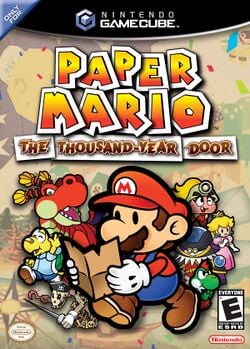 North American box art | |||||||||
| Developer | Intelligent Systems | ||||||||
| Publisher | Nintendo | ||||||||
| Platform(s) | Nintendo GameCube | ||||||||
| Release date | Original release Player's Choice | ||||||||
| Language(s) | Deutsch English (United States) Español (España) Français (France) Italiano 日本語 | ||||||||
| Genre | RPG | ||||||||
| Rating(s) |
| ||||||||
| Mode(s) | Single player | ||||||||
| Media | Nintendo GameCube:
| ||||||||
| Input | Nintendo GameCube:
| ||||||||
Paper Mario: The Thousand-Year Door is a role-playing game and the second installment in the Paper Mario series. It was developed by Intelligent Systems for the Nintendo GameCube in 2004.
The game's plot revolves around Mario, who embarks on a mission to rescue Princess Peach, who was kidnapped by the organization named X-Nauts by stopping them and particularly their leader, Sir Grodus. In order to do this, Mario and his partners should collect the seven magical artifacts known as the Crystal Stars in order to open the Thousand-Year Door, an enormous door which holds a legendary treasure that has a lot of rumors and legends spread about. While being kidnapped, Peach sends Mario various information about the X-Nauts' intentions for the world conquest and Bowser also tries to collect the Crystal Stars along the way.
Being a follow-up to Paper Mario, the game borrows the similar art style and key gameplay elements as obtaining the party members to solve puzzles or getting the Star Points after winning a battle. However, Paper Mario: The Thousand Year-Door improves these elements further such as partners having their own health, or obtaining the Star Power during battle by interacting with the Audience rather than refilling it automatically. Additionally, the game improves the "paper" aesthetics as well by adding certain elements both in gameplay (such as paper abilities) and the game's design in general.
Plot
Opening
The adventure begins when Princess Peach goes on a cruise to Rogueport where she meets a hooded woman, and buys a box which contains a map. She sends this to Mario, along with a letter asking him to help her search for the map's treasure. Soon after that, she is kidnapped by Sir Grodus. Mario receives the letter with the map and decides to help her, and thus boards a ship to Rogueport.
Prologue: A Rogue's Welcome
Shortly after Mario reaches Rogueport, he finds Lord Crump attempting to interrogate Goombella about the Crystal Stars. Mario intervenes and Lord Crump tries to defeat him. After defeating the X-Naut general and escaping from the X-Nauts, Goombella introduces herself, and Mario explains his quest to her. As Goombella is also searching for the map's treasure, she decides to join Mario. Then, Goombella suggests to go to Professor Frankly's house, to consult him and show him the map. At the professor's house, Frankly explains that the map is related to the legend of the treasure of the Thousand-Year Door, and that, to obtain the treasure, one must first open the door with the seven Crystal Stars. Said objects can be found by holding the Magical Map before the Thousand-Year Door, which is located in the town's sewers. So, Mario holds the map before the Thousand-Year Door, revealing the location of the first Crystal Star.
Names in other languages
| Language | Name | Meaning |
|---|---|---|
| Japanese | プロローグ ゴロツキタウンへようこそ! Purorōgu: Gorotsuki Taun e Yōkoso! |
Prologue: Welcome to Rogueport! |
| French | Prologue: Bienvenue à Port-Lacanaïe! |
Prologue: Welcome to Port-Lacanaïe! |
| German | Prolog: Willkomen in Rohlingen |
Prologue: Welcome to Rohlingen |
| Italian | Prologo: Benvenuti a Fannullopoli |
Prologue: Welcome to Idler City |
| Spanish | Prólogo: Bienvenidos a Villa Viciosa |
Prologue: Welcome to Vicious Village |
Chapter 1: Castle and Dragon
Mario and Goombella show the updated map to Professor Frankly, who reveals that the first Crystal Star is in Petal Meadows. To reach this place, they must find a pipe in Rogueport Sewers. After finding it, Mario and Goombella arrive in Petal Meadows, where they see Hooktail and her castle. The duo stops at a nearby village called Petalburg and discover from the mayor that the dragon Hooktail has been terrorizing the village. The mayor tells them that Hooktail guards the Crystal Star in her castle, and that to access it, they must find the two stone keys in Shhwonk Fortress. After finding them, Mario and Goombella march to Hooktail's castle, with Koops in tow (who wants to defeat Hooktail to avenge his dead father and become stronger). After navigating through the castle's traps with the help of Koops, they encounter the dragon and defeat her, allowing Koops's father to get out of the dragon's gut and present Mario with the Diamond Star.
Somewhere else, it is revealed that Princess Peach was abducted by the X-Nauts. When a X-Naut tells Sir Grodus someone got the first Crystal Star, Peach accidentally blurts out Mario's name. Grodus hears this and orders the Shadow Sirens to steal the map in Mario's possession. Peach then meets TEC-XX, who develops an interest in Peach's concept of love, and asks for her help to understand it. Peach agrees; in exchange, TEC lets her send e-mails to Mario. During another scene transition, at Bowser's Castle, Kammy Koopa tells Bowser about Mario's quest to find the Crystal Stars and Peach's abduction, things that motivate Bowser to hunt for the Crystal Stars and kidnap Peach back. Bowser and Kammy then head for Rogueport.
Back in Petalburg, the group receives an e-mail from Peach, who tells them she has been kidnapped. Mario and co. head back to the Thousand-Year Door to reveal the location of the next star.
Storyline text
Mario and friends finally got a Crystal Star in the castle after defeating Hooktail. Koops even reunited with his long-lost father, whom he thought was dead. Yet they were unable to learn anything about the whereabouts of the princess. Where could Princess Peach be? Yes... Mario's adventure has only just begun.
Names in other languages
| Language | Name | Meaning |
|---|---|---|
| Japanese | ステージ1 マリオとお城とドラゴンと Sutēji 1: Mario to Oshiro to Doragon to |
Stage 1: With Mario, the castle and the dragon |
| French | Chapitre 1: Mario + château + dragon |
Chapter 1: Mario + castle + dragon |
| German | Kapitel 1: Lohgards Drachenburg |
Chapter 1: Dragon Lohgard's Castle (Lohgard is Hooktail's German name.) |
| Italian | Scena I: Mario, il castello e la dragonessa |
Scene 1: Mario, the castle and the dragon |
| Spanish | Acto 1: El bueno, el feo y el malo |
Act 1: The Good, The Ugly and The Bad |
Chapter 2: The Great Boggly Tree
The second Crystal Star is revealed to be in the Great Tree, home of small creatures known as Punies, deep inside Boggly Woods. When searching for the pipe leading to Boggly Woods in Rogueport Sewers, Mario and his partners encounter Punio, who tells them that the X-Nauts have invaded the Great Tree, capturing most of the Punies and that the Jabbies, the Punies' enemies, have allied with the X-Nauts and are trying to expulse the Punies from the Great Tree. Mario and co. decide to help out the Punies, and therefore Punio leads the group to the Boggly Woods. After getting there, Mario and co. encounter the Shadow Sirens with a necklace, who do not recognize him due to having lost a sketch of him. The group continues and arrives at the Great Tree. However, they realize that the tree is locked. Punio suggests they find Madame Flurrie; to find the secret entrance. However, upon reaching her home, Flurrie reveals she has lost her necklace and does not want anyone to see her without it. After defeating the Sirens and returning the necklace to Flurrie, she joins them in their quest. The group finds the secret entrance and enters the tree; after freeing the locked Punies with the aid of a special orb and after solving the Great Tree's puzzles and defeating the Jabbies, they reveal the second Crystal Star at the bottom of the tree. There, Lord Crump snatches it, and activates a time bomb to blow up the tree. After chasing him to the entrance, he stops the bomb and uses Magnus von Grapple to fight the heroes, but he is defeated by the group. Afterwards, the X-Nauts evacuate the tree and Mario and co. obtain the Emerald Star.
At the X-Naut headquarters, the X-Nauts inform Sir Grodus that Mario has taken the Emerald Star. Meanwhile, TEC-XX calls for the Princess, and asks her to dance with him. TEC then lets Peach e-mail Mario.
Bowser can be seen arriving in Petalburg, and then talking to what he thinks is Peach, but is revealed to be a poster by a nearby Koopa.
As Mario and his team move on, they receive another e-mail from Peach, who tells them that the X-Nauts are searching for the Crystal Stars. Mario and his team reveal the location of the next Crystal Star, and they visit Professor Frankly for details.
Storyline text
And so, after pummeling Lord Crump, Mario obtained the second Crystal Star... With the X-Nauts gone, peace once again prevailed throughout the Great Tree. The Boggly Woods echoed with the Puni songs of joy. But... this may not be the last our hero hears from the vile X-Nauts. They will surely continue to stand in Mario's way and try to put a stop to his efforts...
Names in other languages
| Language | Name | Meaning |
|---|---|---|
| Japanese | ステージ2 ふしぎの森の大きな木 Sutēji 2: Fushigi no Mori no Ōkina Ki |
Stage 2: The Big Tree of the Mysterious Forest |
| French | Chapitre 2: Un grand arbre |
Chapter 2: A great tree |
| German | Kapitel 2: Der Baum der Bubus |
Chapter 2: The tree of the Bubus (Bubu is the German name for the Punies.) |
| Italian | Scena II: La Grande Quercia del Bosco Misterioso |
Scene 2: The Great Oak of the Mysterious Forest |
| Spanish | Acto 2: El bosque animado |
Act 2: The Animated Forest |
Chapter 3: Of Glitz and Glory
The third Crystal Star appears in a large arena on a floating town. To reach Glitzville, Mario and the gang must visit Don Pianta. He offers them the ticket they need after doing him a favor. Once Mario and his team arrive in Glitzville, they enter the Glitz Pit, a popular place in which fighters brawl, and spot the Crystal Star on the Champ's Belt, held by Rawk Hawk, the current champion. They sign up in the Pit, battle through the ranks, and eventually gain a newborn Yoshi as a partner. Soon, a mysterious figure known only as "X" starts sending cryptic e-mails to Mario. The e-mails lead Mario and his partners to discover that the Star on the belt is a fake, and that the real Crystal Star is being used by Grubba, the promoter of the Glitz Pit. Mario & co. expose his wrongdoings and chase him into the arena, where he transforms into Macho Grubba in order to eliminate Mario and his friends. However, the group manages to defeat him. After the battle, Jolene, Grubba's assistant, appears and reveals herself as the mysterious X, explains her story, and gives Mario the Gold Star.
At the X-Naut base, TEC-XX asks Peach to go ask Grodus a question relating to his plans. The Princess goes undercover in an X-Naut disguise and learns that Grodus is plotting to use the Crystal Stars to take over the world. TEC allows her to send this message to Mario. Meanwhile, Bowser and Kammy are searching for one of the Crystal Stars in the Great Tree, where they discover that Mario already obtained it.
Mario & co. receive another message from Peach; they promptly reveal the fourth crystal star's location.
Storyline text
Glitzville's seamy underside was a dark, dangerous place seething with conspiracy... With the help of the lovely Ms. Jolene, Mario revealed Grubba's true identity... And acquired the third Crystal Star by defeating the monstrous Macho Grubba. Grubba had used the power of the Crystal Star to run his power-draining machine... What other hidden powers might these strange and mystical items possess?
Names in other languages
| Language | Name | Meaning |
|---|---|---|
| Japanese | ステージ3 もえよ!チャンピオン! Sutēji 3: Moeyo! Chanpion! |
Stage 3: Get fired up! Champion! |
| French | Chapitre 3: Vas-y champion! |
Chapter 3: Go champion! |
| German | Kapitel 3: Kampf der Champions |
Chapter 3: Clash of the Champions |
| Italian | Scena III: Forza, campione! |
Scene 3: Come on, champion! |
| Spanish | Acto 3: El rey de los luchadores |
Act 3: The King of Fighters |
Chapter 4: For Pigs the Bell Tolls
Professor Frankly tells the group that the Crystal Star is located in Creepy Steeple, near Twilight Town. When Mario & co. get to Twilight Town, they discover that the village is under a curse cast by a monster who lives in the steeple. Using a new Black Chest Demon power, the group reaches the steeple, and battles the monster. During the battle, the monster uses an ability to steal Mario's name and body, transforming Mario into a shadowy version of himself. Mario's partners claim the Crystal Star and leave with whom they think is Mario. Meanwhile, the Shadow Sirens are in Twilight Town, planning on defeating Mario and his partners with their new weapon: the Superbombomb. However, Beldam seems to have lost it, prompting her to blame Vivian and to force her to search for it. The real Mario returns to Twilight Town, and helps Vivian with her problem. Out of gratitude, she joins Mario's party. They eventually discover from the monster's parrot that the monster's name is Doopliss. After telling Doopliss his name, he is weakened and flees to Creepy Steeple. Mario and Vivian chase him there and they fight once more. Mario and his new partner defeat Doopliss, allowing Mario to regain his name and body and obtain the Ruby Star.
At the X-Naut base, TEC-XX asks the Princess to participate in a sort of "quiz show" with him. By doing this, she discovers what the "treasure" of the Thousand-Year Door really is: the soul of an ancient demon. The Princess then relays this information to Mario. Meanwhile, Bowser continues his quest for the Crystal Stars by flying to Glitzville in his Koopa Clown Car. However, it malfunctions halfway there, and he travels underwater to return to Rogueport. After he and Kammy return, he orders Kammy to continue her research on the Crystal Stars.
Back in Twilight Town, Mario and his friends receive the message from Peach. They reveal the next Crystal Star and visit Professor Frankly for details.
The English name for the chapter, as well as its Japanese, Spanish, Italian, and French translations, are referencing the Ernest Hemingway novel, For Whom the Bell Tolls. The Japanese name is also potentially a reference to the Japan exclusive Kaeru no Tame ni Kane wa Naru co-developed by Intelligent Systems which involves a bell capable of transforming frogs into people.
Storyline text
(fake) Mario defeated the scourge of Creepy Steeple and found the fourth Crystal Star. The people of Twilight Town have surely recovered from their awful curse by now. At this rate, Mario's quest to collect all seven Crystal Stars will be done in no time! With his back to Creepy Steeple, Mario sets out toward his bright future...
(real) Mario defeated the rogue who had stolen his name and appearance. Now Mario has four Crystal Stars. That leaves a mere three more to find! And THAT means his quest to collect all of the Crystal Stars is more than half over! Now Mario heads off toward his next adventure with his new friend, Vivian... ...But what about Beldam and Marilyn? And what became of the doppelganger, Doopliss?
Names in other languages
| Language | Name | Meaning |
|---|---|---|
| Japanese | ステージ4 ブタのためにカネはなる Sutēji 4: Buta no Tame ni Kane wa Naru |
Stage 4: For Pigs the Bell Tolls; A parody on For Whom the Bell Tolls and Kaeru no Tame ni Kane wa Naru |
| French | Chapitre 4: La cloche à cochons |
Chapter 4: The pig bell |
| German | Kapitel 4: Die Glocke der Spukabtei |
Chapter 4: The bell of the Spook Abbey |
| Italian | Scena IV: Per chi suona la campana |
Scene 4: For whom the bell tolls |
| Spanish | Acto 4: ¿Por quién dobla la campana? |
Act 4: For Whom the Bell Tolls? |
Chapter 5: The Key to Pirates
The fifth Crystal Star is located deep within a pirate's lair on the southern island of Keelhaul Key. To reach the island, Mario enlists the help of Flavio and Admiral Bobbery. They sail to the island with some Toads, Pa-Patch, and Lord Crump in disguise (known as "Four-Eyes"). On their way to the island, Mario and co. are attacked by Cortez's Embers, which shipwreck them on Keelhaul Key. Later on, some of the crew members are attacked by more Embers, and Bobbery sacrifices himself to save them. Bobbery says he is close to death, and after giving him his last request, they find out that he just fell asleep. After Mario wakes him, he joins Mario's party. With the aid of Bobbery and Flavio's Skull Gem, Mario and co. enter Pirate's Grotto. After solving some puzzles, and after gaining another ability from a Black Chest Demon, they finally reach the lair of Cortez. After they battle, Cortez gives Mario his Sapphire Star. Afterwards, Lord Crump abandons his disguise and tells Mario that he will continue attacking him with his ship's cannons until he hands over the Crystal Star. With the help of Cortez's ship and Flavio's Skull Gem, they defeat the invading X-Nauts, along with their leader.
In the X-Naut base, TEC-XX wishes to gain access to a disk in Grodus's room, and asks Peach to help him. After making an invisibility potion, she helps him and he promises to analyze the data. Peach then sends another e-mail to Mario, informing him of this. Meanwhile, in Twilight Town, Bowser and Kammy Koopa run into Lord Crump. The three get into an argument, which escalates to an armed confrontation between the Koopa Troop and the X-Nauts. However, Bowser inadvertently ignites the Superbombomb, knocking out both armies.
Back at Keelhaul Key, Cortez ferries Mario and his teammates to Rogueport. Mario gets the e-mail from Peach, telling them about what TEC is analyzing. Mario and his team then reveal the next Crystal Star's location, and visit Professor Frankly for information.
Storyline text
Cortez, scourge of the seas... Mario soundly defeated this fearful spirit and claimed the Crystal Star. Perhaps the peaceful citizens of the world no longer need fear Cortez and his fell ship... The only problem remaining is how Mario will escape this isolated island... And could there be another problem still, hiding beneath our hero's nose?
Names in other languages
| Language | Name | Meaning |
|---|---|---|
| Japanese | ステージ5 トロピコアイランドの大海賊 Sutēji 5: Toropiko Airando no Dai Kaizoku |
Stage 5: The Great Pirate of the Tropic Island |
| French | Chapitre 5: Pirate de Tropatroce |
Chapter 5: Pirate of Tropatroce |
| German | Kapitel 5: Der Schatz des Piraten |
Chapter 5: The pirate's treasure |
| Italian | Scena V: Il grande pirata dell'Isola Tropico |
Scene 5: The Great Pirate of the Tropic Island |
| Spanish | Acto 5: La isla del tesoro |
Act 5: Treasure Island |
Chapter 6: 3 Days of Excess
The sixth Crystal Star is in Poshley Sanctum in the town Poshley Heights. The only way to reach the town is on the famous Excess Express. After doing Don Pianta another favor, he gives Mario a train ticket. During the first day on the Excess Express, Mario and his team found many mysterious happenings, including thefts of items and messages threatening to blow up the train. On their second day of travel, Pennington, a Bumpty detective, helps Mario and his friends solve the crimes and they manage to capture a fake Zip Toad who was really Doopliss in disguise, and was the one who attempted to halt the train by causing an explosion with some stolen items. At sundown, when the train stops at Riverside Station for refuel, Doopliss escapes capture. Mario and company find that the drawbridge has been lifted, preventing the Excess Express from continuing its route. The gang enters Riverside Station and flips the switch to bring the drawbridge back down. They discover that a group of Smorgs are behind it. On the third and final day of the journey, a stowaway Smorg monster attacks the train, kidnapping all of its passengers. Mario and his friends defeat the creature, rescuing the passengers in the process, and finally reach Poshley Heights. They venture into Poshley Sanctum, a museum that happens to belong to Pennington. The Shadow Sirens, who happen to be already inside, snatch what appears to be the Garnet Star and flee. However, Pennington reveals that what they stole was a fake, and lets Mario find where the real Crystal Star is. After some exploring, Mario and company manage to find the real Garnet Star.
Back at the X-Naut base, the X-Nauts tell Grodus that Mario has six of the seven Crystal Stars. They also tell him of TEC's betrayal. Meanwhile, TEC tells the Princess the data he gained from Grodus's data disk, and prepares to help Peach escape. Before he is able to, Grodus enters with two X-Nauts and orders them to initiate a data-wipe procedure of TEC's memory. TEC tells Peach "I love you" just before he is shut down.
Meanwhile, Bowser is searching for another Crystal Star in Rawk Hawk's workout room, which he has found in the form of the Champ's Belt. However, he quickly learns that it is not a real Crystal Star, just a glass fake.
Mario and his team return to Rogueport and receive an e-mail from Peach, telling them about what the X-Nauts plan to do with her, but an important part of it is cut off due to TEC being shut down. Back in Rogueport, Mario and co. reveal the next Crystal Star's location and visit Professor Frankly for details.
Chapter 6 appears to allude to Murder on the Orient Express, which also involves several peculiar passengers on a train where a crime takes place.
Storyline text
Mario found the sixth Crystal Star, hidden craftily in the Poshley Heights sanctum. Now only one Crystal Star remains... But our hero still does not know where Princess Peach is being held. Where could the last Crystal Star be? And where is Peach being held? Hoping this Crystal Star might yield answers, Mario and friends return to Pennington.
Names in other languages
| Language | Name | Meaning |
|---|---|---|
| Japanese | ステージ6 リッチリッチエクスプレス3日間 Sutēji 6: Ritchi Ritchi Ekusupuresu Mikka-kan |
Stage 6: The Rich Rich Express 3 days |
| French | Chapitre 6: Dans le Crésus Express! |
Chapter 6: On the Crésus Express! |
| German | Kapitel 6: Reise im Glimmer-Liner |
Chapter 6: Travel in the Excess Express |
| Italian | Scena VI: Tre giorni sul Fasto-Express |
Scene 6: Three days on the Pomp-Express |
| Spanish | Acto 6: Misterio en el Ricachón Exprés |
Act 6: Mystery in the Rich Man (Train) Express |
Chapter 7: Mario Shoots the Moon
The last Crystal Star appears to be on the moon. To reach the moon, Mario and his companions travel to Fahr Outpost to find a cannon to shoot them to the moon. After searching for Goldbob and General White, whose blessings are needed to operate the cannon, Mario & co. enter the cannon and are shot to the moon.
On the moon, the group discovers the X-Naut Fortress. Once they arrive at the end of it, Lord Crump appears, bragging about his latest creation — Magnus von Grapple 2.0, and tries once more to defeat Mario and company. After Lord Crump is defeated, the Crystal Star is released.
Meanwhile, Bowser is searching for another Crystal Star in the Poshley Sanctum. A Paragoomba flies in and tells Bowser that Mario has collected every Crystal Star and is heading for the Thousand-Year Door, which contains a great treasure. Bowser announces that he will steal this treasure and defeat Mario.
As Mario and his allies prepare to leave the fortress, they discover that all of the doors have been locked, except for one. In this room, the heroes find TEC, who is running on backup power. He recognizes Mario and tells him to rescue the Princess, who has been taken to the Palace of Shadow, a place that lies beyond the Thousand-Year Door. He then activates an emergency transporter. The group is transported to a room in Rogueport Sewers. After exiting the room, Professor Frankly meets them at the entrance and urges them to open the Thousand-Year Door.
Storyline text
The last Crystal Star had been hidden in the X-Naut hideout on the moon... But by the time Mario recovered it, Peach had already been taken away... Where could Peach be now? And what of the elusive Grodus? Perhaps he holds the key to the remaining puzzle... Mario finally has all seven Crystal Stars... Where will they lead him next?
Names in other languages
| Language | Name | Meaning |
|---|---|---|
| Japanese | ステージ7 はるかなる月を目ざして Sutēji 7: Harukanaru Tsuki o Mezashite |
Stage 7: Aiming at the Distant Moon |
| French | Chapitre 7: Voyage sur la Lune |
Chapter 7: Journey to the Moon |
| German | Kapitel 7: Der Weg zum Mond |
Chapter 7: The Way to the Moon |
| Italian | Scena VII: Viaggio sulla Luna |
Scene 7: Journey to the Moon |
| Spanish | Acto 7: Objetivo: la Luna |
Act 7: Target: the Moon |
Chapter 8: The Thousand-Year Door
After Mario has received all seven Crystal Stars, the time has come to open the Thousand-Year Door and enter the Palace of Shadow to rescue Princess Peach from Grodus.
Mario and his friends open the Thousand-Year Door with the seven Crystal Stars, allowing them to enter the Palace of Shadow. The palace itself is full of enemies, puzzles, and traps. Eventually, Mario and co. battle and trounce a dragon named Gloomtail, older brother of Hooktail. After the dragon's defeat, he relinquishes the key to access the Riddle Tower. After solving the puzzles of the tower, a secret passage which leads deeper into the palace is revealed. Mario and his party continue down that path, but not before defeating the Shadow Sirens, who try to get rid of them. Finally, Mario and company reach the throne room of the palace, where they find and defeat Sir Grodus. Bowser and Kammy, who drop in unexpectedly, also battle Mario, but are thwarted in the end. Grodus uses the distraction of the battle to bring Princess Peach into the deepest part of the palace. There, he opens a sealed coffin and frees the Shadow Queen, the ancient demon of legend. Beldam suddenly appears and announces that she was the one who orchestrated the plot to free her mistress. The Shadow Queen refuses to be controlled by Grodus, and fries him with a lightning bolt, apparently killing him. The Queen then possesses Princess Peach, using her as a vessel to sustain her life. The world is then covered in darkness. Mario and his allies fight the Queen, but she eventually decides to fight in her real form, in which she is invincible. She proves too much for the group to handle, however, the Crystal Stars suddenly react to the evil of the Queen and fly throughout the world, each returning to where they were found, allowing the people of the world to cheer on Mario and his party. The hope of the people of the world break through the Queen's invulnerability, and this also allows Peach to give the heroes the last of her power. Strengthened, the heroes seal the Shadow Queen forever, saving the world.
Goombella later sends Mario a message, explaining what everyone has done: she works with Professor Frankly, while Koops plans on becoming the Mayor of Petalburg. Flurrie has returned to the stage and enacts "Paper Mario" as her comeback smash while Doopliss plays the role of Mario. The Yoshi fights in the Glitz Pit as the "Great Gonzales Jr.", while Vivian has forgiven her sisters and lives in Twilight Town. Admiral Bobbery sails the seas with Cortez, and Ms. Mowz runs her Lovely Howz of Badges. Lord Crump, Grodus and the X-Nauts survived and are spending their time in Poshley Heights. TEC survived as well, and hopes to see the Princess again one day. The game ends when the Princess visits the Mario Bros. with another treasure map.
Names in other languages
| Language | Name | Meaning |
|---|---|---|
| Japanese | ステージ8 スターストーンと伝説の宝 Sutēji 8: Sutā Sutōn to Densetsu no Takara |
Stage 8: The Star Stones and the Legendary Treasure |
| French | Chapitre 8: Le trésor légendaire |
Chapter 8: The legendary treasure |
| German | Kapitel 8: Die Legende vom Schatz |
Chapter 8: The treasure's legend |
| Italian | Scena VIII: Le Gemme Stella e il Tesoro Leggendario |
Scene 8: The Star Gems and the Legendary Treasure |
| Spanish | Acto 8: El destino en sus manos |
Act 8: The fate in their hands |
Gameplay
In terms of gameplay, Paper Mario: The Thousand-Year Door brings over the core mechanics of the game's prequel and enhances them further. Mario now can speak when performing moves as jumping or collecting different items, and starts his adventure with a Hammer. Action Commands can also be performed initially, while in Paper Mario a Lucky Star must be collected, however, Mario has lost the ability to Spin Dash from the original game.
For the most part of the game, the player takes control of Mario, who goes to various locations from the Rogueport, which replaces Toad Town's role as a hub from the prequel. The game is divided into chapters with an each one being set in an unique area, many of which contain NPCs (non-playable characters who can be interracted with) or/and enemies, some of the former can provide Mario and his partners with certain services, such as Merlon.
On Mario's way, he and his partners use various techniques that help them progress in adventure: Mario can reach blocks above his head, come across the gaps and getting himself to the higher areas by using the Jump move, while the Hammer is used for destroying various obstacles as Yellow Blocks. Progressively, player expands the Boots and the Hammer by getting upgrades that allow the player to perform new abilities, as breaking the panels that are below Mario or destroying the gigantic Yellow Blocks.
Background
Another element introduced in Paper Mario: The Thousand-Year Door is the background scenery, which is actually accessible for Mario through certain pipes. Several places which only appear in the background can be visited this way, some of which are larger areas when interacted with. This feature was carried over to the next game in the series, Super Paper Mario. Certain abilities are disabled here, however: Mario's partners cannot be used in the background, Mario cannot move to a different screen/area, and he also cannot walk past any houses or locations.
Intermissions
After each chapter, there is an intermission where the player is able to control Princess Peach, who is held captive in the X-Naut Fortress until the chapter 7. The Peach intermission is followed by a Bowser intermission, a new addition in Paper Mario: The Thousand-Year Door. Bowser usually visits the places Mario has been to one chapter before, and several missions include a side-scrolling platformer level in the style of Super Mario Bros. after completing the second, fourth and the sixth chapters. In these levels, Bowser has the ability to breathe fire, and by using the only available item, Meat, is able to radically increase his size, allowing him to crush everything in his way if collecting enough of it. While enemies like the X-Nauts charge at Bowser, others like Goombas turn away when he approaches them. The levels are called 1-X, 2-X and 3-X in reference to the world numbering of Super Mario Bros., while X stands for the number of tries Bowser has used for the level. He has endless lives for the levels. They are set in the three basic terrains of Super Mario Bros.: Overworld, Underwater and Underground/Castle.
Controls
|
Overworld
|
Menu
|
Battle
|
As Princess Peach
|
As Bowser
|
Mario's stats
| Stat | Initial value | Minimal value | Max value | Purpose and function | |
|---|---|---|---|---|---|
| 1 | 1 | 99 | Indicate Mario's progress. With an each upgrade, the player can choose a stat to increase among their HP, FP or BP. | ||
| 10 | 51 | 200 | The number of Mario's health points. If it reaches zero, Mario will faint. | ||
| 5 | 5 | 200 | Let Mario and his partners use more effective attacks. | ||
| 3 | 3 | 99 | Show which and how many Badges Mario can equip. | ||
| (image_missing) Star Power | 0 | 0 | 8 | Used to perform Special Moves. Available when Mario goes the first time to the Thousand-Year Door and increases each time when he obtains a Crystal Star. | |
| 0 | 0 | 99 | Indicate Mario's progress towards the next level. Gained by defeating enemies, collecting 100 of them will upgrade Mario's level. | ||
| 0 | 0 | 999 | The number of coins Mario currently has. Obtained after the battle ends, but also can be found in the yellow ? Blocks and used to purchase various items. | ||
| 0 | 0 | 100 | The number of Star Pieces collected. Mario can exchange them with Dazzle for badges. | ||
| 0 | 0 | 42 | Shows the amount of Shine Sprites Mario has found. Three of them can be given to Merlon to increase the partner's rank. | ||
| 0:00 | 0:00 | 99:59 | Denote the amount of time the player has played the game. |
1 - Can be decreased only by boosting other stat while sacrificing the amount of HP from Chet Rippo.
Equipment
| Item | Location | Ability | Ability Action Command |
|---|---|---|---|
Boots |
Available from the start |
Allow Mario to do Jump attack in battle. It is effective against the flying enemies, but will not work on the spiked and fiery enemies (such as Spiky Goombas and Embers) |
|
Super Boots |
The Great Tree |
The Super Boots allow Mario to perform a Spin Jump, which can break certain passages under Mario. Additionally, it boosts the power of Jump by one unit, thus allowing the player to do 2+2 damage on enemy. |
|
Ultra Boots |
Riverside Station |
The Ultra Boots retain the previous abilities, except that they also add a Spring Jump move, which can allow Mario to climb high fences and hit high ceilings. Additionally, it boosts the power of Jump by another unit, thus allowing the player to deal 3+3 damage on enemy (or 3+6 if they will use the Spin Jump move). |
|
Hammer |
Available from the beginning |
The Hammer allows Mario to break Yellow Blocks and use the Hammer attack in battle. While this move has a better output on the spiked and fiery enemies, it won't be effective on the flying enemies (such as Paragoombas, unless the player deals a First Strike on them). |
|
Super Hammer |
Glitz Pit |
The Super Hammer allows Mario to break gigantic Yellow Blocks and upgrades the strength of his hammer attack power by 1 unit, thus allowing the player to deal the 4 damage. Additionally, it brings a new move Super Hammer. |
|
Ultra Hammer |
Rogueport (requires the Ultra Boots) |
The Ultra Hammer allows Mario to break Stone and giant Stone blocks, upgrade the strength of his Hammer and Super Hammer attack power to 3 (6 if timed correctly) and add a move Ultra Hammer. |
|
Ultra Stone |
The Ultra Stone enables Mario to upgrade the party members to Ultra Rank with the help of Merlon and three Shine Sprites. |
N/A | |
Strange Sack |
Pit of 100 Trials |
The Strange Sack allows Mario to equip 20 items instead of 10. |
N/A |
Paper abilities
Whilst exploring the game's world, the player encounters black treasure chests, which give Mario special abilities comically named "curses" to use in the overworld. They all based on the paper-like feature of the game's design as rolling into a tube or becoming a paper plane.
| Paper ability | Location and chapter received | Ability gained |
|---|---|---|
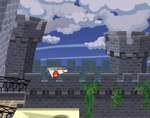 Plane Mode |
Rogueport Sewers | Allows Mario to fold himself into a paper plane, while he stands on a panel with the plane drawing on it and pressing the |
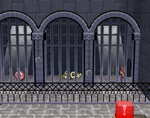 Paper Mode |
Hooktail Castle | Allows Mario to turn sideways, which allows him to go through certain narrow passages; this can be done by pressing and holding |
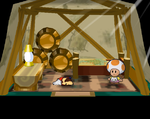 Tube Mode |
Twilight Town | Allows Mario to roll up into a short tube, allowing him to quickly roll around and pass under low passageways; the player should press and hold |
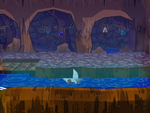 Boat Mode |
Pirate's Grotto | Allows Mario to fold himself into a paper boat and launch him into water, if he stands on a panel with the boat drawing and the player presses |
Objects
A table of various objects that can be encountered by Mario: some of these items are helpful to the player by providing Mario and the partners various items, abilities or make the obstacles easier to evercome, the others, on the other hard, serve as obstacles and require special abilities, partners or items to be traversed through.
Party members
The party member system makes a comeback from the Paper Mario and has exactly the same purpose on gameplay and battle. Throughout the game, Mario encounters various characters who join him on the journey. Every partner has an unique ability in the overworld that can be activated by pressing ![]() and serves to be helpful to traverse the area in a different way. While the partners have the equivalents from the original Paper Mario in terms of abilities (such as Admiral Bobbery being inspired by Bombette), their overworld abilities are expanded in unique ways such as Koops being able to hold his shell in place, and previously mentioned Admiral Bobbery can be hold and thrown from above.
and serves to be helpful to traverse the area in a different way. While the partners have the equivalents from the original Paper Mario in terms of abilities (such as Admiral Bobbery being inspired by Bombette), their overworld abilities are expanded in unique ways such as Koops being able to hold his shell in place, and previously mentioned Admiral Bobbery can be hold and thrown from above.
Upgrading party members
Every party member joins Mario at the basic rank, being able to do only two moves in battle. However, if the player finds three Shine Sprites and goes to Merlon, the latter may upgrade the partner, which can increase the damage output, the maximum Heart Point amount and teaches the party member a new move.
First time the party member is upgraded, they reach the Super Rank; if the player needs to upgrade a partner further, they will need to obtain the Up Arrow item and bring it to Merlon, thus Merlon can upgrade a partner to the Ultra Rank, which serves as the last level on which the partner can perform four moves. There are 42 Shine Sprites in total, enough to upgrade every partner fully.
| Name | Info | Overworld ability | ||||||||||||
|---|---|---|---|---|---|---|---|---|---|---|---|---|---|---|
Goombella |
| |||||||||||||
| ||||||||||||||
 Koops |
|
| ||||||||||||
| ||||||||||||||
Flurrie |
|
| ||||||||||||
| ||||||||||||||
 Yoshi |
|
| ||||||||||||
| ||||||||||||||
Vivian |
|
| ||||||||||||
| ||||||||||||||
Admiral Bobbery |
|
| ||||||||||||
| ||||||||||||||
Ms. Mowz (optional) |
|
| ||||||||||||
| ||||||||||||||
Battle system features

Battles in Paper Mario: The Thousand-Year Door take place on a stage and use the side-view system. Much like in the predecessor, Mario can interact with enemies on the overworld by performing moves called first strikes: if the enemy was hit first, then the player can perform an Action Command in the battle (it is worth mentioning that unlike Paper Mario, the player has a chance to deal more damage whereas in the former the same cannot be done), however, if Mario got a hit by an enemy on the map, then the same character will get a free turn.
To win a battle, Mario should defeat all of the enemies on the other side by dropping their health to zero, whereas if Mario's HP amount is dropped to 0 and the player doesn't have a Life Shroom, then the battle is lost and the player receives a Game Over screen, exiting to the main menu afterwards. During a battle, player can restore Mario and partner's statistics, which are shown on top.
Since the game is a turn-based RPg, both enemies and Mario with his active party member take turns during the battle. The damage done to enemy is determined by Mario and/or his ally's attack power minus the enemy's defense: for example, if Mario will attack Dull Bones by jumping on them while having the Jump attack power of 1, zero damage will be done since Dull Bones have the Defense of 1 point. Additionally, the player can change the attack order by pressing ![]() , thus allowing the partner to attack the enemies earlier than Mario and vice versa; in addition, the partner can take the damage instead of Mario if done correctly.
, thus allowing the partner to attack the enemies earlier than Mario and vice versa; in addition, the partner can take the damage instead of Mario if done correctly.
Mario's action
Mario's battle opportunities are the same from the predecessor with several changes: firstly, if the player will choose to do noting, Mario will boost his defense by 1 point (the same works with the allies), as opposed by simply doing nothing with no effect from Paper Mario, and secondly, the Focus technique was replaced with the Appeal, which works in the exact way, but was revamped in order to match the Audience feature.
Party member's action
Much like Paper Mario, Mario's party members have less abilities: they can do an attack, change an ally or do noting in battle, thus skipping their action. Depending on the character's rank, they can use 2-4 moves, with the first (and second for Goombella move costing zero PF, whereas the other attacks will always cost one or more; additionally, at least one move replicates the partner's ability in the overworld, such as Vivian's Veil, or Koops' Shell Toss.
Unlike the previous game in Paper Mario series, however, the partners have their own separate health and take damage in the same way Mario does, however, if an active partner's HP drops to zero, they will pass out and remain in this state till the end of a battle unless a player has a Life Shroom in the inventory, which revives a respective character. Additionally, Mario's party members have more in common with Mario with the abilities of using items and quitting a battle.
(screenshot with a partner being passed out: in progress)
Both Mario and his active ally can swap the latter in battle, which will cost one turn unless the player equips the Quick Change badge.
Enemy's action
Guarding
While being attacked by an enemy, Mario and his partners still can cut their damage by one point by performing a guard move: the player wants to press the ![]() in the same moment when an enemy attacks Mario; additionally, this Action Command can nullify any status brought by an enemy (such as Putrid Piranha's poison). However, the player should press the mentioned button in 8/60 per a second (8 frames), but if the action is done correctly, Mario will crouch and the word "Nice" will be shown.
in the same moment when an enemy attacks Mario; additionally, this Action Command can nullify any status brought by an enemy (such as Putrid Piranha's poison). However, the player should press the mentioned button in 8/60 per a second (8 frames), but if the action is done correctly, Mario will crouch and the word "Nice" will be shown.
Additionally, the player can do a Superguard Action Command, which not only nullifies enemy's attack, but also deals 1 additional point of damage to the direct attacks (except for the Iron Clefts); if the player does this move to a non-direct attack, Mario will simply take no damage and effect from enemy (except for Pokeys, whose projectiles will be launched back). While being more useful compared to the Guard move, the Superguard is harder to execute, requiring the player to react in 3/60 in a second (3 frame window) by pressing ![]() ; if the action is done, Mario and his active partner will spin in place and the word "Great" will be shown.
; if the action is done, Mario and his active partner will spin in place and the word "Great" will be shown.
End of battle
Every time Mario makes all the enemies disappear, he wins a battle and earns Star Points. The amount he earns from each enemy depends on his current level compared to the enemies he earns them: as his level goes up, he earns less Star Points from them, and if Mario's level is one lower/the same/higher than enemy's, he will not earn any Star Points, except that Mario will still be rewarded with 1 Star Point after winning a battle. However, if Mario reaches the level 99, which serves as a maximum level, no Star Points will be given to Mario. When Mario's Star Point Level gets up to 100, the number resets, then the player can choose whether to upgrade Mario's Heart Points, Flower Points or Badge Points.
After a battle, Mario shifts back to the overworld, the enemy that has affected the battle will disappear, and leave coins, hearts or/and flowers, that can restore Mario and his party member's HP and BP amount and items.
Audience
- Main article: Audience
The Audience determines how much Star Power Mario recovers. It consists of various enemies and allies, and sits and cheers as the group attacks. If Mario or his allies use the Appeal action or a Stylish move, they recover more Star Energy. The audience is even used by various bosses. Hooktail, Cortez, and the Shadow Queen all use the audience to restore their HP. Magnus von Grapple 2.0 can also use members of the audience to attack by launching them at Mario and his partners.
The Audience occasionally takes active participation in the battles; some spectators throw helpful or hurtful items, while others may incapacitate other audience members, making Star Power recovery more difficult.
Bingo!
- Main article: Bingo!
An icon appears next to Mario's Star Power Gauge whenever the player successfully uses the Action Command of an attack. If the player has two matching icons and if the player executes an additional Action Command, Mario can take the Bingo wheel for a spin.
Crystal Stars
| Crystal Star | Location | Guarded By | Power & SP needed | Description |
|---|---|---|---|---|
| Magical Map
|
Rogueport in a small chest, with a merchant | No one, but locked in a magic box only the pure of heart could open. | Sweet Treat, 1 | Replenishes up to 7 HP for both party members and 8 FP, as well as curing all status ailments. |
| Diamond Star
|
Hooktail Castle | Hooktail | Earth Tremor, 2 | If successful, this power creates an earthquake that can do up to 6 damage against all grounded and low-hovering enemies. This special move pierces Defense Power and ignores enemies' invisibility. If done perfectly, this move damages all enemies, no matter their positions at the battle stage. |
| Emerald Star
|
The Great Tree | Originally no one, Magnus von Grapple | Clock Out, 2 | If successful, immobilizes all enemies temporarily. |
| Gold Star
|
Glitz Pit | Macho Grubba | Power Lift, 3 | Boosts Mario and his partner's Attack and Defense Power for a short period of time. |
| Ruby Star
|
Creepy Steeple | Doopliss | Art Attack, 4 | Any amount of damage can be dealt, depending on how many times the player circles around the enemies using the |
| Sapphire Star
|
Pirate's Grotto | Cortez | Sweet Feast, 5 | Much like Sweet Treat, the player can replenish up to 24 HP and 24 FP for each party member. |
| Garnet Star
|
Poshley Sanctum | Although Pennington guards the Poshley Sanctum, Smorg must be battled to get it. | Showstopper, 2 | If successful, defeats all enemies in a single blow. Does not work on enemies with more than 12 HP, mini-bosses, and bosses. |
| Crystal Star
|
X-Naut Fortress, originally in Rogueport | Possibly originally no one, Magnus von Grapple 2.0 | Supernova, 6 | Does up to 15 damage to all enemies. The damage increases by 3 each time the player fills the gauge. This special move ignores enemies' invisibility. |
Gear
The Gear section in Paper Mario: The Thousand Year-Door is divided into two categories: the Items and Important Items.
Normal items are generally helpful object that help Mario and his friends as restoring their health and FPs, giving the player a positive status, dealing damage to enemies and/or give them negative statuses. These items are mostly sold in shops, dropped from the defeated enemies, found in the ? Blocks or by giving Zess T. ingredient(s) and asking her to cook. Mario can hold 10 of these items and use them by accessing the menu and selecting them. If Mario picks an eleventh item, a prompt will be shown to throw away one of the other 10 before it will be added to Mario's inventory. Additionally, if the player obtains the Strange Sack, the amount of items Mario can hold will increase from 10 to 20, and up to 32 items can be stored at any shop.
Important items, on the other hand, are elements that are forced to be obtained by the player to proceed further or complete several side-quests. Since they belong to their own category, the important items don't affect the storage capacity. If the item is required to progress and Mario has it in his storage, a prompt will be shown up and the item will be given. Most of them stay with Mario until they are needed to be used, so they can't be sold, stored or dropped.
Important items
| Item | Location | Effect |
|---|---|---|
Attack FX B |
Hooktail Castle | Can be brought to Ms. Mowz to complete her request. |
Autograph |
Excess Express | Can be brought to Bub in exchange for a Shine Sprite. |
Battle Trunks |
Glitz Pit | Twenty of them can be found during Jolene's trouble, and these items should be brought to Goomfrey. |
Black Key |
Rogueport Sewers Hooktail Castle Twilight Trail Pirate's Grotto |
Used to open the chests that contain Black Chest Demons. |
Blanket |
Excess Express | Given in exchange by Ghost T. after returning him Ragged Diary and necessary to be returned to the Excess Express conductor. |
Blimp Ticket |
Rogueport | Given by Don Pianta after completing his first favor in order to access Glitzville. |
Blue Key |
The Great Tree | Found in the room with a small army of Jabbies and opens a cage with 90 Punies. |
Blue Potion |
X-Naut Fortress | Mixed together to make Princess Peach invisible and steal the Data Disk from Sir Grodus' room. |
Green Potion | ||
Orange Potion | ||
Red Potion | ||
Box |
Rogueport | Given by McGoomba during his trouble and should be delivered to Goomfrey. |
Briefcase |
Excess Express | Retrieved from the Zip Toad and must be returned to the Businessman. |
Cake |
Glitz Pit | Given to Mario by one of his fans. Can be eaten to replenish both Mario and his ally's FPs and HPs. |
Card Key |
X-Naut Fortress | Used to explore the fortress further. |
Castle Key |
Castle Key | Used to explore the the castle, four of which can be found in total. |
Champ's Belt |
Glitz Pit | Obtained after defeating Rawk Hawk to access the champion's room. |
Chuckola Cola |
Keelhaul Key | A beverage that must be obtained from Flavio to Admiral Bobbery as his last request. |
Cog |
X-Naut Fortress | An item that activates a crane on the first sub-level on the fortress. |
Contact Lens |
Rogueport | A pair of lens that is bought from Toad Bros. Bazaar for 10 coins and must be given to Zess T. to explore the west side of Rogueport. |
Cookbook |
Creepy Steeple | A book that can be given to Zess T. as a part of her trouble, after completing which, she is able to cook an item from two ingredients. |
Data Disk |
X-Naut Fortress | An item that Peach should obtain for TEC-XX by becoming invisible and entering Sir Grodus' room. |
Dubious Paper |
Glitz Pit | A document that is hidden in the minor-league locking room that is later confiscated by Jolene. |
Elevator Key |
Riverside Station | Opens an elevator to the area with a switch in Riverside Station. |
Elevator Key |
X-Naut Fortress | Open the elevators to access lower areas of the fortress. |
Galley Pot |
Excess Express | A pot that is retrieved from Heff T. and can be given to Chef Shimi for a Star Piece in exchange. |
Gate Handle |
Pirate's Grotto | Used to open the closed gate in the grotto and access a lower area. |
Gold Card |
Rogueport | Obtained after completing Frankie's trouble and allows the player to play Tube Mode mini-game in Pianta Parlor, as well as being able to trade various items. |
Gold Ring |
Excess Express | Retrieved from the Zip Toad and can be returned to Toodles for 30 coins in exchange. |
Goldbob Guide |
Poshley Heights | Given by Goldbob as a sign of approval to use the big bomb cannon in Fahr Outpost. |
Grotto Key |
Pirate's Grotto | Opens a section to the right of a stairway room in Pirate's Grotto. |
House Key |
Rogueport | Found after accepting Garf's problem in the Rogueport plaza. |
Lottery Pick |
Rogueport | A lottery ticket that is bought in Happy Lucky Lottery from Lucky. |
Mailbox SP |
From the beginning | An email-receiving device that is used to see e-mails from various characters throughout the game. |
Moon Stone |
Shhwonk Fortress | Artifacts that are required to go to Hooktail Castle. |
Sun Stone | ||
Necklace |
Boggly Woods | Obtained after defeating Beldam, Marilyn and Vivian and must be given to Flurrie to access The Great Tree. |
Old Letter |
Rogueport | Obtained from Podley and should be delivered to Admiral Bobbery to console him. |
Package |
Glitz Pit | Given by Goldbob during his trouble and can be delivered to General White. |
Palace Key |
Palace of Shadow | Used to open areas in Palace of Shadow: the gray variant opens the areas in the east and west to the Riddle Tower, while the blue keys open the pedestals in the third floor in tower. |
Platinum Card |
Poshley Heights | Obtained after completing Toodles' trouble and allows the player to play Boat Mode mini-game in Pianta Parlor, as well as being able to trade various items. |
Poisoned Cake |
Glitz Pit | Given to Mario by one of his "fans". Unlike the cake given earlier, if the player chooses to eat it, then Mario's partner will be poisoned. |
Present |
Poshley Heights | A present that was made by Bub for his mother Sylvia to solve his trouble. |
Puni Orb |
The Great Tree | Obtained from the Puni elder and can be used to gather all the Punies who were rescued. |
Ragged Diary |
Excess Express | A book that must be returned to Ghost T. for a Blanket in exchange. |
Red Key |
The Great Tree | Found in the room with an X-Naut and opens a cage with ten Punies. |
Routing Slip |
Twilight Town | Given by Mayor Dour, this item is necessary to be delivered to several character in other to finish his trouble. |
Shell Earrings |
Excess Express | Retrieved from the Zip Toad and can be returned to the waitress of the Excess Express for a Star Piece in exchange. |
Shop Key |
Twilight Trail | Used to open a storeroom in the Twilight Shop. |
Silver Card |
Pit of 100 Trials | Obtained from Pine T. Jr. by completing his trouble and allows the player to play Paper Mode mini-game in Pianta Parlor, as well as being able to trade various items. |
Skull Gem |
Keelhaul Key | Used to open an entrance to the Pirate's Grotto. |
Special Card |
Hooktail's Castle | Obtained after completing his Koopook's trouble and allows the player to play Plane Mode mini-game in Pianta Parlor, as well as being able to trade various items. |
Star Key |
Palace of Shadow | Obtained after defeating Gloomtail and used to activate the Riddle Tower. |
Station Key |
Riverside Station | Used to open several locks in Riverside Station (the first is for the entrance and the second is used for a door inside the building). |
Steeple Key |
Creepy Steeple | The white key opens a staircase leading to Doopliss, while the purple unlocks the door with Doopliss' parrot. |
Storage Key |
Glitzville Glitz Pit |
The first key is obtained in the phone booth and used to open the storage room, while the second is obtained after blowing all posters with Mario and used to open the second floor in the previously mentioned room. |
Strange Sack |
Pit of 100 Trials (floor 50) |
Permanently appears in the "Important Items" section, allowing Mario to equip 10 more items. |
Superbombomb |
Twilight Town | A weapon found in one of the bushes that must be brought to Vivian. |
Super Luigi |
Toad Bros. Bazaar | Series of books about Luigi's adventures. |
The letter "p" |
Creepy Steeple | Used to guess Doopliss' name while he is in Twilight Trail. |
Badges
- Main article: List of badges in Paper Mario: The Thousand-Year Door
Badges are objects that Mario and his partners can use throughout the course of the game. They can be purchased at the Lovely Howz or by Charlieton, traded for Star Pieces by Dazzle, won at the Pianta Parlor or found in one of the places Mario and company visit. The blocks in which badges are found in the field are red in color, unlike normal item blocks which are yellow.
When leveling up, Mario can gain Badge Points (BP) which allow him to use badges he has already found. Some of the badges add new Jump or Hammer moves to Mario's commands during battle and other new abilities.
Badges can also affect Mario and his partners outside of battles. After the battle certain badges can increase the amount of coins, flowers, hearts, or Items enemies drop. Enemies might also carry badges in battle, which only Ms. Mowz can steal right away, and there is a likelihood that they might leave them when they are defeated.
Two special badges, the W Emblem and the L Emblem, can change Mario's clothing. With the W Emblem, Mario gets Wario's clothing, with the L Emblem, he gets Luigi's clothing, and with both Emblems combined, he gets Waluigi's clothing.
If multiple copies of the same jump or hammer badge are worn at once, the FP requirements increases exponentially, whereas the attack power increases linearly.
Bosses and enemies
- Main article: Paper Mario: The Thousand-Year Door bestiary
New enemies
Returning enemies
Enemies that returned from Paper Mario.
1 - Can only be fought among other enemies, but is never found on its own.
Chapter bosses
| Enemy | Heart Points | Attack | Defense | Location | Position in the Tattle Log |
|---|---|---|---|---|---|
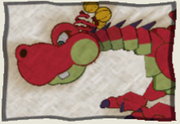 Hooktail |
20 (recovers 10 after revival) | 5 | 1 | Hooktail Castle | 99 |
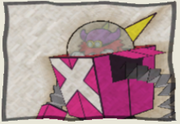 Magnus von Grapple |
30 | 2 | 1 | The Great Tree | 117 |
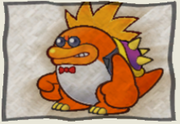 Macho Grubba |
60 | 4 | 0 | Glitz Pit | 103 |
 Doopliss (second encounter) |
40 | 4 | 0 | Twilight Trail Creepy Steeple |
104 |
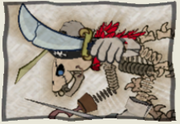 Cortez |
60 | 4 | 1 | Pirate's Grotto | 105 |
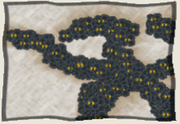 Smorg |
50 | 5 (miasma), 10 (pincher) | 1 (miasma), 0 (body) | Excess Express | 106 |
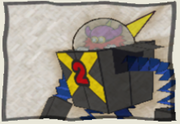 Magnus von Grapple 2.0 |
70 | 6 | 2 | X-Naut Fortress | 118 |
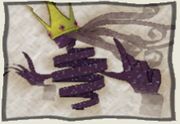 Shadow Queen |
150 | 7 | 0 | Palace of Shadow (in the room with a coffin) |
124 |
| 150 | 7 | 1 |
Mini-bosses
| Enemy | Heart Points | Attack | Defense | Location | Position in the Tattle Log |
|---|---|---|---|---|---|
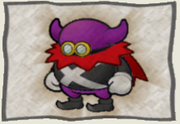 Lord Crump |
5 | 1 | 0 | Rogueport (after the player arrives) |
119 |
| 30 (both phases) | 3 | 0 | Keelhaul Key | ||
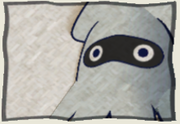 Blooper |
12 | 1 | 0 | Rogueport Sewers | 98 |
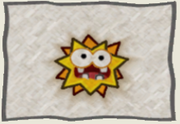 Gold Fuzzy |
10 | 1 | 0 | Shhwonk Fortress | 51 |
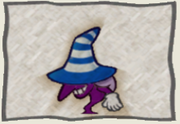 Beldam |
9 | 1 | 0 | Boggly Woods | 121 |
| 30 | 5 | 0 | Palace of Shadow (after exiting the Riddle Tower) | ||
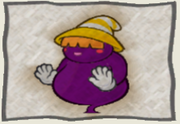 Marilyn |
12 | 2 | 0 | Boggly Woods | 122 |
| 40 | 7 | 0 | Palace of Shadow (after exiting the Riddle Tower) | ||
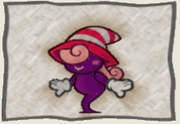 Vivian |
10 | 1 | 0 | Boggly Woods | 123 |
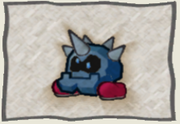 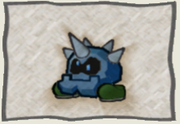 Armored Harriers (two Iron Clefts) |
6 | 4 | ??? (immune to every attack except Yoshi's Gulp) | Glitz Pit | 80 (red); 81 (green) |
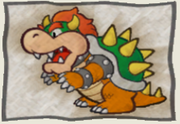 Bowser |
30 | 3 | 1 | Glitz Pit (after achieving the 5th rank) |
41 |
| 70 | 7 | 2 | Palace of Shadow (appears after defeating Sir Grodus) | ||
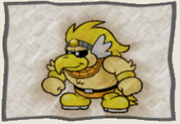 Rawk Hawk |
40 | 4 | 0 | Glitz Pit (after achieving the 1st rank) |
102 |
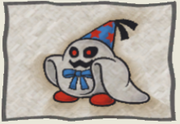 Doopliss |
40 | 4 | 0 | Creepy Steeple (appears under the name ???) |
104 |
| 40 | 6 | 0 | Palace of Shadow (after exiting the Riddle Tower) | ||
 Gloomtail |
80 | 8 | 2 | Palace of Shadow (fought in a room above the throne) |
100 |
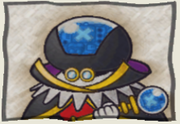 Sir Grodus |
50 | 7 | 1 | Palace of Shadow (fought in a throne room) |
120 |
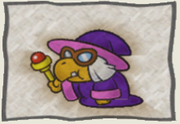 Kammy Koopa |
50 | 5 | 0 | Palace of Shadow (appears after defeating Sir Grodus and fought alongside Bowser) |
40 |
Optional bosses
| Enemy | Heart Points | Attack | Defense | Location | Position in the Tattle Log |
|---|---|---|---|---|---|
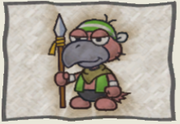 Gus |
20 | 3 | 0 | Rogueport | 42 |
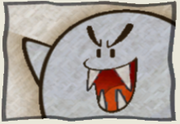 Atomic Boo |
40 | 4 | 0 | Creepy Steeple | 72 |
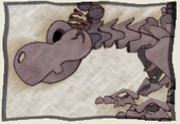 Bonetail |
200 | 8 | 2 | Pit of 100 Trials (100th floor) |
101 |
Flunkies
| Enemy | Heart Points | Attack | Defense | Fight with | Position in the Tattle Log |
|---|---|---|---|---|---|
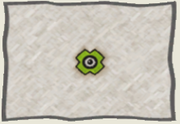 Grodus X |
3 | 4 | 0 | Sir Grodus | 119 |
Hidden block locations
In Paper Mario: The Thousand-Year Door, Mario can discover hidden ? Blocks throughout the game. Ms. Mowz is helpful in discovering them. There are 15 invisible ? Blocks in the game.
Selling prices
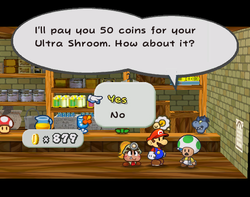
In Paper Mario: The Thousand-Year Door, Mario can sell items from his inventory to shopkeepers in the item shops in the game. Most items can be sold to the shopkeepers for a set price at every shop, however, some items sell at a higher price depending on the location of the shop and the item itself. Mario can make a profit if he purchases an item at a low price from one store, and sells it to another that buys it from him at a higher price. One Trouble Center trouble exploits this fact.
Side activities
Star Pieces
During the adventure, Mario and co. can collect Star Pieces by finding them in hidden spots, underneath chambers which he can use the Spin Jump to reveal, and earning them from other characters. Ms. Mowz is useful in finding the overworld Star Pieces. Mario can then trade them with Dazzle for Badges. There are 100 Star Pieces in the game.
Trouble Center
- Main article: Trouble Center
In Rogueport, there is a Trouble Center which offers the citizens' troubles for Mario to solve. An anonymous quest comes from Ms. Mowz and requires Mario to find a badge she is looking for but can not find. After this quest is completed, she joins Mario's team.
Zess T. recipes
- Main article: List of Zess T. recipes
Mario first breaks her contact lens in the Prologue. After Chapter 2, Mario bought her a new one, and she returned home. Mario can ask her to cook something. After completing her Trouble Center trouble, she is able to cook two items at once.
The Pit of 100 Trials
The Pit of 100 Trials is an optional challenge. Before or after saving the world, Mario can take on the enemies found in the 100-basement floor area known as the Pit of 100 Trials. The enemies located on levels 51-99 are especially strong. Upon reaching floor 100, Mario discovers Bonetail, the long-lost relative of Hooktail and Gloomtail. After defeating Bonetail, Mario receives the Return Postage Badge.
Similarities to Paper Mario
There are many similarities between the original Paper Mario and Paper Mario: The Thousand-Year Door, including these elements:
- The opening is identical to that of the previous game, right down to Parakarry delivering a letter from Princess Peach.
- The first partner of both games is a Goomba that gives Mario hints on both enemies and the area. They both have headbonk, tattle, and multi-bonk as attacks.
- The second partner of both games is a Koopa Troopa. Both are able to be shot out to hit switches, etc. Both of them are also able to use Shell Toss and Power Shell in battle.
- Both games have partners obtained in Chapter 3 that have first and last attacks that deal multiple low power hits. Bow with her Fan attacks and Yoshi Kid with his ground pound and Stampede attacks.
- The fourth partner of each game allows the player to travel across gaps, Parakarry and Yoshi, respectively.
- Both games have a Bob-omb as a partner, both are able to destroy cracked surfaces, Bombette and Bobbery, respectively.
- The fifth partner of both games allows Mario to become invisible to enemies, Bow and Vivian, respectively.
- Both games have a partner who is able to uncover hidden items, and whose basic attack pierces through defense, Watt and Ms. Mowz, respectively.
- Both games have a partner who has betrayed an enemy to join Mario's party, Lakilester and Vivian, respectively.
- Both games have a partner who lets Mario to ride them to move faster, Lakilester and Yoshi, respectively.
- Both games have some way to let Mario traverse through water, the partner Sushie and Boat Mode, respectively. Additionally, both are only available when stepped on a specific panel.
- The main plot point of both games is to find seven star-shaped entities, each granting Mario special abilities.
- Both games have an upgrade system for Mario's Jump and Hammer attacks.
- In both games the player is able to play as Peach between chapters. The player is required to dress Peach up as an enemy to learn secrets. Also, the player can cook something in both games. In Paper Mario: The Thousand-Year Door, Bowser's side-quest is separated from Peach's, as he is not the one who kidnapped her.
- As with the first Paper Mario game, a main antagonist sees Peach disguised as a minion, and remarks on how she smells "too nice".
- Mario and Peach contact each other using friendly characters in both games. Twink helped in Paper Mario and TEC-XX in The Thousand-Year Door. In the end, both Twink and TEC develop feelings for Peach (despite of the latter is actually an AI).
- Mario must solve a mystery in both games. A Bumpty is Mario's fellow detective in both.
- At one point in the games, Mario falls for a ploy created by the boss of the level which led him to be confined in a cage alongside several other prisoners. A ? block in Paper Mario, and a fake puni pedestal in The Thousand-Year Door.
- Chapter 1 in both games features a castle/fortress as the location of the boss, with both being located in peaceful, green plains. Additionally, both bosses are revered by denizens of the local town (Koopa Village and Petalburg, respectively, which are both largely inhabited by Koopas). Both towns feature a distinctive, elderly Koopa (Kroop and Koopa Koot, respectively).
- The partner acquired in Chapter 2 in both games required Mario to bring them an item.
- An oversized Clubba is the boss of Chapter 3 in both games, and both have a secret that involves making themselves powerful. Both are sought after by persistent female characters interested in finding lost persons (Bow and Jolene, respectively). Additionally, both Clubba characters have positioned security units to guard certain areas (Sentinels and Glitz Pit Security respectively).
- In both games, at one point, Mario has to chase the Chapter 3 bosses (Grubba and Tubba's Heart).
- Chapter 4 in both games involves Mario accessing the storage room of a certain shop to make progress. It also involves widespread (and comical) mischief in a town; for Paper Mario, it is the Shy Guy frenzy that takes place. For Paper Mario: The Thousand-Year Door, the denizens of Twilight Town are being turned into pigs at the toll of a bell.
- Moustafa and Flavio both give the player stones needed to reach an ancient, rumored to be haunted, place. Also both of the ghost bosses (Tutankoopa and Cortez) try to intimidate Mario by uttering threats as he progresses through the level.
- Buying a Dried Shroom and another certain item along with it was a secret sign in both games that was required to reach Moustafa and Don Pianta, respectively.
- Chapter 5 takes place on a tropical island with coconuts in both games and both involve an expedition. Also, in both games this is when Mario's oldest partner joins him, and they both have to be rescued from being stuck in a tree before they do so.
- The Chapter 5 bosses, Lava Piranha and Cortez, are similar as Cortez's spine in his first form and Lava Piranha's stem are in the exact same position, and both of them have multiple forms, each with the same amount of HP. They are also accompanied by multiple entities, each with their own mechanics, attacks, and HP.
- In both games, Princess Peach must make something. Also, in both games, if she makes a mistake in the directions of making it, it comes out wrong (making a cake for Gourmet Guy and making the invisibility potion)
- After the battle against Cortez is over, one of the Toad sailors tells everyone that he feels a "slight wind" coming from the cracked wall, just as Misstar did in the first one. The Bob-omb partner of both games is needed to blow that up. Also, the most frequently fought boss of both games (Jr. Troopa and Crump, respectively) conveniently show up after Chapter 5 is completed.
- Chapter 6 takes place in a beautiful area and has a boss that can do a very high amount of damage when charged up: 16 for Huff N. Puff, 10 for Smorg. Also, both are blob-shaped and made up of a smaller species. Additionally, Ruff Puffs appear in the sixth chapter of both games.
- Chapter 7 features a snowy region.
- Chapter 8 includes a battle against Bowser before the final battle. Also, Kammy Koopa is fought in both chapters.
- Both games contain puzzles in some places that are solved identically or similarly.
- The Riddle Tower has many puzzles from Crystal Palace, including walking through or blowing up seemingly solid walls.
- The Palace of Shadow has puzzles and traps from Bowser's Castle, including an area wherein Mario only makes progress by following a pattern (though this is actually taken from the final castle level in Super Mario Bros.)
- Both dungeons in the final chapters have rooms with stairs where Mario has to defeat B. Bill Blasters to reach the next level.
- The main villain of both games (which have kidnapped Peach) had to be chased through long stairways in the eighth chapter of both games.
- Mario's final battle is divided into multiple parts. At one point, each boss is invincible and Peach plays an integral role in negating that invincibility.
- Peach conveniently gets taken away in both games right before Mario and company reach the hideaways of the games' main antagonists.
- In both games, there is a scene where Mario can turn into 8-bit Mario with Super Mario Bros. level 1-1 music playing.
- Both games have Merlon standing outside his house, waiting for Mario and his partners to show up, where he tells them about a dream that he had, and tells them to let him know if they find out the meaning of it. Afterwards, an item that is placed at the top of Merlon's house is revealed.
- Both games have a spike room where Bow's Outta Sight or Vivian's Veil must be used, and the position of the paths across the spikes are identical.
- Both games feature a boss who poses a threat by eating people (Tubba Blubba and Hooktail), and both of these bosses have a secret weakness.
- Both games include a test during the Chapter 5 interlude that Princess Peach has to take and has information that helps Mario in the future.
- Both games end with a parade led by Luigi (though in Paper Mario: The Thousand-Year Door it is not a traditional parade, and is mainly a line of all the character's silhouettes used as a way to show everyone).
- Both games' endings feature a scene in which Mario, after returning home from his travels, is shown hanging around with Luigi, having just told his brother the story of his adventure.
Quotes
- Main article: List of Paper Mario: The Thousand-Year Door quotes
- "Omigosh! Is… Isn't that a treasure map?! You HAVE to tell me where you got that!" - Goombella
- "And with that...pow! I'm gone!" - Lord Crump
- "Mmmmmmwee hee hee hee! I have no quarrel with you...but I simply can't allow you to hunt for the Crystal Stars." - Beldam
- "And then I, Grodus, will build a new world! A perfect, ideal world... Yes. A world made by me, about me, and for me! GAAACK ACK ACK ACK ACK!" - Sir Grodus
- "I'm... I'm sorry Sis. This Mario is the only person who's ever been kind to me..." - Vivian
Notable regional differences
Title theme
| File info |
| File info |
- The title theme was edited in international versions to flow smoother and make the drumroll more subtle than the Japanese version.
Technical changes
- There is no health warning screen when starting up the game in the Japanese version.
- There is no delay for when the player can press start on the title screen in the Japanese version.
- Holding
 when the player does not have the Ultra Boots prevents Mario from moving in the Japanese version.
when the player does not have the Ultra Boots prevents Mario from moving in the Japanese version. - On the Level Up screen, the cursor is set to FP by default in the Japanese version, while in the international versions, the player has to manually move the cursor to either HP or BP.
- In the Japanese version, Mario and his partners are fully healed at the end of Chapter 1, but at the end of all the other chapters, they do not get healed at all. In the international versions, Mario and his partners are fully healed at the end of each chapter except Chapter 8.[2]
- The international versions have more Stylish moves than the Japanese version. For example, there is no second Stylish after a normal jump in the Japanese version.
- Many of the items at the Pianta Parlor have different positioning in the menu in the Japanese version.
- The backtrace screen has some additional functionality in the international versions. In the international versions, the entire screen is used and also scrolls, while in the Japanese version only a part of the screen is used and it does not scroll.
- The international versions have a wider frame window when pulling out Action Commands.
- In the Pit of 100 Trials, when a player defeats an enemy, the pipes show up faster in the Japanese version.
- Koopook is moved to a different position (further to the left) in Hooktail Castle during his trouble in the Japanese version.
- Every enemy's stats stayed the same between all versions. However, the American version mistakenly claims that the Red Spike Top has 5 defense instead of 4, and that Rawk Hawk has 3 attack and 1 defense rather than 4 and 0, respectively. These mistakes were corrected in the European version.
- The English script mistakenly says the Zess Frappe and Icicle Pop restore 20 and 10 HP when they restore 20 and 15 FP in all versions, respectively.
- During pre-Chapter 5, Swindell the Bandit is moved to the far side of East Rogueport near the barrels. In the international versions, there is one less barrel, and Swindell's position is slightly altered.
- Giving Lumpy 200 coins early in the game leaves Mario with 500 coins later in the Japanese version and 600 coins later in international versions.
- All Fuzzies have horrible vision in the Japanese version, as they often do not even notice Mario when he goes by them. In the international versions, the Fuzzies have better vision and thus notice Mario more quickly. In addition, the Fuzzies move slower in the international versions.
- There is no slowdown when moving up slopes on rooftops with Yoshi in the Japanese version.
- At the end of Bowser's levels, fireworks are fired in the Japanese version but not in the international versions.
- In the original Japanese script and every other translation of the game, the final RDM email features an additional "hidden" section if the player scroll downs for an extended period of time. This portion was removed from the English translation, despite retaining the statement hinting at its existence.
Aesthetic changes
- Some items were redesigned in international versions:
- Super Luigi 5 is red instead of orange.
- The kanji on the Wrestling Mag is replaced with scribbles.
- The Power Rush badge has a different letter for every language.
- Vintage Red was renamed Chuckola Cola and recolored purple to resemble soda instead of wine.
- The Boos Peeka and Lahla wear bunny ears in the Japanese version, but cat ears in international versions to avoid resembling a bunny suit.
- TEC-XX's camera "eye" is blue instead of red in international versions to tone down similarities to the HAL 9000.
- Larson's Toad chalk outline and bloodstains in his house were removed from international versions to remove violent undertones.
- In the English and German scripts, Vivian is referred to with feminine pronouns and has no mention of being a male-to-female gender dysphoric.
- The Shadow Queen is slightly more formal and condescending in the English script.
- Before the battle against Shadow Queen, if Mario chooses to be her servant, after her spell has casted on Mario, Mario's sprite changes to the same as Doopliss's appearance when impersonating as him in the Japanese version, notably for the evil-looking appearance, and the effects from L Emblem and W Emblem are also removed (like how Doopliss's fake copy of Mario cannot change colors either). However, in the international version, Mario keeps the same angry pose before the spell, and his appearance and color remain unchanged.
- A few cutscenes involving flashing lights were edited down in the international versions, probably to reduce the chance of players getting epileptic seizures:
- The flashing lights during the first Shadow Queen cutscene were reduced.
- The flashing lights during the cutscene in the room that makes the Emerald Star appear were reduced.
- However, the animation for Showstopper, which despite being arguably worse than the two stated above, was not edited.
- PAL versions have additional differences from all NTSC versions. Only NTSC versions can be played in progressive scan mode, and only PAL versions can be played in 50Hz mode, using the same method to activate each. The American and Japanese versions have their languages locked to English and Japanese, respectively, while the PAL version can additionally be played in Spanish, French, Italian and German depending on the GameCube settings. Also, in NTSC versions, Mario has two different talking animations, one involving him raising his hand and one involving him moving his mouth, and each one is used in different scenarios. Only the "mouth moving" one is used in the PAL version, however, to avoid resemblance to the Nazi salute.
Pre-release and unused content
Reveal trailer
This game was initially titled Paper Mario 2 and featured a far different logo, one reminiscent of the original Paper Mario's logo.
Part of the original trailer shows an extra ledge above the pipe in the room directly east of the Thousand Year Door, with an HP Plus badge on it. It could be accessed via a moving platform which had a wall over it halfway, which appeared to be passable with help from Vivian. Also, Beldam and Doopliss were originally going to be fought somewhere in Riverside Station. The trailer also showed that Item Shops would be labeled with Mushrooms, much as in Super Paper Mario, rather than the Fire Flowers seen in the final game. Red Bones was initially named "Red Koopa Skeleton." In the same trailer, one can see that "Tornado Jump" was initially called "Hurrican Jump".[sic] The status element Slow had a different icon, a snail instead of a sad purple face.
An early location of the HP Plus Badge.
Hooktail Castle Notice how the final game, the door is just open from the start.
A battle in Hooktail's Castle. Notice Hurricane is spelled wrong.
Glitches
- Main article: List of Paper Mario: The Thousand-Year Door glitches
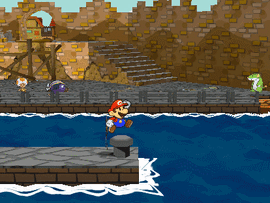
Koops splashing on Dry Land
At the dock of Rogueport, the player should stand on or near the bollard and use Koops's ability, holding ![]() so he remains in place. Without letting go of the button, the player should walk away so that Koops is offscreen, and talk to a character in the same area. When the player is done, Koops respawns next to Mario. There is a splash animation even on dry land. This glitch also works in Petalburg.
so he remains in place. Without letting go of the button, the player should walk away so that Koops is offscreen, and talk to a character in the same area. When the player is done, Koops respawns next to Mario. There is a splash animation even on dry land. This glitch also works in Petalburg.
Staff
- Main article: List of Paper Mario: The Thousand-Year Door staff
Intelligent Systems developed the game with Nintendo publishing it. The music is credited to Yoshito Hirano and Yuka Tsujiyoko.
Reception
Overall, Paper Mario: The Thousand-Year Door received very positive reviews from critics, who praised its nuanced story, characters, and humor, in addition to its battling system, multiple side-quests, and soundtrack.
In 2019, a petition on Change.org was started to get Paper Mario: The Thousand-Year Door remade in HD.[3]
| Reviews | |||
|---|---|---|---|
| Release | Reviewer, Publication | Score | Comment |
| Nintendo GameCube | Peer Schneider, IGN |
9.1/10 | With Mario & Luigi: Superstar Saga finished and stashed away, I was ready for another opportunity to venture into Mario's RPG realm. While there's plenty of room for better presentation (Paper Mario Revolution, anyone), this game is an absolute blast to play. Get past the slow-moving first chapter and some clunky NPC path finding routines in chapter 2 and you'll be hooked. The story is funny, the gameplay varied, and the world so charming, you'll want to explore every last corner of it. Add to that plenty of playable characters and sidekicks, some great cameos, a memorable score loaded with classic melodies, and a quest that runs a good 30 hours long, and you've got another winning offshoot in the mighty Mario franchise.Paper Mario: The Thousand-Year Door improves on its predecessor in every way and takes the cake as the best Mario RPG yet. Highly recommended. |
| Nintendo GameCube | Jeremy Parish, 1UP |
8.5/10 | Paper Mario 2 is clearly a game for fans, created by people with genuine affection for the Mario legacy...it's a testament to the diversity of the medium that in a season marked by realistic, violent and often grim video games like GTA, Halo 2 and Def Jam: FFNY, a game like Paper Mario can be so willfully charming, harmless and child-friendly in appearance and still make for a compelling, sophisticated experience. It's a must-have for Mario nuts, and is worth a look for everyone else. With its simple, brilliant graphics, impressive sound design and laid-back but addictive gameplay, Paper Mario 2 is an excellent sequel -- and a great game in its own right. |
| Nintendo GameCube | Tom Bramwell, Eurogamer |
9/10 | Of course, you've long since realised how this was going to end. But we're trying. We're trying to put ourselves in the minds of people who would treat this game with prejudice and toss it back in our laps and say "No thanks", or just turn up on the comments thread and tell us it's crap, but quite honestly you would have to actually hate Mario, or Nintendo, in order for this not to entertain you. Whether you think you like role-playing games or not. Fair enough, if Mario has stolen your girlfriend, keyed your car, broken the lead in your pencil and signed you up to the Britannia Music Club, we don't expect you to buy this. But the only things we can say against it are specialised nit-pickings. We were honestly going to mention this one occasion when we had to redo something relatively straightforward five times due to our own cackhandedness. That's about as bad as it got for us. Otherwise our only feelings of concern stemmed from our fear that we might not get far enough in quick enough time to be able to tell you with any authority whether Paper Mario: The Thousand-Year Door is every bit as good as Intelligent Systems could make it. Well, we did, so we can. And it is. |
| Nintendo GameCube | Miguel Lopez, Gamespy |
4/5 | If I had to fault Paper Mario: The Thousand-Year Door on something, it would be its reliance on backtracking. You have to do a frightful amount of it in most of the scenarios. At best, doing so allows you to access spots in previous areas that you perhaps weren't able to before. At worst? You'll have to perform some tricky platforming one time more than you feel you should. But in the end, this is what the games that inform its design are like, so I guess we have to take the good with the bad. And when it comes to Paper Mario: The Thousand-Year Door, it's mostly all good. If you have a history of playing 2D side-scrollers, this game will make you remember just why you loved them. And if you have a soul, then this game will make it feel all warm and fuzzy. |
| Aggregators | |||
| Compiler | Platform / Score | ||
| Metacritic | 87 | ||
| GameRankings | 88.05% | ||
Gallery
- For this subject's image gallery, see Gallery:Paper Mario: The Thousand-Year Door.
Media
- For a complete list of media for this subject, see Paper Mario: The Thousand-Year Door.
| File info 0:44 |
| File info 0:30 |
| File info 0:30 |
References to other games
- Donkey Kong: One of the badges is named "Jumpman", referencing to how Mario was alternatively named in this game. In addition, although not in the game itself, the Official Nintendo Power Player's Guide alluded to Mario's encounters with the titular ape from the game where they mentioned that the X-Nauts thought they could dissuade Mario with various platforms at high places, but they had not heard of his exploits against "a certain ape."
- Super Mario Bros.: At the X-Naut Fortress in the Changing Room, Mario and Co. can change into an 8-bit sprite of themselves, along with the Super Mario Bros. music playing in the background. Hamma also mentioned that his grandfather was at World 7-1. Bowser's gameplay is also a direct parody of this game. In the Japanese and French versions of the game, the video-game obsessed Toad from Petalburg refers to Super Mario Bros as his favorite game for the Famicom and Nintendo Entertainment System, respectively, also urging Mario to play it in the latter version.
- Famicom Disk System boot up: During the Peach transition scene for Chapter 5, when Peach is invisible and retrieves a disc from Grodus's office, the computer screen displays a scene of Mario and Luigi fighting over a light switch, referring to the boot up screen for the Famicom Disk System if the player did not input a disk beforehand.
- Super Mario Bros. 3: The Grass Land theme is arranged as part of the music that plays during the opening cutscene. Whenever Jolene (while under the alias of "X") sent Mario an e-mail, the Ice Land map screen theme would play. The music that plays when Mario is riding the blimp is a cover of the athletic theme from this game. This game also included Boomerang Bros., Fire Bros., and Boos, which originated from this game. Also, the "king saved" music can be heard in Luigi's story telling theme. Also like Super Mario Bros. 3, the game's story is implied to be a stage play (although it is more direct than in the former game, as it was only stated by Shigeru Miyamoto in the former case). In addition, Peach after each chapter ends up sending (e-)mail to Mario with advice for the next level, with her final mail upon completing all objectives being intercepted by the main villain, similar to in Super Mario Bros. 3. Bowser's theme song contains a cover of the castle theme.
- Super Mario World: Whenever Peach sends Mario an e-mail, the title screen theme would play. Whenever Mario gets an e-mail from other people, part of the epilogue theme (from when a Koopaling castle is beaten) plays. When Mario wins a battle, the "level clear" sound plays.
- Super Mario World 2: Yoshi's Island: Blue Bandits appear as NPCs. Atomic Boo closley resembles Bigger Boo from this game.
- Super Mario 64: In the first Princess Peach interlude, Peach is singing the Inside the Castle Walls theme from this game when she is in the shower.
- Paper Mario: Parakarry makes a brief cameo at the beginning of the game, and delivers a letter to Mario from Peach, just like the previous game. Lady Bow also makes a cameo appearance, and makes a direct reference to Boo's Mansion, as well as the adventure they had. There is also a random Toad at the Excess Express (after Chapter 6 is completed) that asks Mario a quiz question, ("What did Bowser steal in the first Paper Mario?"), and the answer is, "Star Rod". The video game-obsessed Toad kid from Petalburg also mentions that he has been playing the game, describing Bow as the "cutest Boo of ALL TIME!!!" Jr. Troopa also appears in the background in the picture that Zip Toad attached to his e-mail. Gulpits are also given a reference when Grubba exclaims, "GREAT-GALLOPIN' GULPITS!". A Ratooey at Rogueport Harbor who went on a quest for oil in Dry Dry Desert can tell Mario about this adventures at the end of the game. Every part is a chapter of Paper Mario game. In the email he sends to Mario after finding him, Koopook says he is now hiding in Crystal Palace in the Japanese version; however, this last reference is lost in the English translation, as Crystal Palace is instead translated as "Goomstar Temple". Kolorado was a student of Professor Frankly, and the former's deceased father appears as a crumpled Dull Bones in Hooktail's Castle, which Koops confuses for his own father. One of the houses in Poshley Heights has a model of the K64.
- Mario Kart: During one of Luigi's stories, he tells Mario he had to sign up for a Kart race, and mentions he had driven karts before, giving reference to the Mario Kart series.
- Luigi's Mansion: A crow in Twilight Town says he will set up an estate pay site named Luigi's Mansion, and his crow friend says that "he's heard that name somewhere before", referencing this game.
- Super Smash Bros. Melee: In the Spanish version of the game, Rawk Hawk's victory gloat after beating The Koopinator specifically referenced Super Smash Bros. Melee (in all other versions, he simply says they are better off playing video games without naming one in particular).
- Super Mario Sunshine: Toadsworth, Piantas, and Shine Sprites appear in the game to upgrade Mario's partners. The parrot in Creepy Steeple randomly says the infamous translation of "Shine get!".
- Mario & Luigi: Superstar Saga: Chuckola Cola is an item in this game, referring to the game it has been appeared first. The "Super-Guarding" ability was likely inspired by the ability to counter enemies' attacks in Superstar Saga. Mario gaining field abilities to use in battle (Spin Jump, Spring Jump, Super/Ultra (spin) hammer) as special FP consuming attacks were also likely inspired by field abilities in Superstar Saga being used in battle as Bros. Attacks. One of Bowser's options during his conversation with Pennington during the Chapter 7 interlude is The Shadow Thief, a reference to Popple. The difference of the naming methods between the English and Japanese titles are similar to this game, as the English titles of both games have a subtitle under the series names (Mario & Luigi and Paper Mario respectively), while the Japanese titles simply have the term "RPG" under the series names.
References in later games
- Super Paper Mario: This game is alluded to by a video game-obsessed Toad in Petalburg. At the end of the game, he states that he has been playing "the new Paper Mario game" called Super Paper Mario, which was released in 2007 for the Wii, and that it will be pleasing to fans of Luigi, which hints that the game was already in production and/or planning stages at the time Paper Mario: The Thousand-Year Door was in development. All seven partners from Paper Mario: The Thousand-Year Door make cameo appearances as Catch Cards that are won by completing the Duel of 100 at Sammer's Kingdom. Francis also has plush toys of the Yoshi (in all colors), Vivian, Bobbery, and Pennington, along with a poster of Petuni. In Francis' list of things to buy, Rawk Hawk was given a reference when he stated that he wants a DVD called, "Harder than Bedrawk: The Rawk Hawk Story". Francis also stated that he wants a Ms. Mowz doll with "real-smooching action", an Excess Express train set, and a Magnus Von Grapple action figure. Francis also happens to watch "Starship X-Naut" and "The Grodus Chronicles". Also, Fracktail and Wracktail, themselves are homages to Hooktail and Bonetail. Additonally, there is also a Sammer Guy who calls himself "Laughing X-Naut" and another who calls himself "The Thousand Year Roar". Lastly, Slim's ability to make Mario, Peach, Bowser, or Luigi thin is a reference to the second curse in Paper Mario: The Thousand-Year Door.
- Super Smash Bros. Brawl: Goombella, Mini-Yoshi, Vivian, and Rawk Hawk appear as Stickers. Goombella also has her own trophy. Also, the words, "CRUMP" and "RAWK" appear in the random name selection, which are possible references to Lord Crump and Rawk Hawk.
- Paper Mario: Sticker Star: In the level Shy Guy Jungle, there is a pile of garbage with many letters, one letter is written by Goombella and it states: "Observations on the Ancient Civilization of the Chomp Ruins."
- Super Smash Bros. for Nintendo 3DS: The S.S. Flavion appears as a variation of a Paper Mario stage in this game. A Big Blooper based on the boss also appears in the stage variation's background. An arrangement of the Rogueport theme is also part of the stage's main song.
- Super Mario 3D World: The Fuzzy Horde, which debuted in this game, returns in several levels.
- Mario & Luigi: Paper Jam: Paper Mario's Airplane and Paper Modes return. During Trio Grab, Paper Mario turns into a tube, similar to Tube Mode. He can also turn into a paper drill during Trio Drill, which is similar in concept to the paper abilities from this game. When Paper Mario meets the Mario Bros., he performs a Spring Jump. Paper Mario borrows his blocking and KO'd animations from this game. The trio gains Star Points by performing Action Commands correctly, which is similar to how Paper Mario and his partners had to appeal to the audience by doing the same thing, and by also being stylish. The stage where Mario, Luigi and Paper Mario stand when they level up is similar to the stage from this game's battles, down to the yellow stripes on the curtains.
- Paper Mario: Color Splash: Peach summons Mario over to the current destination due to a discovery she made (although in this case Peach personally has Mario come along). Peach also ended up abducted shortly after bringing Mario along (although in that case, Mario does witness Peach's abduction). She also sends mail giving some hints about the main villain's plan and the next destination that Mario should head towards in the form of Holo-Peaches, and her last mail has Peach's message being cut off by the main antagonist (Black Bowser) just as Peach was about to give key details about his villainous plan. In addition, a character gets possessed by a grave evil (in this case, Bowser via Black Paint, while in Paper Mario: The Thousand-Year Door, it was Peach who was possessed by the Shadow Queen). Also, the Big Paint Stars serve a similar function to the Crystal Stars.
- Paper Mario: The Origami King: Peach's design from The Thousand-Year Door appears as a photo. Additionally, when Mario and Bob-omb interact with the steering wheel on the Princess Peach, the latter mentions that he dreams of being an admiral someday, in reference to Admiral Bobbery.
Names in other languages
| Language | Name | Meaning |
|---|---|---|
| Japanese | ペーパーマリオRPG Pēpā Mario Āru Pī Jī |
Paper Mario RPG This naming method is similar to Super Mario RPG and the Japanese name of Mario & Luigi: Superstar Saga. |
| Chinese (traditional) | 紙片瑪利歐RPG[4] Zhǐpiàn Mǎlì'ōu RPG |
Paper Mario RPG |
| French | Paper Mario: La Porte Millénaire |
Paper Mario: The Millennium Door |
| German | Paper Mario: Die Legende vom Äonentor |
Paper Mario: The Legend of the Aeon Gate |
| Italian | Paper Mario: Il Portale Millenario |
Paper Mario: The Millennium Portal |
| Spanish | Paper Mario: La Puerta Milenaria |
Paper Mario: The Millennium Door |
External links
References
- ^ Release dates from TMK, retrieved 7-22-2008
- ^ Paper Mario RTA Wiki
- ^ Paper Mario: The Thousand Year Door Fans Collectively Begin Asking Nintendo for a Remaster. Retrieved December 26, 2020.
- ^ Official Chinese website for the Super Mario Bros. 35th Anniversary. Retrieved October 23, 2020.
{{PMTTYD}}
{{Mario games}}
{{GCN}}
[[de:Paper Mario: Die Legende vom Äonentor]]
[[it:Paper Mario: Il Portale Millenario]]
[[Category:Paper Mario: The Thousand-Year Door|*]]
[[Category:Games]]
[[Category:Nintendo GameCube games]]
[[Category:Role-playing games]]
[[Category:Player's Choice]]
[[Category:2004 games]]
work done:
a new header: yes, but no
plot: nothing changed at all
gp: mostly, the objects are waiting
party members: gg
action: wip as well
enemies: yes, but idk how it will be replaced then
gear & badges: work for 15 minutes. idk how i havent done it already but its better late than never ig
side activities: it is the nicest
services: duh
reception, music, version changes, etc...: rip
